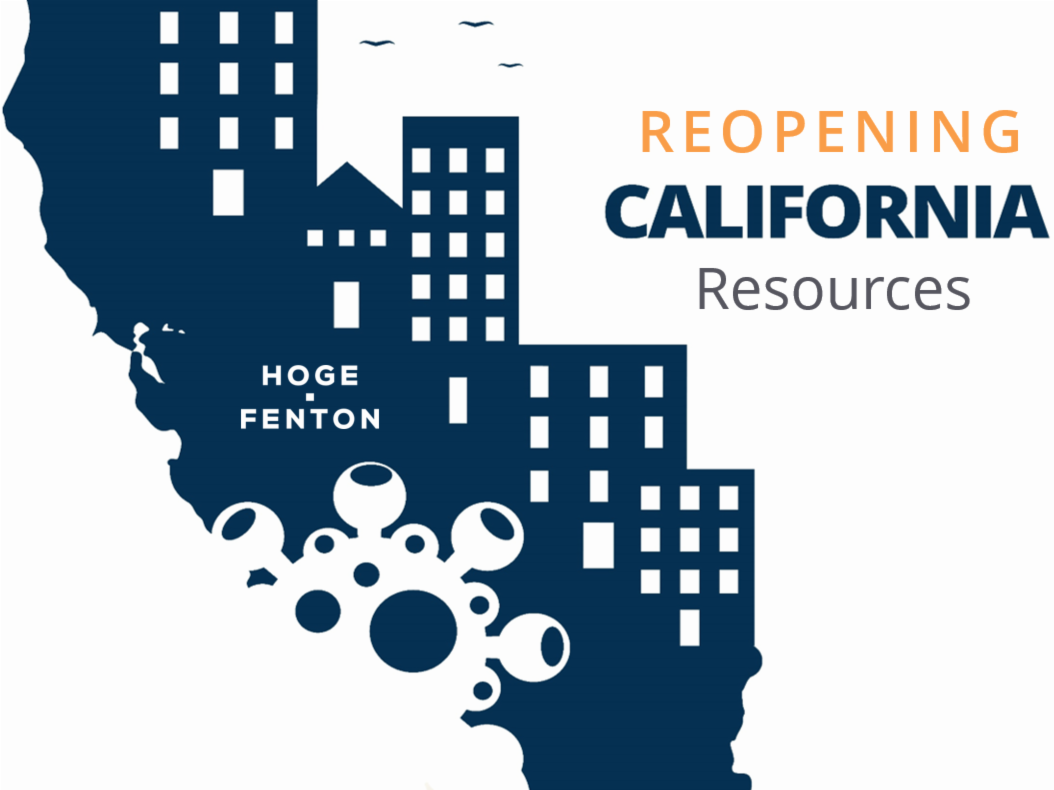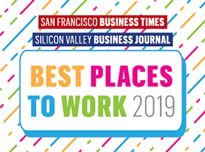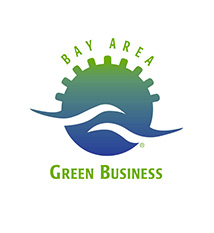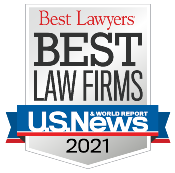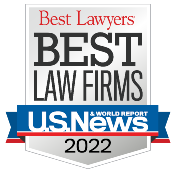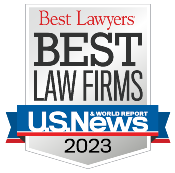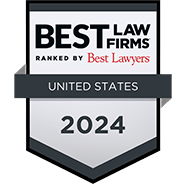02.17.2022 | Firm Post
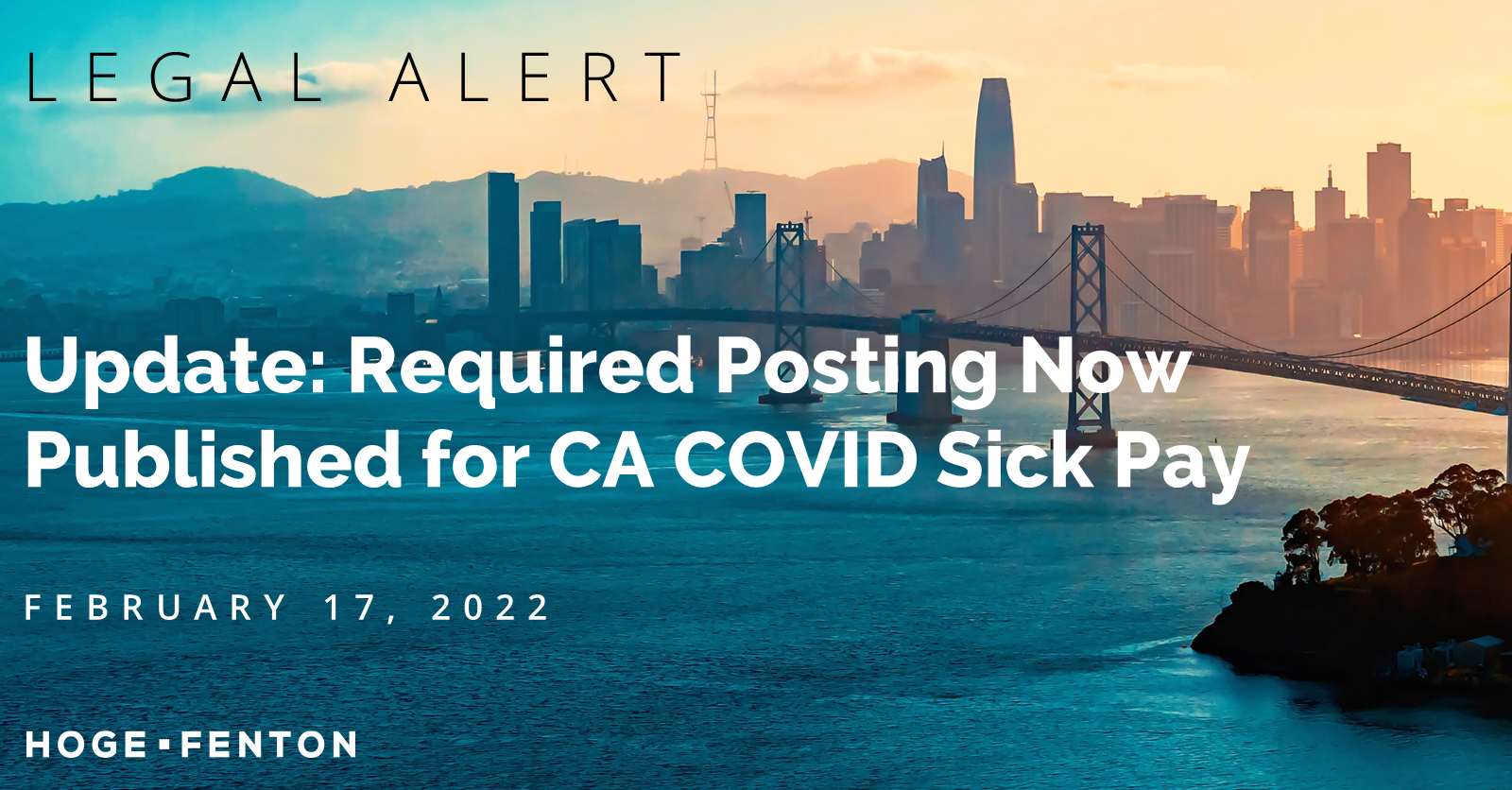
As a follow-up to Hoge Fenton’s February 11, 2022 article regarding the return of California COVID-19 Supplemental Paid Sick Leave, the State has now published a required notice for employers to post in the workplace and to email to remote employees.
The notice can be found here, and it is also available in Spanish here.
The new COVID sick pay law requires all covered employers (those with 26 or more employees) to post this notice and email it to remote employees, by February 19, 2022.
Our Employment Law Group has extensive experience advising employers on California’s SPSL laws and other issues pertaining to the COVID-19 pandemic. For more information and to contact Hoge Fenton’s Employment Law Group, click here.
02.11.2022 | Firm Post
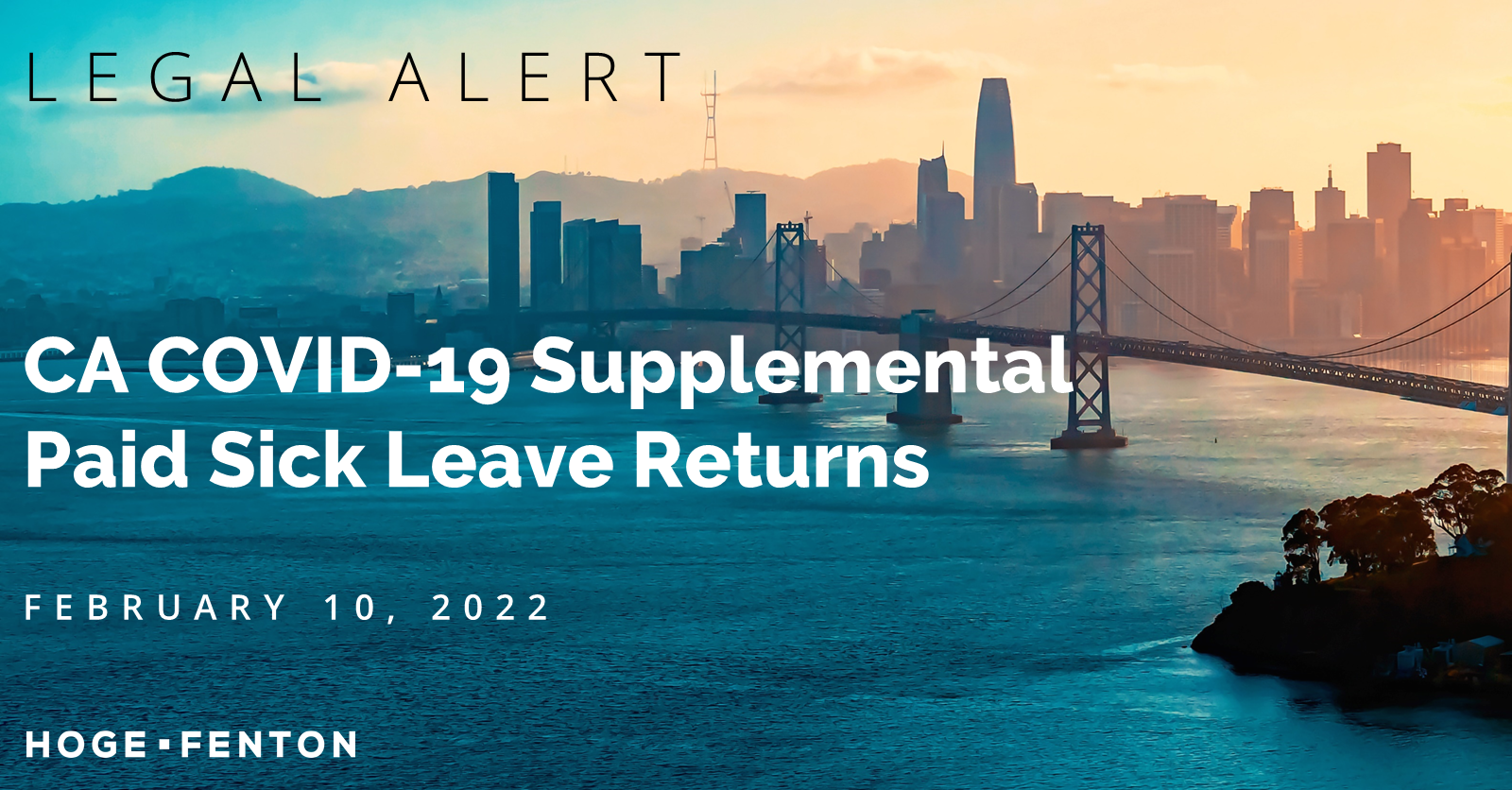
On February 9, 2022, Governor Gavin Newsom revived California’s COVID-19 Supplemental Paid Sick Leave (“SPSL”). Employers may recall that California had a similar law last year, but it expired in September 2021. This new SPSL law goes into effect on February 19, 2022, but it will be applied retroactively to January 1, 2022, and it will expire on September 30, 2022.
Covered Employers
SPSL applies to employers with 26 or more employees.
Covered Employees
SPSL applies to employees who are unable to work or telework due to one of the qualifying reasons listed below.
Qualifying Reasons For SPSL
A covered employee is entitled to 40 hours of SPSL if they are:
- Subject to quarantine or isolation due to COVID-19 as defined by an order or guidance of the CDPH, CDC, or a local public health officer. If the employee is subject to more than one order or guidance, the employee is allowed to use SPSL for the minimum quarantine or isolation period under the order or guidance that provides for the longest minimum period; or
- Advised by a health care provider to isolate or quarantine due to COVID-19; or
- Attending a COVID-19 vaccine or vaccine booster appointment for themselves or a family member (employers can limit this to 24 hours unless the employee provides medical documentation that the employee or family member is still experiencing symptoms related to the vaccine or booster); or
- Experiencing COVID-19 symptoms; or
- Caring for a family member experiencing symptoms, related to a COVID-19 vaccine or vaccine booster; or
- Caring for a family member who is subject to an order or guidance, or is required to isolate or quarantine as described above;
- Caring for a child, whose school or place of care is closed or otherwise unavailable for reasons related to COVID-19 on the premises.
A covered employee is entitled to an additional 40 hours of SPSL if the employee, or a family member for whom the employee is providing care, tests positive for COVID-19. The employer can require proof of a positive test.
Calculation of Leave Amount Based on Work Hours
Employees who work full time or were scheduled to work, on average, at least 40 hours per week in the 2 weeks prior to taking SPSL, are entitled to up to 80 hours of paid time off. Employees who work fewer or variable hours are subject to a different calculation that is based on the number of hours they typically work. Employers should contact legal counsel for guidance on how to calculate SPSL for employees who are part-time or work variable hours.
Retroactive Application and Credit
If, prior to the SPSL going into effect, the employer already paid employees an amount equal to or greater than the amount employees would have been entitled if SPSL was in existence as of January 1, 2022, then upon request of an employee, the employee can be credited for any leave hours used for COVID-specific leave purposes, and the employer can be credited for providing those hours pursuant to SPSL.
If the employer did not already pay employees an amount equal to or greater than the amount employees would have been entitled if SPSL was in existence as of January 1, 2022, then upon request of an employee, the employer must provide the employee a retroactive payment for the SPSL.
No Overlap With Cal/OSHA Exclusion Pay
SPSL is separate from exclusion pay required under Cal/OSHA’s Emergency Temporary Standards (ETS) for employees exposed to COVID-19 in the workplace. Therefore, the SPSL law does not credit employers for exclusion pay that is required by the ETS. Further, employers cannot require employees to exhaust SPSL before receiving exclusion pay under the ETS.
SPSL Maximum Pay
The amount of required SPSL pay is capped at $511 per day and $5,110 total per employee unless these amounts are increased by federal law (which is not currently expected)
SPSL Takes Priority Over Other Leaves
Employers cannot require employees to use any other type of leave before requesting SPSL, including, but not limited to, California Paid Sick Leave.
Requirement to Identify SPSL Usage on Wage Statements
Employers must list the amount of SPSL that has been used on employees’ paystubs. If an employee has not yet used any leave, their wage statement must reflect that “0” hours have been used.
Requirement to Provide Written Notice to Employees
Employers are required to post notice of employees’ SPSL rights. The Labor Commissioner intends to provide a sample notice within seven days of the enactment of the law – by February 16, 2022. Employers should provide the notice via email to remote employees.
Hoge Fenton’s Employment Law Group has extensive experience advising employers on California’s SPSL laws and other issues pertaining to the COVID-19 pandemic. For more information and to contact Hoge Fenton’s Employment Law Group, click here.
06.17.2021 | Firm Post
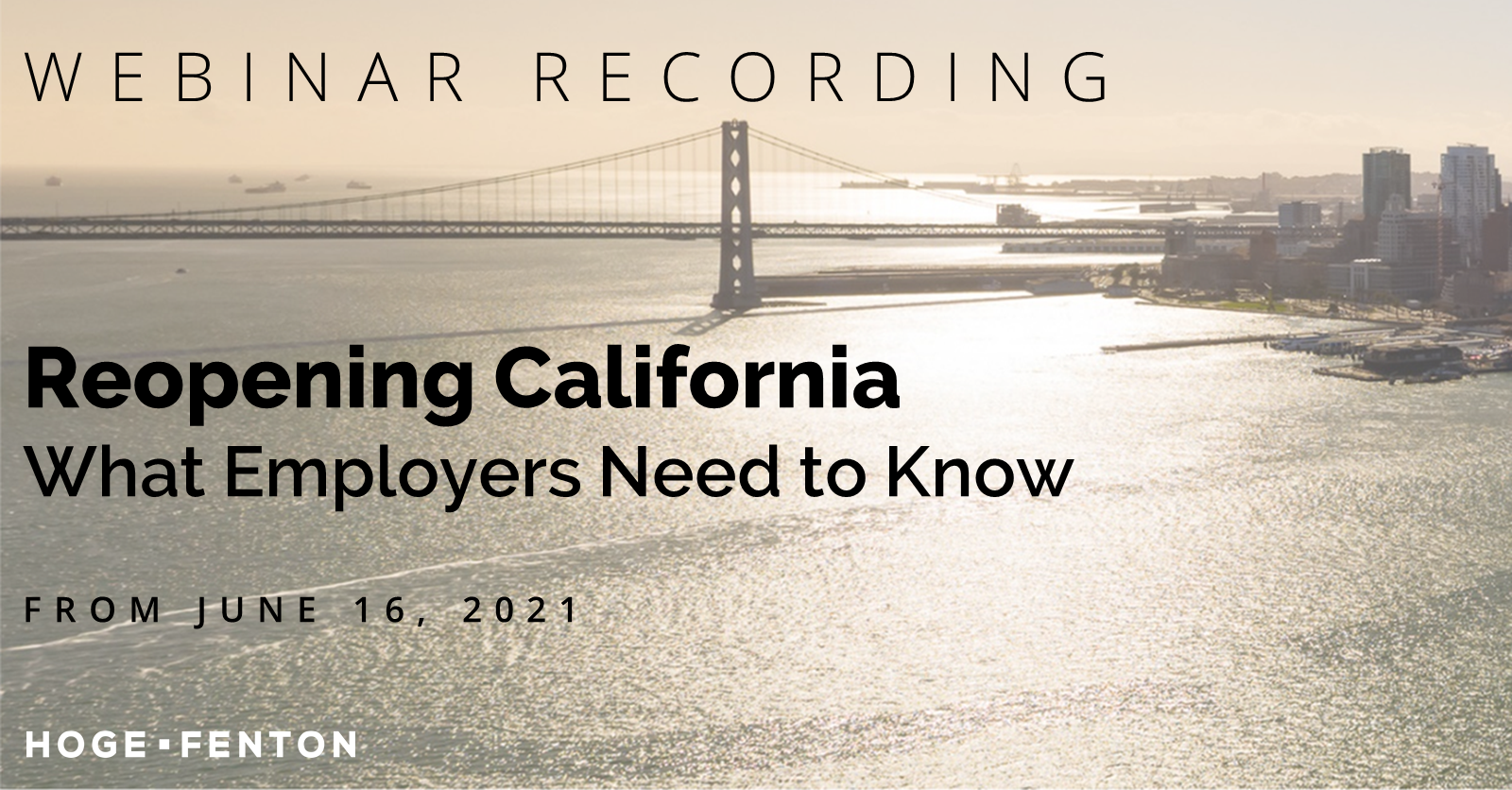
Thank you for joining us for our Reopening California – What Employers Need to Know webinar. Click below to view the webinar recording with Employment Law Attorneys Sarju Naran and Jenn Protas. A copy of the presentation can be downloaded here.
For more information or resources regarding COVID-related laws applicable to employers and/or employees, please refer to Hoge Fenton’s Employment Law Group’s resource page, or feel free to contact a member of the Employment Law Group.
Our Employment Law Team
 |
Sarju Naran is a zealous advocate for his clients and approaches litigation with creativity and strategy. Chair of Hoge Fenton’s Employment Law Group, Sarju’s experience spans from representing middle-market and family-owned closely held businesses to large multi-national companies. He regularly litigates and provides advice and counsel to companies on wage and hour issues, trade secret misappropriation, employee mobility, wrongful termination, performance management, and leaves of absence. |
 |
Jenn Protas helps employers navigate California’s numerous employment laws and defends employers with an eye toward successful, yet cost-effective resolution. Jenn is a committed advocate for her clients and a tenacious litigator. She defends employers on matters related to wage and hour law, wrongful termination, harassment, discrimination, and retaliation in single-plaintiff litigation, Private Attorney General Act actions, and/or class actions. Jenn’s practice also includes housing discrimination matters and business litigation. |
 |
Maysa Saeed is an associate attorney in Hoge Fenton’s Employment Law Practice Group. Her practice focuses on employment counseling and litigation and assists clients in all aspects of employment law. Prior to joining Hoge Fenton, Maysa was a litigation associate with experience litigating various commercial, employment, and real estate matters. Maysa’s litigation experience provides her with invaluable insight and perspective when advocating and advising clients to resolve or prevent legal disputes. |
This webinar is provided as an educational service by Hoge Fenton for clients and friends of the firm. This communique is an overview only, and should not be construed as legal advice or advice to take any specific action. Please be sure to consult a knowledgeable professional with assistance with your particular legal issue. © 2021 Hoge Fenton
06.03. 2021 | Speaking Engagements & Firm Events
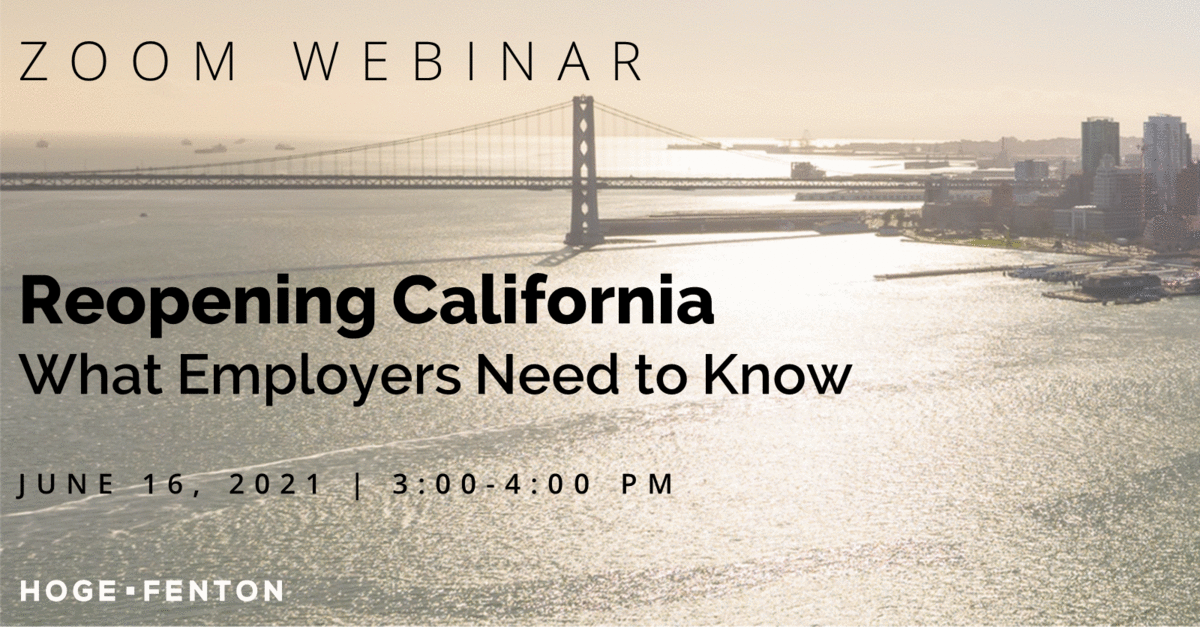
Effective June 15, 2021, the California Department of Public Health (CDPH) has announced the state will advance beyond the Blueprint for a Safer Economy, allowing businesses to return to normal operations with “common-sense risk reduction measures.”
In parallel with the state reopening, Cal/OSHA is in the process of finalizing its revised Emergency Temporary Standards (ETS), which will dictate COVID-related restrictions and requirements in the workplace.
Join us for an informative panel discussion on Wednesday, June 16, 2021, from 3:00 to 4:00 p.m. as Hoge Fenton’s Employment Law team will explain the new legal guidelines for California employers.
Our Employment Law Team
 |
Sarju Naran is a zealous advocate for his clients and approaches litigation with creativity and strategy. Chair of Hoge Fenton’s Employment Law Group, Sarju’s experience spans from representing middle-market and family-owned closely held businesses to large multi-national companies. He regularly litigates and provides advice and counsel to companies on wage and hour issues, trade secret misappropriation, employee mobility, wrongful termination, performance management, and leaves of absence. |
 |
Jenn Protas helps employers navigate California’s numerous employment laws and defends employers with an eye toward successful, yet cost-effective resolution. Jenn is a committed advocate for her clients and a tenacious litigator. She defends employers on matters related to wage and hour law, wrongful termination, harassment, discrimination, and retaliation in single-plaintiff litigation, Private Attorney General Act actions, and/or class actions. Jenn’s practice also includes housing discrimination matters and business litigation. |
 |
Maysa Saeed is an associate attorney in Hoge Fenton’s Employment Law Practice Group. Her practice focuses on employment counseling and litigation and assists clients in all aspects of employment law. Prior to joining Hoge Fenton, Maysa was a litigation associate with experience litigating various commercial, employment, and real estate matters. Maysa’s litigation experience provides her with invaluable insight and perspective when advocating and advising clients to resolve or prevent legal disputes. |
This webinar is provided as an educational service by Hoge Fenton for clients and friends of the firm. This communique is an overview only, and should not be construed as legal advice or advice to take any specific action. Please be sure to consult a knowledgeable professional with assistance with your particular legal issue. © 2021 Hoge Fenton
05.25.2021 | Firm Post
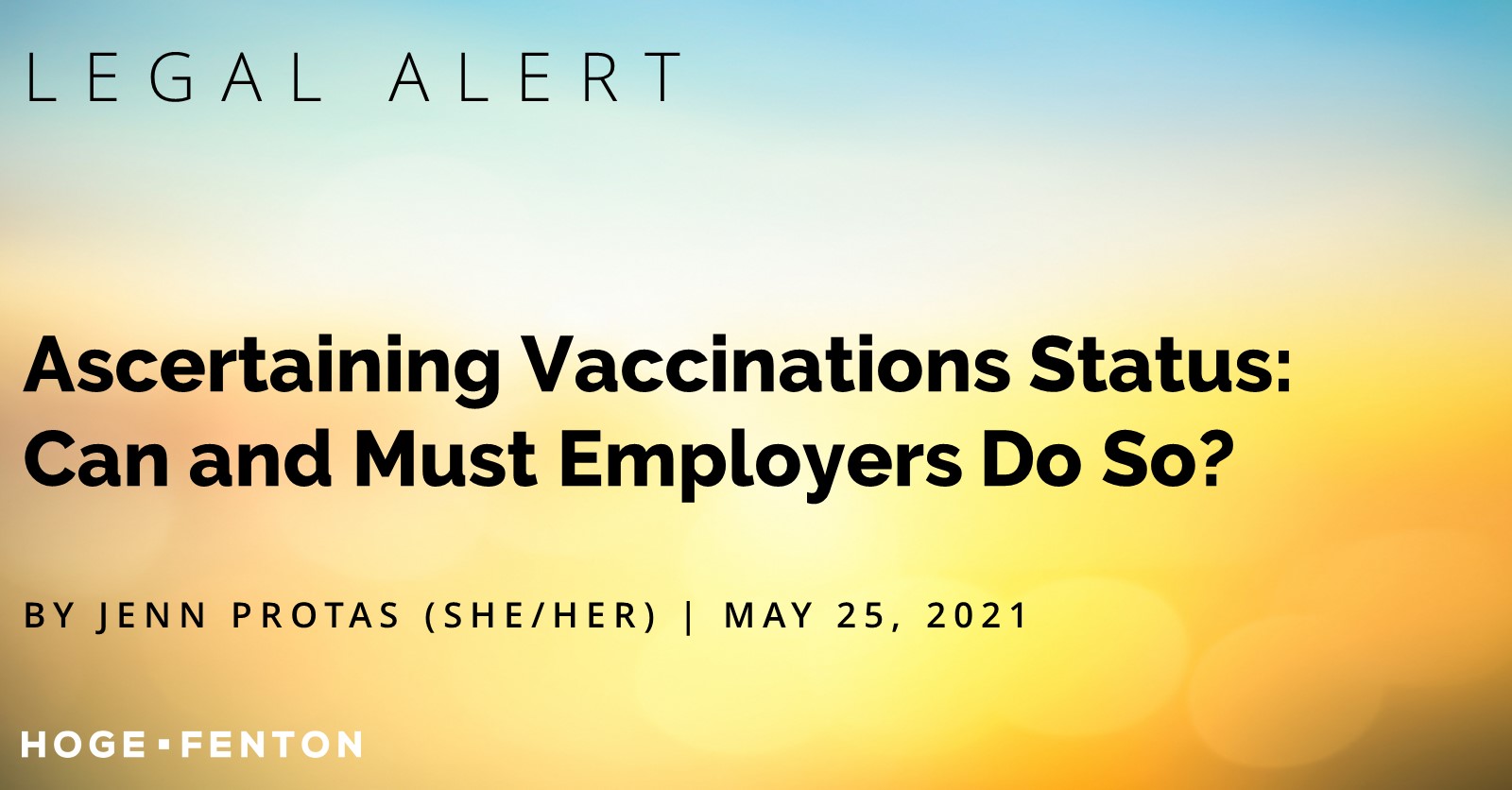
On Tuesday, May 18, Santa Clara County moved to the Yellow Tier of California’s Blueprint for a Safer Economy. In doing so, the County Health Officer issued a new order (with accompanying FAQs) establishing focused safety measures to protect the community from COVID-19 (“the Order”). Among other things, the Order no longer requires businesses to maximize teleworking, eliminates local rules related to capacity, and eliminates the requirement that businesses submit Social Distancing Protocols to the County Public Health Department. However, state rules, including the Cal/OSHA’s COVID-19 Emergency Temporary Standards1, still apply.
Making news is the unexpected requirements by the County that businesses ascertain the vaccination status of all personnel, including employees, contractors, sub-contractors, independent contractors, vendors, volunteers, and other individuals who regularly provide services onsite at the request of the business. The Order requires businesses to ascertain vaccination status of personnel within 14 days of the effective date of the Order—by June 1. Thereafter, businesses must obtain updated vaccination status for all personnel who were not fully vaccinated every 14 days.
Unvaccinated personnel and personnel who decline to provide vaccination status must comply with the Mandatory Directive on Use of Face Coverings and all applicable provisions of the Health Officer’s Mandatory Directive on Unvaccinated Personnel. As such, unvaccinated personnel must continue to wear face coverings at the worksite, must be excluded from the workplace if they’ve been in “close contact” to a confirmed case or have been confirmed to have COVID-19, and must be provided with information on how to get vaccinated2. The County provides a compliant information sheet that businesses can use for this purpose. The Health Officer also urges businesses to require unvaccinated personnel to obtain weekly PCR testing for COVID-19 or daily antigen testing with COVID PCR confirmation of any positives.
Businesses must maintain a written record of their efforts to ascertain vaccination status of their personnel by either (1) confirming their visual review of vaccination documentation, or (2) gathering self-certifications from personnel. The County provides a sample Certification Form that businesses can use to ascertain vaccination status. The form gives employees the option to decline to provide that information, in which case employers must treat such employees as unvaccinated personnel. Businesses must treat these records as confidential medical records.
Failure to comply may result in fines up to $5,000 per violation per day.
Although this requirement is currently a Santa Clara County requirement only (i.e., neither the state nor any other county in the Bay Area has imposed requirements to ascertain vaccination status of personnel), we have seen throughout the pandemic that other counties are likely to follow suit.
Even without a mandate to do so, many employers may choose to ascertain vaccination status of their employees and contractors, and doing so is permissible. It is not a violation of the Health Insurance Portability and Accountability Act (HIPAA), the Americans with Disabilities Act (ADA), or the California Fair Employment and Housing Act (FEHA) to request vaccination status or require proof of vaccination. That said, employers should not ask why employees decline to get vaccinated or share vaccination status. Asking employees why they are not vaccinated or why they decline to share their vaccination status could elicit disability-related information, and, as such, those inquiries are not permitted by the ADA or FEHA. Employee vaccination status should be treated as confidential.
Of course, some businesses are concerned about treating vaccinated and unvaccinated employees differently. Such differential treatment is not based on a protected class (so long as you are treating all unvaccinated personnel equally) and is based on employers’ efforts to keep their employees and the public safe. Therefore, it is permissible to treat vaccinated employees differently if following federal, state, and local guidance in doing so. That said, even when no longer required to enforce mask mandates by state or local laws, businesses are permitted to continue to require all employees to wear face coverings and maintain social distance while at the worksite, regardless of vaccination status.
For more information or resources regarding COVID-related laws applicable to employers and/or employees, please refer to Hoge Fenton’s Employment Law Group’s resource page, or contact a member of the Employment Law Group.
1Cal/OSHA was set to vote on new rules in workplace settings on May 20, but the vote was postponed to June 3. While the state has indicated its intention to adopt the new CDC guidance to allow fully vaccinated Californians to go without face coverings in most indoor settings outside of workplaces when the state fully re-opens (planned tentatively for June 15), the Cal/OSHA Emergency Temporary Standards are still in effect for workplace settings until changed by Cal/OSHA.
2Until the Cal/OSHA and the California Department of Public Health modify requirements, vaccinated personnel must also still wear face coverings in the workplace.
Our Employment Law Group
 |
Jenn Protas (she/her) helps employers navigate California’s numerous employment laws and defends employers with an eye toward successful, yet cost-effective resolution. Jenn is a committed advocate for her clients and a tenacious litigator. She defends employers on matters related to wage and hour law, wrongful termination, harassment, discrimination, and retaliation in single-plaintiff litigation, Private Attorney General Act actions, and/or class actions. Jenn’s practice also includes housing discrimination matters and business litigation. |
 |
Sarju Naran (he/him) is a zealous advocate for his clients and approaches litigation with creativity and strategy. Chair of Hoge Fenton’s Employment Law Group, Sarju’s experience spans from representing middle-market and family-owned closely held businesses to large multi-national companies. He regularly litigates and provides advice and counsel to companies on wage and hour issues, trade secret misappropriation, employee mobility, wrongful termination, performance management, and leaves of absence. |
 |
Maysa Saeed (she/her) is an associate attorney whose practice focuses on employment counseling and litigation and assists clients in all aspects of employment law. Prior to joining Hoge Fenton, Maysa was a litigation associate with experience litigating various commercial, employment, and real estate matters. Maysa’s prior legal experience also includes defending insurance carriers in administrative trials before the Workers’ Compensation Appeals Boards in San Jose and Salinas. |
This information is provided as an educational service by Hoge Fenton for clients and friends of the firm. This communique is an overview only, and should not be construed as legal advice or advice to take any specific action. Please be sure to consult a knowledgeable professional with assistance with your particular legal issue. © 2021 Hoge Fenton
03.29.2021 | Firm Post
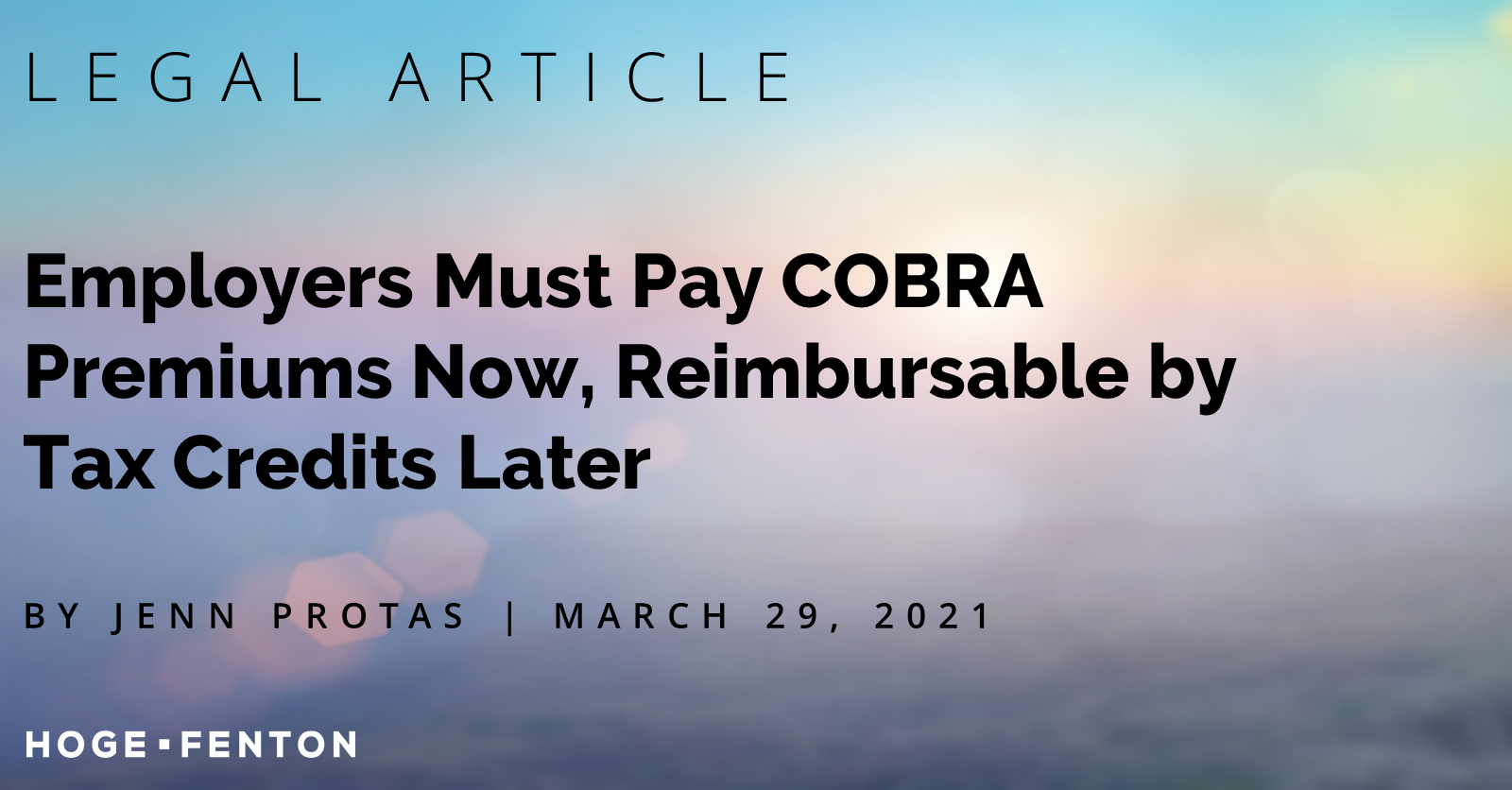
On March 11, 2021, President Biden signed into law the American Rescue Plan Act of 2021 (“ARPA”). Among other things, the ARPA creates a federal subsidy covering 100% of COBRA premiums for certain employees and other qualified beneficiaries. COBRA premiums from April 1, 2021 through September 30, 2021 must now be paid by employers. Employers can be reimbursed through tax credits via their quarterly payroll tax filings.
What is COBRA?
The Consolidated Omnibus Budget Reconciliation Act (“COBRA”) gives eligible employees and their beneficiaries who lose their health benefits for qualifying reasons (such as job loss, reduced hours, or other life events) the right to choose to continue group health benefits provided by their group health plan for limited periods. These qualified individuals may be required to pay the entire premium for coverage up to 102% of the cost to the plan, which represents a huge increase in expenses for health benefits to individuals who are suddenly with less income. In the middle of the worst health pandemic in recent history, employees are losing their jobs or working fewer hours, and health benefits are more important than ever.
What is the COBRA Subsidy?
In recognition of the cost of COBRA premiums, the ARPA provides that “assistance eligible individuals” who timely enroll (either initially or during the special enrollment period) for COBRA coverage will be treated as having paid in full the amount of the COBRA premiums for eligible periods between April 1, 2021 and September 30, 2021 (“the Subsidy Period”). The ARPA does not extend the COBRA coverage period.
Who are “assistance eligible individuals?”
Assistance eligible individuals are those whose initial 18-month COBRA period (whether the individual initially elected COBRA coverage, did not elect COBRA coverage, or let their COBRA coverage lapse) includes some or all of the Subsidy Period and who (1) lost coverage under their employer’s health care plan due to a reduction of hours or involuntary termination (for reasons other than gross misconduct) and (2) elect COBRA continuation coverage—even if after receipt of notice of the subsidy. Employees who voluntarily terminated their employment are not eligible for the subsidy. An assistance eligible individual is no longer eligible for the subsidy upon (1) becoming eligible for other group health plan coverage or Medicare, (2) the expiration of the maximum COBRA period, or (3) the end of the Subsidy Period, whichever comes first.
Assistance eligible individuals during the Subsidy Period fall into one of three situations:
- Assistance eligible individuals who have already elected COBRA and are covered on April 1, 2021 do not need to do anything further to be covered by the subsidy.
- Eligible individuals who did not initially elect COBRA will be given a special enrollment period to elect coverage. This special enrollment period begins April 1 and ends 60 days after receipt of the COBRA subsidy notification. If these individuals elect COBRA coverage, the coverage will be retroactive to April 1, 2021 at no cost.
- Eligible individuals who let their COBRA coverage lapse but whose initial COBRA period extends beyond April 1, 2021 will be given a special enrollment period to elect coverage. This special enrollment period begins April 1 and ends 60 days after receipt of the COBRA subsidy notification. If these individuals elect COBRA coverage, the coverage will be retroactive to April 1, 2021 at no cost.
What must employers do?
Employers, or their benefits providers and third-party administrators, have some responsibilities, including the following:
- Employers should identify all assistance eligible individuals and provide required notices about the new benefit and the special enrollment period. The U.S. Department of Labor is working on model notices for these purposes.
- COBRA election notices for those eligible for the subsidy must include information related to the subsidies, among other information. Work with your benefits providers and third-party administrators to determine what specific information to include and to issue the notices.
- Individuals who are eligible for the special enrollment period must be provided notice of the opportunity to enroll (or re-enroll) by May 31, 2021.
- Assistance eligible individuals are entitled to notification of the subsidy termination date 15 to 45 days before the expiration.
- For assistance eligible individuals, employers must pay the COBRA premium owed during the Subsidy Period to a COBRA provider or plan administrator.
- Employers must also refund any premiums paid by employees during the Subsidy Period.
- Employers may then take a dollar-for-dollar tax credit on their quarterly payroll tax filings.
For more information or resources regarding COVID-related laws applicable to employers and/or employees, please refer to Hoge Fenton’s Employment Law Group’s resource page, or feel free to contact a member of the Employment Law Group.
Meet Our Employment Law Group
 |
Jenn Protas helps employers navigate California’s numerous employment laws and defends employers with an eye toward successful, yet cost-effective resolution. Jenn is a committed advocate for her clients and a tenacious litigator. She defends employers on matters related to wage and hour law, wrongful termination, harassment, discrimination, and retaliation in single-plaintiff litigation, Private Attorney General Act actions, and/or class actions. Jenn’s practice also includes housing discrimination matters and business litigation. |
 |
Sarju Naran is a zealous advocate for his clients and approaches litigation with creativity and strategy. Chair of Hoge Fenton’s Employment Law Group, Sarju’s experience spans from representing middle-market and family-owned closely held businesses to large multi-national companies. He regularly litigates and provides advice and counsel to companies on wage and hour issues, trade secret misappropriation, employee mobility, wrongful termination, performance management, and leaves of absence. |
 |
Maysa Saeed is an associate attorney whose practice focuses on employment counseling and litigation and assists clients in all aspects of employment law. Prior to joining Hoge Fenton, Maysa was a litigation associate with experience litigating various commercial, employment, and real estate matters. Maysa’s prior legal experience also includes defending insurance carriers in administrative trials before the Workers’ Compensation Appeals Boards in San Jose and Salinas. |
This information is provided as an educational service by Hoge Fenton for clients and friends of the firm. This communique is an overview only, and should not be construed as legal advice or advice to take any specific action. Please be sure to consult a knowledgeable professional with assistance with your particular legal issue. © 2021 Hoge Fenton
03.24.2021 | Firm Post
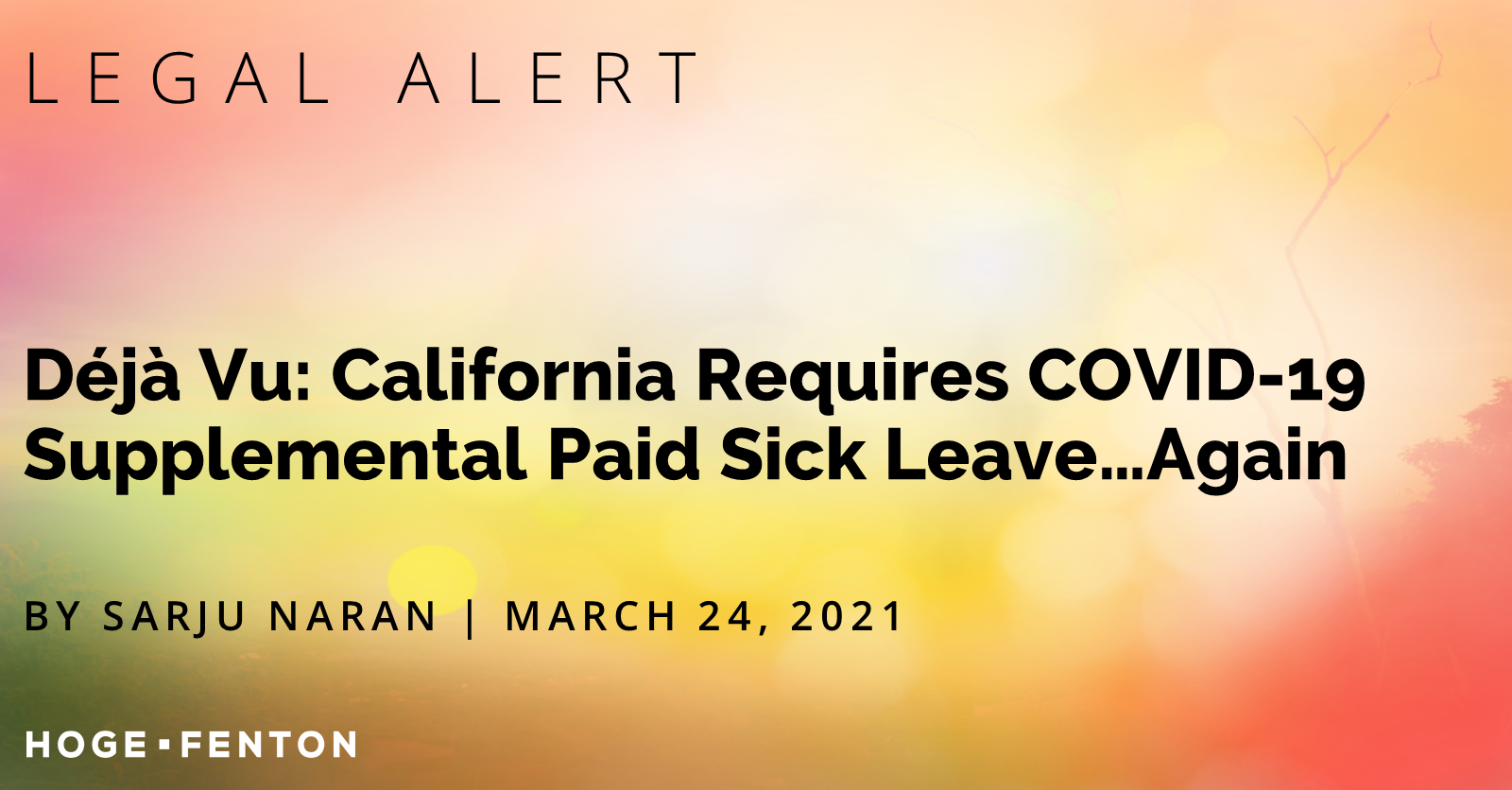
The only constant is change! California employers who received our recent article regarding paid sick leave under the Families First Coronavirus Response Act (FFCRA) being optional…hold that thought. Effective March 29, 2021, employers with more than 25 employees will be required to offer up to 80 hours of paid sick leave to California employees who are unable to work or telework due to certain reasons related to COVID-19. Importantly, this requirement will be retroactive to January 1, 2021, which means employees who have already taken time off in 2021 for a qualifying reason will be entitled to be paid for the time off by the next full pay period after they notify their employer of their request.
Employers are required to post a notice of this new benefit (emailing the notice to employees will also work). The California Labor Commissioner has published a model notice for this purpose, and it nicely sets forth the details and requirements of California’s new COVID-19 supplemental paid sick leave (CSPSL). Click here for a copy of the model notice.
Tip: Our recent article on the revamp of the FFCRA discussed that employers who provide paid sick leave can be reimbursed through federal tax credits. Since California is not reimbursing employers for providing supplemental paid sick leave, employers should claim reimbursement through tax credits under the FFCRA when employees take time off that qualifies for paid sick leave under both the FFCRA and California’s CSPSL.
Other Overlapping Laws: Employers with employees in San Jose should be mindful of the need to consider and coordinate sick leave requests under San Jose’s emergency paid sick leave ordinance as well as the FFCRA and California CSPSL. Click here for our January 8, 2021 article regarding San Jose’s ordinance. Several other cities and counties have similar local ordinances, so employers should be aware of where their employees perform their work and whether those locations have sick leave ordinances that also need to be considered and coordinated with the FFCRA and California CSPSL.
For more information or resources regarding COVID-19 Supplemental Paid Sick Leave or other COVID-related laws applicable to employers and/or employees, please refer to Hoge Fenton’s Employment Law Group’s resource page here, or feel free to email a member of the Employment Law Group.
Meet Our Employment Law Group
 |
Sarju Naran is a zealous advocate for his clients and approaches litigation with creativity and strategy. Chair of Hoge Fenton’s Employment Law Group, Sarju’s experience spans from representing middle-market and family-owned closely held businesses to large multi-national companies. He regularly litigates and provides advice and counsel to companies on wage and hour issues, trade secret misappropriation, employee mobility, wrongful termination, performance management, and leaves of absence. |
 |
Jenn Protas helps employers navigate California’s numerous employment laws and defends employers with an eye toward successful, yet cost-effective resolution. Jenn is a committed advocate for her clients and a tenacious litigator. She defends employers on matters related to wage and hour law, wrongful termination, harassment, discrimination, and retaliation in single-plaintiff litigation, Private Attorney General Act actions, and/or class actions. Jenn’s practice also includes housing discrimination matters and business litigation. |
 |
Maysa Saeed is an associate attorney whose practice focuses on employment counseling and litigation and assists clients in all aspects of employment law. Prior to joining Hoge Fenton, Maysa was a litigation associate with experience litigating various commercial, employment, and real estate matters. Maysa’s prior legal experience also includes defending insurance carriers in administrative trials before the Workers’ Compensation Appeals Boards in San Jose and Salinas. |
This information is provided as an educational service by Hoge Fenton for clients and friends of the firm. This communique is an overview only, and should not be construed as legal advice or advice to take any specific action. Please be sure to consult a knowledgeable professional with assistance with your particular legal issue. © 2021 Hoge Fenton
03.22.2021 | Firm Post
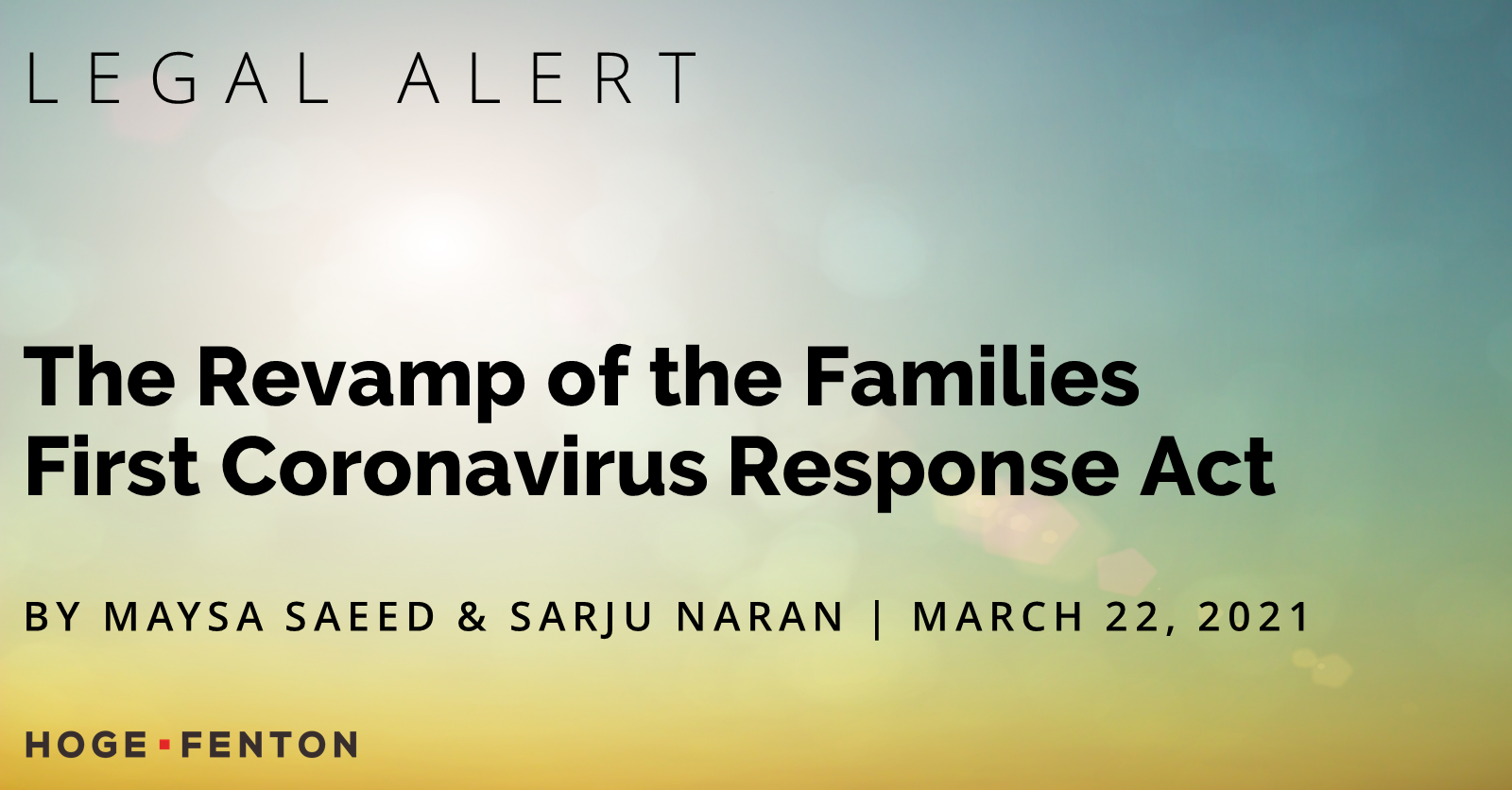
On Thursday, March 11, 2021, President Joe Biden signed into law the most recent COVID-19 relief package, the American Rescue Plan Act of 2021 (“ARPA”). The ARPA affords employer-provided benefits to employees and extends and modifies several of the provisions enacted in prior COVID-19 relief bills, including the Families First Coronavirus Response Act (“FFCRA”).
Background
Last year, the FFCRA required covered employers with 500 or fewer employees to provide eligible employees with paid sick leave and expanded family and medical leave for specified reasons related to COVID-19. That requirement expired on December 31, 2020, and was replaced by the 2021 Consolidated Appropriations Act (“CAA”), which permitted covered employers to continue receiving federal tax credits for allowing its employees to take unused FFCRA paid leave between January 1, 2021 through March 31, 2021.
How Has FFCRA Leave Changed?
Effective April 1, 2021, the ARPA extends the option for employers to voluntarily offer FFCRA paid leave to eligible employees through September 30, 2021, and to receive reimbursement for the pay through tax credits. The ARPA also modifies the FFCRA in a few ways.
New qualifying reasons: As of April 1, 2021, employers who choose to offer FFCRA leave, will need to permit employees to take paid leave for the following additional qualifying reasons: (1) receiving a COVID-19 vaccine; (2) recovering from any injury, disability, illness, or condition related to the COVID-19 vaccine; (3) seeking or awaiting the results of a COVID-19 test when the employee has been exposed to COVID-19 or the employer has requested the test. These new qualifying reasons will apply to both emergency paid sick leave (EPSL) and emergency family and medical leave (EFMLA). Under the original version of the FFCRA, EFMLA was only available for school or childcare issues.
New bank of EPSL time: For employees who previously used some or all of their FFCRA paid sick time, on April 1, 2021, the ARPA creates a new allotment of up to 80 hours (10 days) for qualifying EPSL). Please note, this new allotment only applies to EPSL. Employees who have used some or all of their EFMLA time prior to April 1, 2021 will not be afforded any additional allotment of EFMLA time.
All 12 weeks of EFMLA will be paid: The first two weeks of the 12-week period of leave under the EFMLA will no longer be unpaid. As a result, between EPSL and EFMLA, eligible employees may be able to take up to 14 weeks of paid time off for a qualifying reason, if their employer chooses to offer FFCRA leave (and assuming the employees have not previously exhausted their 12 weeks of EFMLA). Further, the prior cap on pay for EFMLA will increase from $10,000 to $12,000 (to account for the extra two weeks of pay). As before, employees will still be compensated at 2/3 of their regular rate of pay, up to a $200 daily cap for EFMLA.
No discrimination: The ARPA includes rules that will deny employers tax credits if they discriminate by offering leave: (1) in favor of highly compensated employees; (2) in favor of full-time employees; or (3) on the basis of employment tenure.
Beyond the FFCRA
As a reminder, while covered employers are no longer required to provide paid leave under the FFCRA, they should remain mindful of other paid and unpaid leave requirements under state, federal, and local laws.
For more information or resources regarding the FFCRA or other COVID-related laws applicable to employers and/or employees, please refer to Hoge Fenton’s Employment Law Group’s resource page (here), or feel free to contact a member of the Employment Law Group.
Meet Our Employment Law Group
 |
Maysa Saeed is an associate attorney whose practice focuses on employment counseling and litigation and assists clients in all aspects of employment law. Prior to joining Hoge Fenton, Maysa was a litigation associate with experience litigating various commercial, employment, and real estate matters. Maysa’s prior legal experience also includes defending insurance carriers in administrative trials before the Workers’ Compensation Appeals Boards in San Jose and Salinas. |
 |
Sarju Naran is a zealous advocate for his clients and approaches litigation with creativity and strategy. Chair of Hoge Fenton’s Employment Law Group, Sarju’s experience spans from representing middle-market and family-owned closely held businesses to large multi-national companies. He regularly litigates and provides advice and counsel to companies on wage and hour issues, trade secret misappropriation, employee mobility, wrongful termination, performance management, and leaves of absence. |
 |
Jenn Protas helps employers navigate California’s numerous employment laws and defends employers with an eye toward successful, yet cost-effective resolution. Jenn is a committed advocate for her clients and a tenacious litigator. She defends employers on matters related to wage and hour law, wrongful termination, harassment, discrimination, and retaliation in single-plaintiff litigation, Private Attorney General Act actions, and/or class actions. Jenn’s practice also includes housing discrimination matters and business litigation. |
This information is provided as an educational service by Hoge Fenton for clients and friends of the firm. This communique is an overview only, and should not be construed as legal advice or advice to take any specific action. Please be sure to consult a knowledgeable professional with assistance with your particular legal issue. © 2021 Hoge Fenton
01.08.2021 | Firm Post
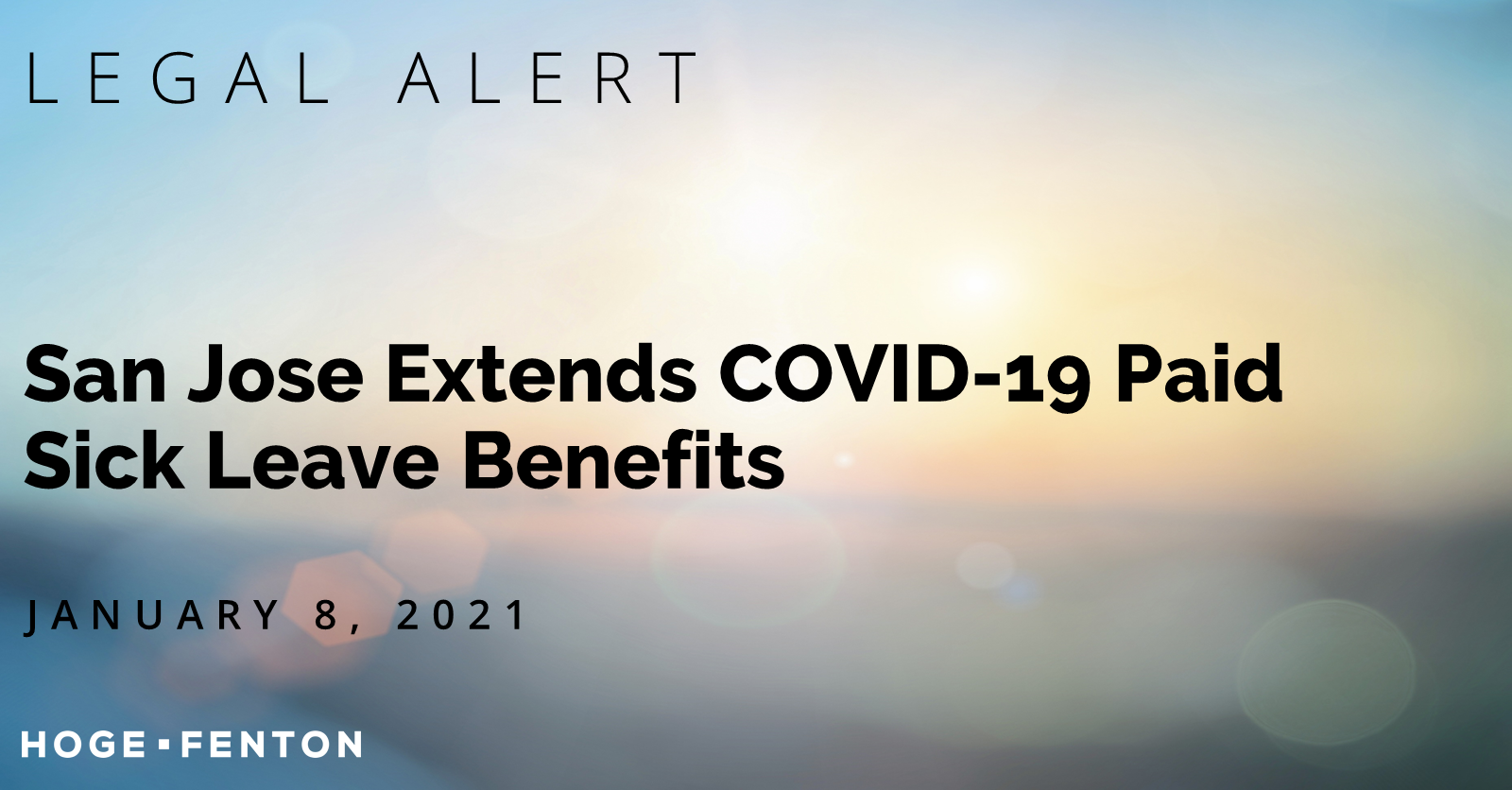
by Sarju Naran, Employment Law Group
On January 5, 2021, the San Jose City Council voted unanimously to extend the timeframe for employers to provide emergency paid sick leave benefits to San Jose employees for qualifying reasons pertaining to COVID-19. Click here for a copy of the new ordinance.
Employers may recall that the San Jose ordinance was first enacted on April 7, 2020, as a way to provide paid sick leave benefits to San Jose employees who were not eligible for federal paid sick leave benefits under the Families First Coronavirus Response Act (FFCRA). Shortly after the San Jose ordinance was enacted, California enacted a similar statewide COVID-19 supplemental paid sick leave for employees who were ineligible for benefits under the FFCRA. However, all three laws (the FFCRA, the California COVID-19 supplemental paid sick leave, and the San Jose ordinance) expired on December 31, 2020, rendering employees without any COVID-19 paid sick leave protections in 2021. With the COVID-19 crisis continuing to persist, the San Jose City Council has now voted to extend paid sick leave benefits for an additional 6 months, and to make the extension retroactive to January 1, 2021.
Key points of the new ordinance:
- All employees who perform at least 2 hours of work within the City of San Jose are eligible for paid sick leave for a qualifying reason, regardless of the company’s employee headcount (i.e., with the FFCRA expired, the ordinance is no longer aimed at companies with more than 500 employees or fewer than 50 employees)
- Qualifying reasons—The employee must be unable to work (i.e. employees who can work remotely are not eligible) for one of the following reasons:
- The employee is subject to a federal, state, or local quarantine or isolation order related to COVID-19
- The employee has been advised by a health care provider to self-quarantine due to concerns related to COVID-19
- The employee is experiencing symptoms of COVID-19 and seeking a medical diagnosis
- The employee is caring for an individual who is either: (1) to a subject federal, state, or local quarantine or isolation order related to COVID-19, or (2) has been advised by a health care provider to self-quarantine due to concerns related to COVID-19
- The employee is caring for a son or daughter of such employee if the school or place of care of the son or daughter has been closed, or the childcare provider of such son or daughter is unavailable, due to COVID-19 precautions
- Full-time employees are eligible for 80 hours of paid sick leave, to be used between April 2, 2020, and June 30, 2021. Part-time employees are eligible for pro-rated leave.
- Employees who take leave for themselves are entitled to their full regular pay, up to a maximum of $511 per day. Employees who take leave to care for another person are entitled to two-thirds of their regular pay, up to a maximum of $200 per day.
- Employees cannot be required to take other available paid time off first (e.g. vacation, PTO) before using paid sick leave under the ordinance.
- However, importantly, the ordinance does not apply to any company that provides paid personal leave that is at least equivalent to the paid sick time required under the ordinance. For example, because the ordinance provides full-time employees with 80 hours of leave between April 2, 2020, and June 30, 2021 (i.e. 15 months), if a company offers its full-time employees a combination of vacation accrual and sick time that equals at least 80 hours of paid time off over the course of 15 months, the company is not required to do anything further to comply with the San Jose ordinance. If a company offers its full-time employees less than 80 hours of paid personal leave over 15 months, the company needs to make up the shortfall with paid sick time under the ordinance (and as stated in the prior bullet point, the employee must be able to use the paid sick time first before using any other form of paid leave).
For more information or resources regarding COVID-related laws applicable to employers please refer to Hoge Fenton’s Employment Law Group’s resource page here, or feel free to contact a member of the Employment Law Group.
Meet Our Employment Law Group
 |
Sarju Naran is a zealous advocate for his clients and approaches litigation with creativity and strategy. Chair of Hoge Fenton’s Employment Law Group, Sarju’s experience spans from representing middle-market and family-owned closely held businesses to large multi-national companies. He regularly litigates and provides advice and counsel to companies on wage and hour issues, trade secret misappropriation, employee mobility, wrongful termination, performance management, and leaves of absence. |
 |
Jenn Protas helps employers navigate California’s numerous employment laws and defends employers with an eye toward successful, yet cost-effective resolution. Jenn is a committed advocate for her clients and a tenacious litigator. She defends employers on matters related to wage and hour law, wrongful termination, harassment, discrimination, and retaliation in single-plaintiff litigation, Private Attorney General Act actions, and/or class actions. Jenn’s practice also includes housing discrimination matters and business litigation. |
 |
Maysa Saeed is an associate attorney whose practice focuses on employment counseling and litigation and assists clients in all aspects of employment law. Prior to joining Hoge Fenton, Maysa was a litigation associate with experience litigating various commercial, employment, and real estate matters. Maysa’s prior legal experience also includes defending insurance carriers in administrative trials before the Workers’ Compensation Appeals Boards in San Jose and Salinas. |
This information is provided as an educational service by Hoge Fenton for clients and friends of the firm. This communique is an overview only, and should not be construed as legal advice or advice to take any specific action. Please be sure to consult a knowledgeable professional with assistance with your particular legal issue. © 2021 Hoge Fenton
12.28.2020 | Firm Post
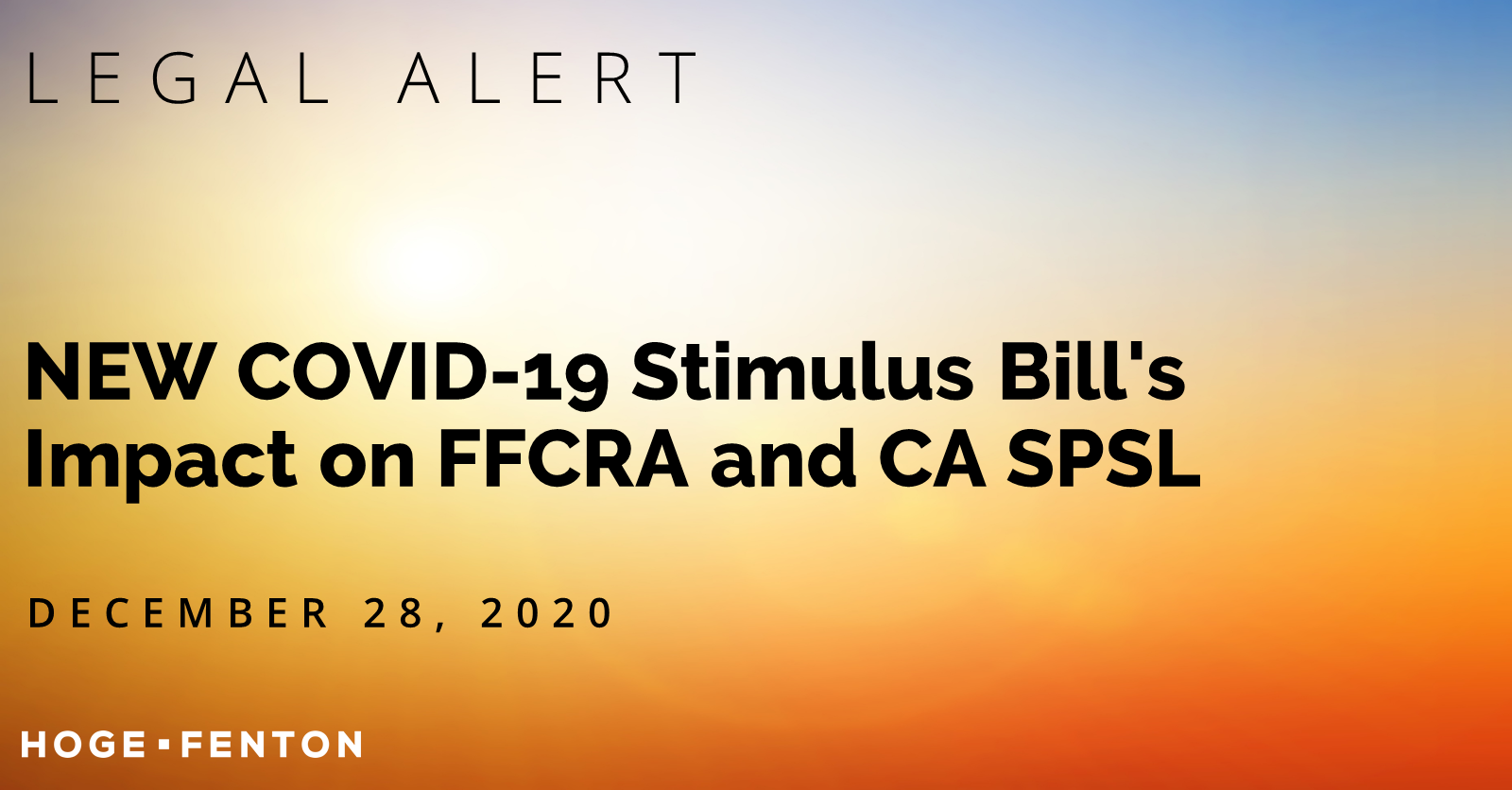
by Maysa Saeed and Jenn Protas, Employment Law Group
On April 1, 2020, the United States Department of Labor (“Department”) announced the Emergency Paid Sick Leave Act and Emergency Family and Medical Leave Expansion Act, both part of the Families First Coronavirus Response Act (“FFCRA”). The FFCRA requires employers with 500 or fewer employees to provide their eligible employees with paid sick leave and expanded family and medical leave for specified reasons related to COVID-19. These paid leave provisions became operational on April 1, 2020 and are set to expire on December 31, 2020.
The FFCRA helps mitigate the effects of COVID-19 in the workplace by reimbursing covered employers with tax credits for the cost of providing employees with paid leave taken for specified reasons related to COVID-19. Covered employers qualify for dollar-for-dollar reimbursement through tax credits for all qualifying wages paid under the FFCRA, up to the appropriate per diem and aggregate payment caps. Applicable tax credits also extend to amounts paid or incurred to maintain health insurance coverage. As such, the FFCRA enables employers to keep their workers on their payroll, while at the same time ensuring that workers are not forced to choose between their paychecks and the public health measures needed to combat the virus.
What Happens to Paid Leave Under the FFCRA After December 31, 2020?
Until this week, it was uncertain whether Congress would extend the FFCRA into next year. Congressional leaders, however, have agreed on a $900 billion coronavirus relief bill (the “Bill”) that provides an answer to the fate of the paid leave provisions under the FFRCA. The current version of the legislation (signed by the President December 27, 2020) results in the following:
- Required paid leave under FFCRA ends on December 31, 2020.
- As of January 1, 2021, covered employers may voluntarily provide emergency paid sick leave or emergency paid leave under FFCRA to continue receiving the tax credit benefits associated with this leave. The tax credit may only be taken for leave through March 31, 2021.
Therefore, effective January 1, 2021, paid leave under the FFCRA will no longer be required. Covered employers who voluntarily provide paid leave benefits under the FFCRA through March 31, 2021, will remain eligible to receive tax credits for the paid leave. It should be noted, the Bill does not seem to provide a new set of tax credits or leave. In other words, if an employee has already taken 80 hours of emergency paid sick leave in 2020, then the employee would not be entitled to new emergency paid leave in 2021. With respect to the expanded family and medical leave provisions, presumably, if the employer’s 12-month period for FMLA resets under the employer’s policy, the employee would be entitled to paid FMLA again. It is not clear whether that was the Department’s intent or whether future guidance will provide otherwise.
How Does the Bill Impact California’s Supplemental Paid Sick Leave?
Although larger employers, with 500 or more employees, are not governed by the FFCRA, California enacted supplemental paid sick leave (“SPSL”) to account for time off due to COVID-19-related reasons. In California, covered employers are required to provide SPSL to their eligible employees through: (i) December 31, 2020, or (ii) an extension of the FFCRA. It is currently unclear whether the paid leave provisions under the Bill, given its voluntary nature, would constitute as an “extension.” Therefore, until California provides further guidance, it remains unclear whether covered employers will be required to provide SPSL to their eligible employees through March 31, 2021.
Key Takeaways:
- Under the FFCRA, covered employers are only required to provide emergency paid sick leave or emergency paid Family and Medical Leave Act until December 31, 2020.
- Effective January 1, 2021, covered employers under FFCRA may voluntarily provide emergency paid sick leave or emergency paid Family and Medical Leave Act to take the tax credit associated with this leave through March 31, 2021.
- While covered employers under the FFCRA are no longer required to provide paid leave under federal law as of January 1, 2021, they should remain mindful of other paid leave requirements under state and local laws.
- In California, while employers with more than 500 employees are required to provide SPSL through at least December 31, 2020, it is possible it will be extended. So stay tuned!
For more information or resources regarding the FFCRA, California’s SPSL, or other COVID-related laws applicable to employers and/or employees, please refer to Hoge Fenton’s Employment Law Group’s resource page (here), or feel free to contact a member of the Employment Law Group.
 |
Maysa Saeed is an associate attorney whose practice focuses on employment counseling and litigation and assists clients in all aspects of employment law. Prior to joining Hoge Fenton, Maysa was a litigation associate with experience litigating various commercial, employment, and real estate matters. Maysa’s prior legal experience also includes defending insurance carriers in administrative trials before the Workers’ Compensation Appeals Boards in San Jose and Salinas. |
 |
Jenn Protas helps employers navigate California’s numerous employment laws and defends employers with an eye toward successful, yet cost-effective resolution. Jenn is a committed advocate for her clients and a tenacious litigator. She defends employers on matters related to wage and hour law, wrongful termination, harassment, discrimination, and retaliation in single-plaintiff litigation, Private Attorney General Act actions, and/or class actions. Jenn’s practice also includes housing discrimination matters and business litigation. |
 |
Sarju Naran is a zealous advocate for his clients and approaches litigation with creativity and strategy. Chair of Hoge Fenton’s Employment Law Group, Sarju’s experience spans from representing middle-market and family-owned closely held businesses to large multi-national companies. He regularly litigates and provides advice and counsel to companies on wage and hour issues, trade secret misappropriation, employee mobility, wrongful termination, performance management, and leaves of absence. |
 |
Embert P. Madison, Jr. is a transactional associate and his practice focuses on real estate, employment advice and counsel, and cannabis regulation. He has represented clients in commercial real estate transactions throughout California, Texas, and Florida. Embert has extensive cannabis regulatory experience representing both local governments and private businesses. He has drafted cannabis business and zoning regulations for nine cities in Northern and Central California. |
This information is provided as an educational service by Hoge Fenton for clients and friends of the firm. This communique is an overview only, and should not be construed as legal advice or advice to take any specific action. Please be sure to consult a knowledgeable professional with assistance with your particular legal issue. © 2020 Hoge Fenton
11.25.2020 | Firm Post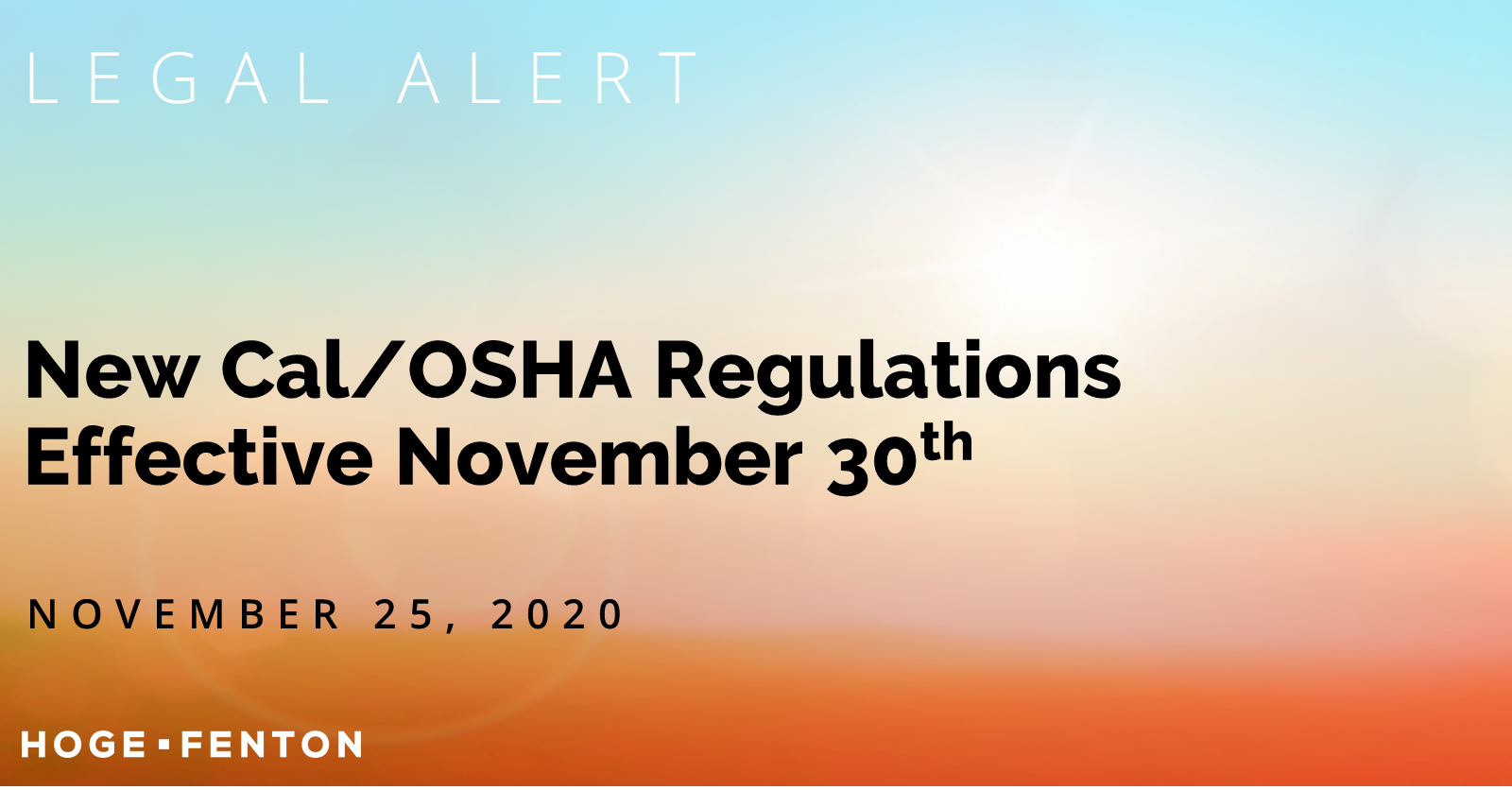
by Jenn Protas, Shareholder and Attorney
Sarju Naran, Shareholder and Employment Law Chair
On Friday, November 20, 2020, the California Department of Industrial Relations’ Occupational Safety and Health Standards Board adopted emergency temporary standards to protect employees from hazards related to COVID-19. Although the emergency standards must be approved by the Office of Administrative Law (“OAL”), the OAL must review and approve the emergency standards by November 30, which, if approved (as is expected), will become effective immediately. This requires California employers to act urgently to implement policies and procedures to comply.
The new emergency safety orders apply to all employees and places of employment in California except (1) places of employment with one employee who does not have contact with other persons, (2) employees working from home, and (3) employees when covered by 8 CCR section 5199 (related to facilities, services, and operations dealing with aerosol transmissible diseases).
The new safety orders would require employers to establish, implement, and maintain an effective, written COVID-19 Prevention Program, which may be integrated into the employer’s Injury and Illness Prevention Program or maintained in a separate document. The COVID-19 Prevention Program1 must include:
- A system for communicating information to employees regarding prevention, testing, symptoms, and a system for reporting exposure without fear of reprisal.
- Identification and evaluation of COVID-19 hazards, including, among other things, screening employees for and responding to employees with COVID-19 symptoms and effectively and immediately responding to COVID-19 positive employees to prevent or reduce the risk of transmission in the workplace.
- Investigating and responding to COVID-19 cases in the workplace, including policies and procedures to identify and give notice of COVID-19 exposure, within one business day, while maintaining confidentiality, and offering testing at the employer’s expense during work hours to workers who may have been exposed.
- Correction of COVID-19 hazards, including correcting unsafe conditions and work practices.
- Providing training and instruction to employees regarding, among other things, COVID-19-related benefits, social distancing, methods of how the virus spreads, wearing face coverings, and handwashing.
- Adopting site-specific strategies to maximize health standards, including solid partitions, outdoor ventilation, cleaning and disinfecting procedures, and providing PPE.
- Reporting, recordkeeping, and access – requiring employers to report workplace COVID-19 cases to the health department when required by law, maintain records of steps taken to implement the written COVID-19 Prevention Program, maintain records and tracking of COVID-19 cases.
- Removing workers who are positive or exposed to COVID-19 from the workplace and maintaining excluded employees’ earnings, seniority, rights and benefits. The employer may use employer-provided sick leave benefits for this purpose and consider benefit payments from public sources in determining how to maintain earnings, rights, and benefits where permitted by law and when not covered by workers’ compensation. The requirement to maintain pay, rights, and benefits does not apply for the period of time the employee is otherwise unable to work for reasons other than to protect employees from transmission, or where the employer demonstrates the COVID-19 exposure was not work-related.
- Criteria for employees to return to work after recovering from COVID-19: When symptomatic, the employee shall not return until (1) at least 24 hours have passed since a fever of 100.4 or higher has resolved without fever-reducing medication, (2) COVID-19 symptoms have improved, and (3) at least 10 days have passed since COVID-19 symptoms first appeared. When asymptomatic, an employee may not return until a minimum of 10 days have passed since specimen collection of their first positive COVID-19 test.
- An employer may not require a negative COVID-19 test for employees to return to work.
Additional testing and notification requirements are set forth in a place of employment with a COVID-19 outbreak (when there are three or more COVID-19 cases in an exposed workplace within a 14-day period) and major outbreaks (20 or more cases within a 30-day period). There are also specific requirements set forth where employers provide housing and transportation to and from work.
1There are additional nuances and requirements not identified here. Please consult the regulations for further details.
A Few Key Takeaways
- You should begin drafting your COVID-19 Prevention program now, since it will likely become required as of Monday, November 30, 2020.
- Without identifying who tested positive, within one business day of learning that someone in the workplace tested positive, you must provide notice of the potential exposure to all employees and independent contractors who were either exposed to the person or present at the worksite during the exposure period.
- All employees who were within six feet of someone who tested positive for a cumulative period of 15 minutes or longer within a 24-hour period need to be put on paid leave for 14 days from the last known exposure.
- You can require the use of sick time, PTO, FFCRA, or other benefit payments from public sources to maintain employees’ pay when they are on leave, but if they have used all those pay benefits, you simply have to continue paying them anyway. That is a bold and abrupt requirement, especially coming from Cal/OSHA through an emergency regulation, and it could create substantial expense for employers.
- You must allow employees to return to work after testing positive once the specified time and symptoms have passed (different criteria based on whether the employee is symptomatic or asymptomatic). You cannot require a negative test before allowing the employee to return to work.
- In the event of an outbreak (three or more positive cases within 14 days), all employees who were in the workplace during the period of the outbreak must be tested twice: (1) immediately, and (2) one week later. Thereafter, all employees who remain at the workplace must continue to be tested at least weekly until there are no more positive cases for a 14-day period.
- In the event of a major outbreak (20 or more positive cases within 30 days), all employees who were in the workplace during the 30-day period must be tested twice per week until there are no more positive cases for a 14-day period.
Meet Our Employment Law Team
 |
Jenn Protas helps employers navigate California’s numerous employment laws and defends employers with an eye toward successful, yet cost-effective resolution. Jenn is a committed advocate for her clients and a tenacious litigator. She defends employers on matters related to wage and hour law, wrongful termination, harassment, discrimination, and retaliation in single-plaintiff litigation, Private Attorney General Act actions, and/or class actions. Jenn’s practice also includes housing discrimination matters and business litigation. |
 |
Sarju Naran is a zealous advocate for his clients and approaches litigation with creativity and strategy. Chair of Hoge Fenton’s Employment Law Group, Sarju’s experience spans from representing middle-market and family-owned closely held businesses to large multi-national companies. He regularly litigates and provides advice and counsel to companies on wage and hour issues, trade secret misappropriation, employee mobility, wrongful termination, performance management, and leaves of absence. |
 |
Embert P. Madison, Jr. is a transactional associate and his practice focuses on real estate, employment advice and counsel, and cannabis regulation. He has represented clients in commercial real estate transactions throughout California, Texas, and Florida. Embert has extensive cannabis regulatory experience representing both local governments and private businesses. He has drafted cannabis business and zoning regulations for nine cities in Northern and Central California. |
This information is provided as an educational service by Hoge Fenton for clients and friends of the firm. This communique is an overview only, and should not be construed as legal advice or advice to take any specific action. Please be sure to consult a knowledgeable professional with assistance with your particular legal issue. © 2020 Hoge Fenton
09.23.2020 | Firm Post
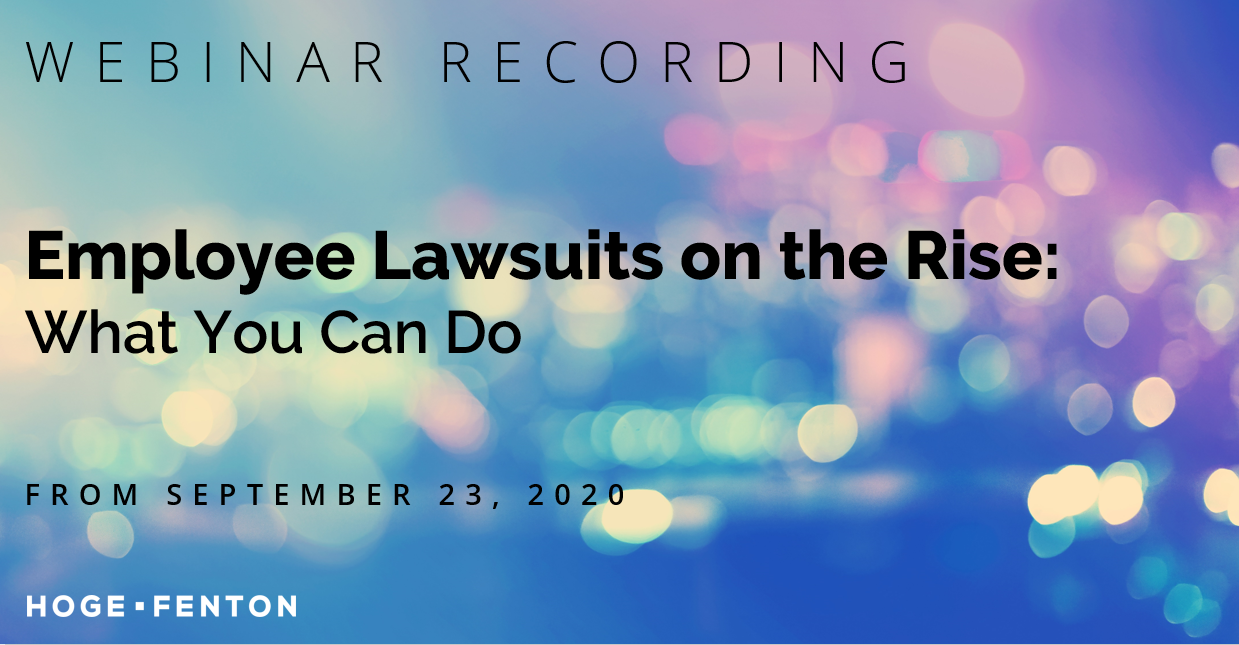
Thank you to everyone who joined us for our Employee Lawsuits on the Rise webinar today with Employment Law Chair Sarju Naran and Employment Law Attorney Jenn Protas.
Please click below to watch the recording.
We hope you enjoyed the presentation. Please do not hesitate to reach out to us at webinars@hogefenton.com if you have any inquires for Sarju or Jenn.
Feel free to visit our Vimeo page for a full library of Hoge Fenton webinar recordings and check out our News & Events page for our latest legal updates and webinars.
Meet our Trusted Advisors
 |
Sarju Naran is a zealous advocate for his clients and approaches litigation with creativity and strategy. Chair of Hoge Fenton’s Employment Law Group, Sarju’s experience spans from representing middle-market and family-owned closely held businesses to large multi-national companies. He regularly litigates and provides advice and counsel to companies on wage and hour issues, trade secret misappropriation, employee mobility, wrongful termination, performance management, and leaves of absence. |
 |
Jenn Protas helps employers navigate California’s numerous employment laws and defends employers with an eye toward successful, yet cost-effective resolution. Jenn is a committed advocate for her clients and a tenacious litigator. She defends employers on matters related to wage and hour law, wrongful termination, harassment, discrimination, and retaliation in single-plaintiff litigation, Private Attorney General Act actions, and/or class actions. Jenn’s practice also includes housing discrimination matters and business litigation. |
This information is provided as an educational service by Hoge Fenton for clients and friends of the firm. This communique is an overview only, and should not be construed as legal advice or advice to take any specific action. Please be sure to consult a knowledgeable professional with assistance with your particular legal issue. © 2020 Hoge Fenton
09.21.2020 | Firm Post
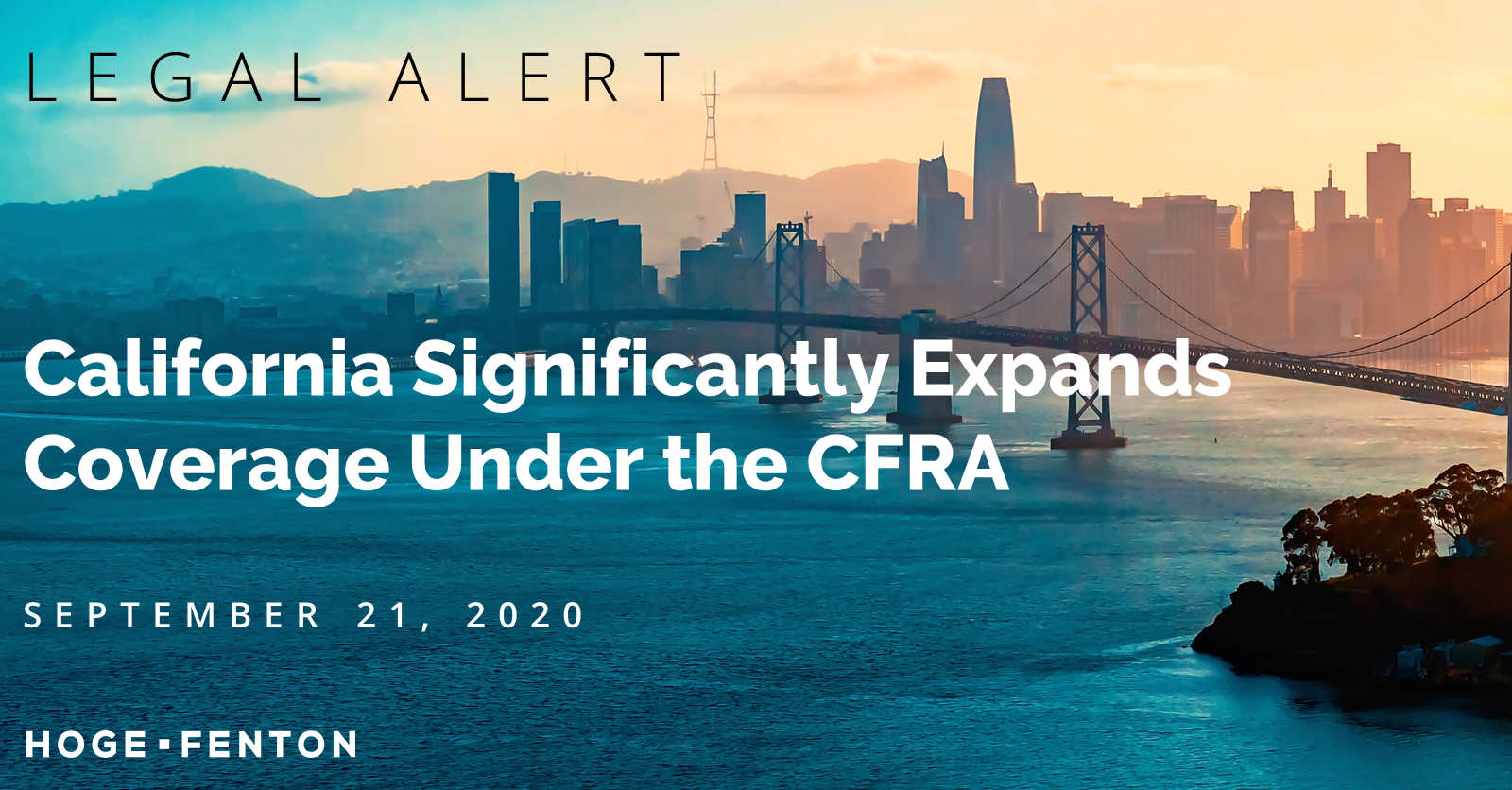
by Jenn Protas, Shareholder and Attorney, Employment Law Group
Governor Gavin Newsom approved an historic expansion of the California Family Right Act (“CFRA”) in signing Senate Bill (“SB”) 1383.
Existing Law
Under existing law, the California Family Rights Act requires employers with 50 or more employees within a 75-mile radius to grant a leave of absence to eligible employees of up to 12 workweeks in a 12-month period for permitted purposes, including to bond with a new child or to care for themselves or a child, parent, or spouse. The baby bonding requirements of the CFRA were expanded effective January 1, 2018 under the New Parent Leave Act to apply to employers with 20 or more employees within a 75-mile radius for eligible employees. Further, under existing law, where both parents worked for the employer, the employer was only required to grant a combined 12 weeks of leave for baby bonding purposes under the CFRA and New Parent Leave Act.
What’s Changed
SB 1383, which becomes effective January 1, 2021, expands the CFRA to apply to private employers with five or more employees (regardless of the number of employees within a 75-mile radius). Once effective, employers with five or more employees must grant eligible employees (those who have more than 12 months of service with the employer and who have at least 1,250 hours of service with the employer during the previously 12 months) up to a total of 12 workweeks in any 12-month period (as defined by the employer) for job-protected family care and medical leave. CFRA leave may be taken for the following purposes:
- To bond with a child following the birth of the employee’s child or the placement of a child with an employee in connection with the adoption or foster care of the child by the employee (“baby bonding”)
- The new bill removed the ability for employers of both parents to limit baby bonding leave to a total of 12 workweeks for such purposes; now, each parent is entitled to receive 12 workweeks of CFRA baby bonding leave even if they both work for the same covered employer.
- To care for a child, parent, grandparent, grandchild, sibling, spouse, or domestic partner with a serious health condition
- The definition of child no longer applies only to children under age 18 or adult dependent children; child is now expanded to cover all adult children, regardless of dependency status
- Note that the FMLA and the CFRA, previously, only allowed time to care for a parent, spouse (including domestic partner under the CFRA), or child with a serious health condition
- Because of an employee’s own serious heath condition that makes the employee unable to perform the functions of the position, except for disability on account of pregnancy, childbirth, or related medical conditions (California provides for such leave under Pregnancy Disability Leave)
- Because of a qualifying exigency related to the covered active duty or call to covered active duty of an employee’s spouse, domestic partner, child, or parent in the Armed Forces of the United States (bringing the CFRA more in line with the FMLA, which already provides for qualifying exigency leave)
CFRA is generally unpaid, however, employees may elect, and in some cases, employers may require, employees to use accrued vacation leave or paid time off, and, where the leave is to care for themselves, sick leave.
Employers are required to maintain and pay for coverage under any group health plans for the duration of the CFRA-qualifying leave at the level and under the conditions coverage would have been provided if the employee had continued employment continuously during the leave.
CFRA leave is job-protected, meaning that the employer must provide the employee, upon granting the leave request, a guarantee of employment in the same or a comparable position upon termination of the leave. The new bill removed the “key employee” exception from the prior law; an employer may no longer refuse to reinstate salaried employees who are among the highest paid 10% of the employees where refusal is necessary to prevent substantial and grievous economic injury.
What’s Next
The CFRA’s provisions have changed—even for larger employers—so all employers with five or more employees should add or update their CFRA policies in their employee handbooks. Employers who were not previously subject to the CFRA should spend some time understanding how this new law will interact with their currently practices; the learning curve may be steep. The Employment Law Team at Hoge Fenton is ready to help.
Have a dispute with an employee, or questions regarding employment or COVID-19?
Contact our Employment Law Group at info@hogefenton.com.
Meet Our Employment Law Group
 |
Jenn Protas helps employers navigate California’s numerous employment laws and defends employers with an eye toward successful, yet cost-effective resolution. Jenn is a committed advocate for her clients and a tenacious litigator. She defends employers on matters related to wage and hour law, wrongful termination, harassment, discrimination, and retaliation in single-plaintiff litigation, Private Attorney General Act actions, and/or class actions. Jenn’s practice also includes housing discrimination matters and business litigation. |
 |
Sarju Naran is a zealous advocate for his clients and approaches litigation with creativity and strategy. Chair of Hoge Fenton’s Employment Law Group, Sarju’s experience spans from representing middle-market and family-owned closely held businesses to large multi-national companies. He regularly litigates and provides advice and counsel to companies on wage and hour issues, trade secret misappropriation, employee mobility, wrongful termination, performance management, and leaves of absence. |
 |
Embert Madison, Jr. focuses on employment advice and counsel, cannabis regulation, and real estate matters. He has represented clients throughout California. Embert spent several years as an attorney in the California Capitol. During this time, he “toed the political ropes” in the areas of employment, taxation and real estate for a California Assembly Member and served in the Office of Legislative Counsel. |
 |
Ashlee Cherry is an experienced litigator and represents clients with employment law needs ranging from wage and hour disputes and wrongful termination to disability and leave matters. Ashlee is a board member of the Santa Clara County Employer Advisory Council (EAC). |
 |
Laura Riparbelli aggressively litigates employment law disputes. Laura has handled all aspects of litigation from start to finish, including second chairing three bench trials. She regularly prepares and argues challenges to initial pleadings, discovery disputes, and dispositive motions. Laura adeptly navigates all facets of the written and oral discovery process. |
This information is provided as an educational service by Hoge Fenton for clients and friends of the firm. This communique is an overview only, and should not be construed as legal advice or advice to take any specific action. Please be sure to consult a knowledgeable professional with assistance with your particular legal issue. © 2020 Hoge Fenton
09.21.2020 | Firm Post
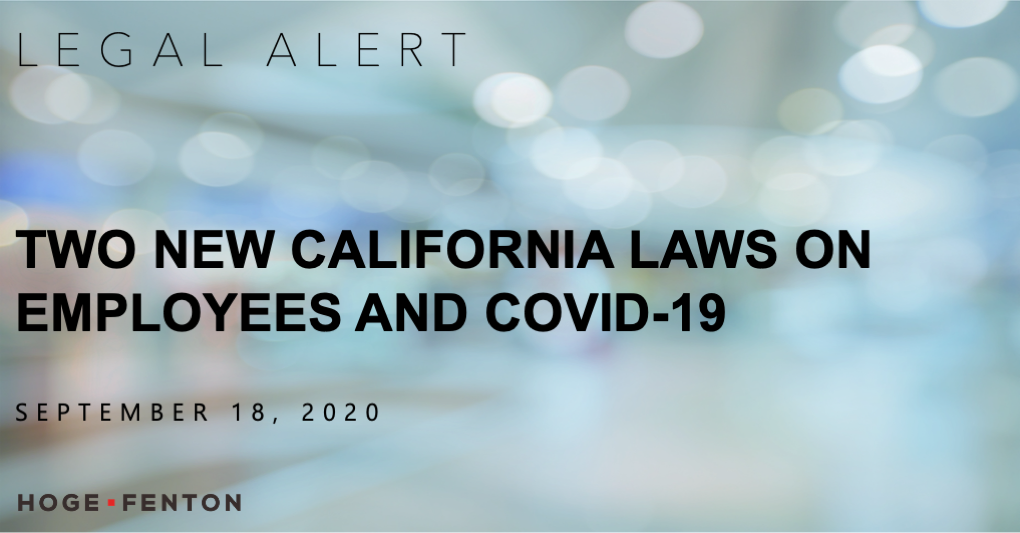
by Sarju Naran, Shareholder and Chair, Employment Law Group
On September 17, 2020, Gov. Gavin Newsom signed two employment law bills pertaining to COVID-19: Senate Bill (SB) 1159 and Assembly Bill (AB) 685.
SB 1159
As many employers recall, Governor Newsom signed a 60-day Executive Order in May 2020 that created a rebuttable presumption that employees who tested positive for COVID-19 within 14 days of being at a worksite had a workers’ compensation claim. The order expired on July 5, 2020, leading employers to believe that the burden had shifted back to employees to establish that they were infected with COVID-19 in the course of their employment. SB 1159 now affords employees the same rebuttable presumption retroactive to July 6, 2020 and extending through January 1, 2023, but only if the company has 5 or more employees, and only if the employee tests positive for COVID-19 during an “outbreak” at the employee’s worksite. SB 1159 defines “outbreak” based on employee headcount: (1) for employers with 100 or fewer employees at the worksite, an outbreak means 4 or more employees test positive within a 14-day period; (2) for employers with more than 100 employees at the worksite, an outbreak means at least 4% of the employees test positive within a 14-day period.
SB 1159 also extends the rebuttable presumption to first responders and employees in the health care field.
Employers can submit evidence to attempt to rebut the presumption, including but not limited to, “evidence of measures in place to reduce potential transmission of COVID-19 in the employee’s place of employment and evidence of an employee’s nonoccupational risks of COVID-19 infection.”
SB 1159 also requires employers with 5 or more employees to notify their workers’ compensation carrier within 30 days from the passage of the law about employees who have tested positive since July 6, 2020; going forward, employers are required to report positive tests within 3 days of being notified of an employee’s positive test.
Because SB 1159 was passed as an emergency measure, it is effective immediately.
AB 685
AB 685 requires employers to notify all employees within 1 business day if the employer receives notice that an employee at the worksite was potentially exposed to COVID-19. Employers are also required to provide the employees with “information regarding COVID-19-related benefits to which the employee may be entitled under applicable federal, state, or local laws, including, but not limited to, workers’ compensation, and options for exposed employees, including COVID-19-related leave, company sick leave, state-mandated leave, supplemental sick leave, or negotiated leave provisions, as well as anti-retaliation and anti-discrimination protections of the employee.” Employers must also provide notice of the disinfection and safety plan that the employer plans to implement and complete per the guidelines of the federal Centers for Disease Control.
Additional notice is required if the employees belong to a union and have an exclusive representative.
Further, employers must also notify local public health officials within 48 hours if the number of positive cases meets the State Department of Public Health’s definition of an “outbreak.”
Have a dispute with an employee, or questions regarding employees and COVID-19?
Contact our Employment Law Group at info@hogefenton.com.
Meet Our Employment Law Group
 |
Sarju Naran is a zealous advocate for his clients and approaches litigation with creativity and strategy. Chair of Hoge Fenton’s Employment Law Group, Sarju’s experience spans from representing middle-market and family-owned closely held businesses to large multi-national companies. He regularly litigates and provides advice and counsel to companies on wage and hour issues, trade secret misappropriation, employee mobility, wrongful termination, performance management, and leaves of absence. |
 |
Jenn Protas helps employers navigate California’s numerous employment laws and defends employers with an eye toward successful, yet cost-effective resolution. Jenn is a committed advocate for her clients and a tenacious litigator. She defends employers on matters related to wage and hour law, wrongful termination, harassment, discrimination, and retaliation in single-plaintiff litigation, Private Attorney General Act actions, and/or class actions. Jenn’s practice also includes housing discrimination matters and business litigation. |
 |
Embert Madison, Jr. focuses on employment advice and counsel, cannabis regulation, and real estate matters. He has represented clients throughout California. Embert spent several years as an attorney in the California Capitol. During this time, he “toed the political ropes” in the areas of employment, taxation and real estate for a California Assembly Member and served in the Office of Legislative Counsel. |
 |
Ashlee Cherry is an experienced litigator and represents clients with employment law needs ranging from wage and hour disputes and wrongful termination to disability and leave matters. Ashlee is a board member of the Santa Clara County Employer Advisory Council (EAC). |
 |
Laura Riparbelli aggressively litigates employment law disputes. Laura has handled all aspects of litigation from start to finish, including second chairing three bench trials. She regularly prepares and argues challenges to initial pleadings, discovery disputes, and dispositive motions. Laura adeptly navigates all facets of the written and oral discovery process. |
This information is provided as an educational service by Hoge Fenton for clients and friends of the firm. This communique is an overview only, and should not be construed as legal advice or advice to take any specific action. Please be sure to consult a knowledgeable professional with assistance with your particular legal issue. © 2020 Hoge Fenton
08.25.2020 | Speaking Engagements & Firm Events
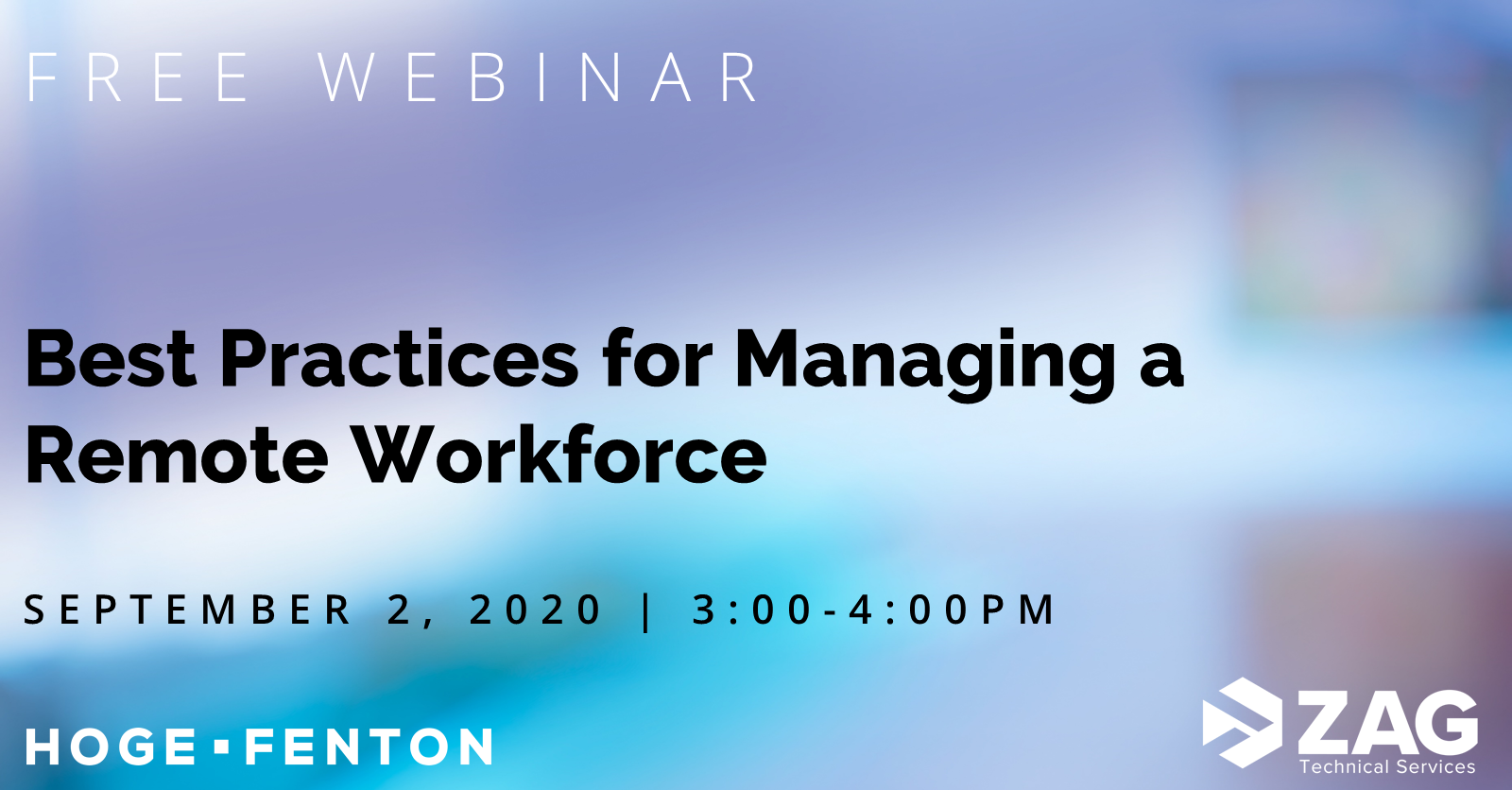
Managing a remote workforce presents unique challenges. With the unexpected shift to working from home when the shelter-in-place orders went into effect, most employers did not have time to consider the risks and put safeguards in place. However, as remote working becomes an ongoing and potentially long-term option, employers should take the time to consider several issues our advisors will discuss in the webinar below:
- The legal risks of managing a remote workforce
- Best practices employers should have in place to manage those risks and otherwise comply with laws
- How employers can secure their confidential information with a remote workforce
Meet our Trusted Advisors
 |
Sarju Naran is a zealous advocate for his clients and approaches litigation with creativity and strategy. Chair of Hoge Fenton’s Employment Law Group, Sarju’s experience spans from representing middle-market and family-owned closely held businesses to large multi-national companies. He regularly litigates and provides advice and counsel to companies on wage and hour issues, trade secret misappropriation, employee mobility, wrongful termination, performance management, and leaves of absence. |
 |
Stephanie O. Sparks is a shareholder and chairs the firm’s Privacy & Data Security team. She counsels companies on privacy laws and helps them develop and implement administrative, technical, and physical safeguards for data security. Stephanie also provides privacy and data security awareness training; prepares privacy, bring your own device and other privacy-related company policies, record retention/destruction schedules, and data breach incident response plans; and drafts and negotiates data processing agreements, and other agreements involving privacy, data transfers and data protection. |
 |
As Development Director of ZAG Technical Services, Joe Foos leads the firm’s new partnerships and alliances with client industry associations, vendor peer groups, and community organizations. He enables clients to succeed by advising them on how to leverage technology for a competitive advantage. For over 25 years, Joe has worked with organizations in the Silicon Valley Bay Area and beyond, always starting with asking why a choice is being made, before helping with the mechanics of how to support or change a decision, for a better outcome. |
 |
Hon. Catharine Baker will be moderating the discussion. She is currently Special Counsel at Hoge Fenton in Pleasanton, California. Catharine was a Member of the California State Assembly for the 16th District from 2014 – 2018. During her legislative tenure, Catharine developed a reputation as an independent, bipartisan voice in the CA Legislature, fostering collaboration that led to breakthroughs in significant legislation, particularly on transportation, the environment, and government accountability. |
This information is provided as an educational service by Hoge Fenton for clients and friends of the firm. This communique is an overview only, and should not be construed as legal advice or advice to take any specific action. Please be sure to consult a knowledgeable professional with assistance with your particular legal issue. © 2020 Hoge Fenton
07.20.2020 | Firm Post
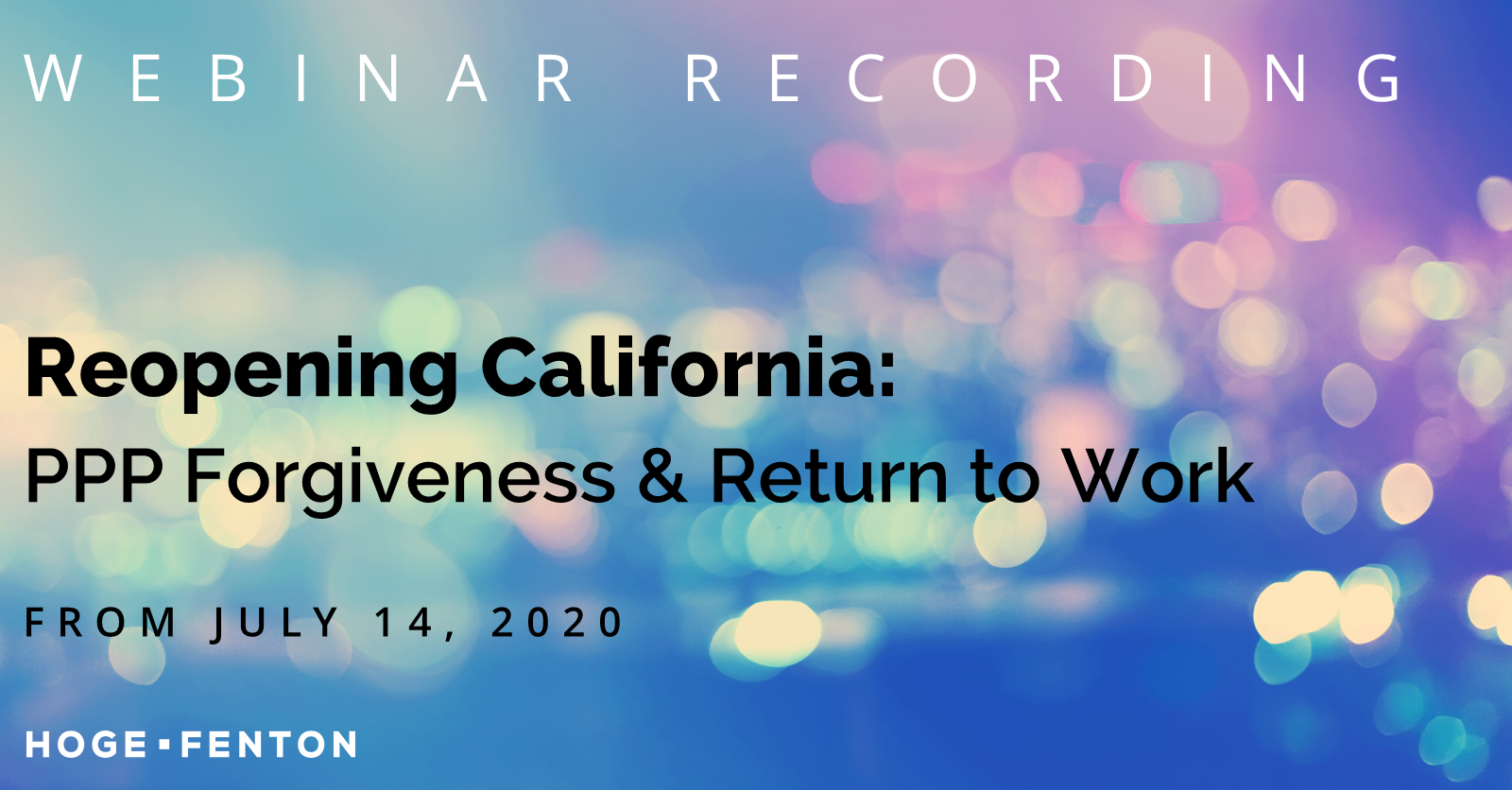
Thank you to everyone who joined us for our Reopening California webinar with The Silicon Valley Organization and Bozzuto Insurance Services. Please click below to watch the recorded webinar.
We hope you found the discussion with our panelists helpful. Please reach out to our advisors below if you need additional guidance.

Shareholder, Chair
Employment Law
Hoge Fenton
+1.408.947.2456
|
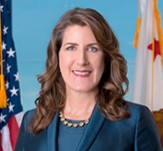
Former Assemblywoman
Special Counsel
Hoge Fenton
+1.925.224-7780
|
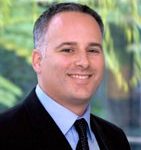
Partner
Assurance & Advisory
Frank Rimerman + Co. LLP
+1.415.439.1147
|

Commercial Insurance Broker
Bozutto Insurance Services
+1.408.680.0253
|
This information is provided as an educational service by Hoge Fenton for clients and friends of the firm. This communique is an overview only, and should not be construed as legal advice or advice to take any specific action. Please be sure to consult a knowledgeable professional with assistance with your particular legal issue. © 2020 Hoge Fenton
07.07.2020 | Speaking Engagements & Firm Events
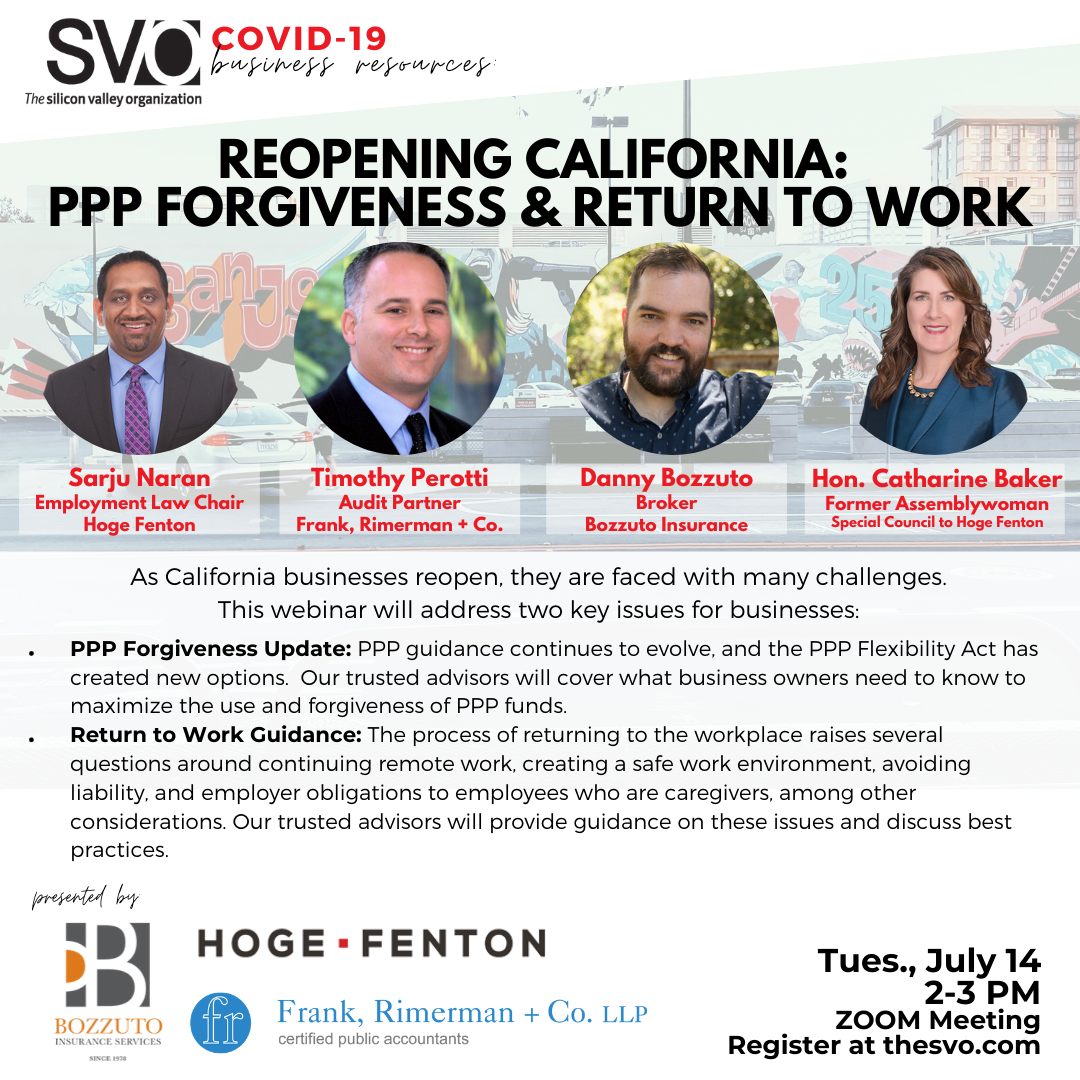
Meet Our Trusted Advisors
 |
Sarju Naran is a zealous advocate for his clients, and approaches litigation with creativity and strategy. Chair of Hoge Fenton’s Employment Law Group, Sarju’s experience spans from representing middle-market and family-owned closely held businesses to large multi-national companies. He regularly litigates and provides advice and counsel to companies on wage and hour issues, trade secret misappropriation, employee mobility, wrongful termination, performance management, and leaves of absence. |
 |
Timothy Perotti is the partner in charge of the Assurance and Advisory Practice at Frank, Rimerman + Co. LLP. Working primarily out of the San Francisco and Palo Alto offices. TIm’s expertise includes revenue recognition, equity accounting, and mergers and acquisition transactions. He has over 20 years of experience providing technical accounting, financial reporting, and advisory services to businesses in the professional service, manufacturing, distribution, software, and high-technology industries. |
 |
Hon. Catharine Baker is currently Special Counsel at Hoge Fenton in Pleasanton, California. Catharine was a Member of the California State Assembly for the 16th District from 2014 – 2018. During her legislative tenure, Catharine developed a reputation as an independent, bipartisan voice in the CA Legislature, fostering collaboration that led to breakthroughs in significant legislation, particularly on transportation, the environment, and government accountability. |
 |
Danny Bozzuto has been a broker at Bozzuto & Associates Insurance Services since 2010. Danny developed Bozzuto’s Human Resources Services and Technology programs in the Bay Area and Southern California. He has served on advisory committees, participated as a panelist for risk management, and developed exclusive programs for Bozzuto. Danny has also taken on an additional role of maintaining Bozzuto’s carrier relations. |
This information is provided as an educational service by Hoge Fenton for clients and friends of the firm. This communique is an overview only, and should not be construed as legal advice or advice to take any specific action. Please be sure to consult a knowledgeable professional with assistance with your particular legal issue. © 2020 Hoge Fenton
07.02.2020 | Firm Post
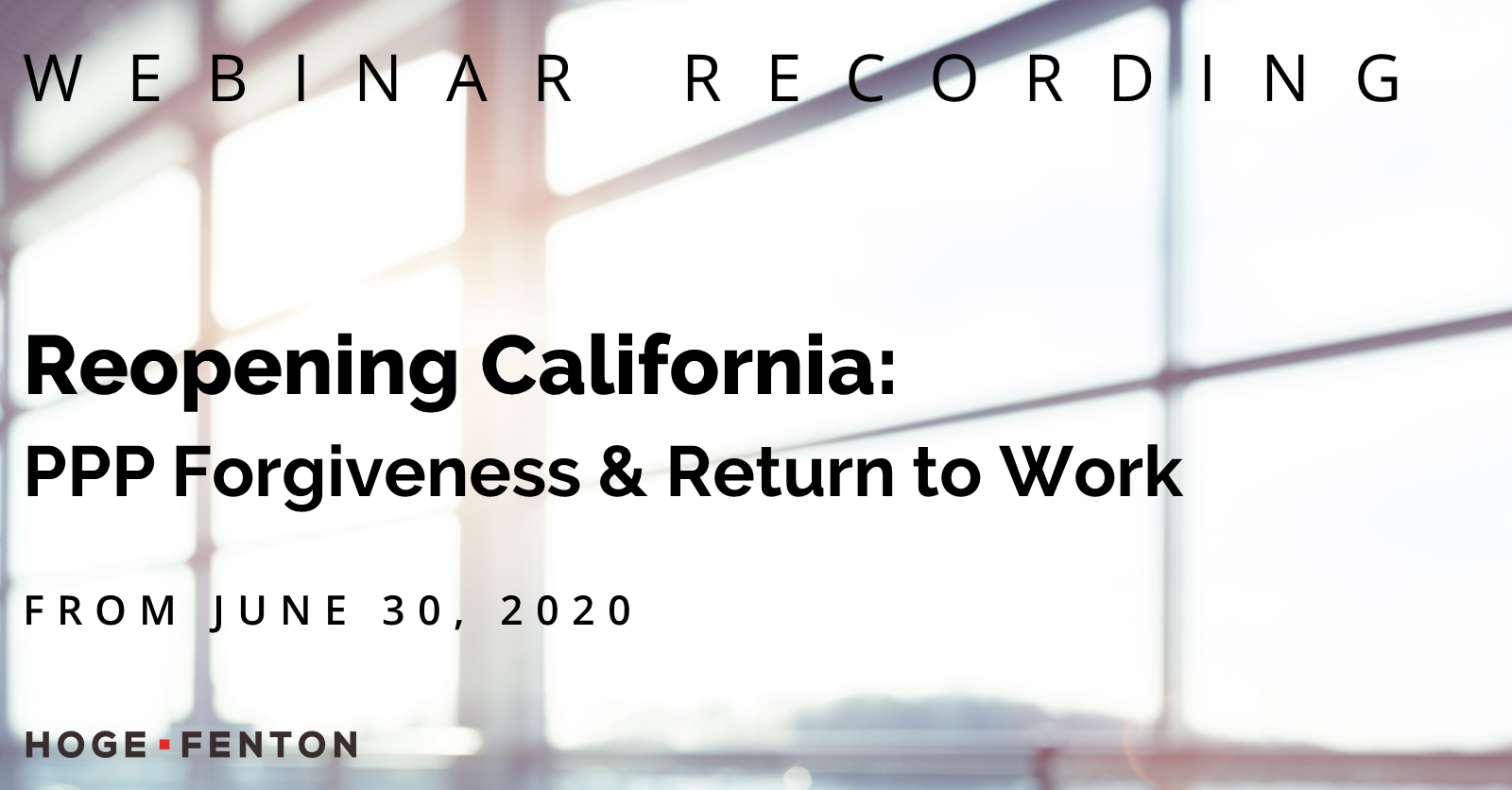
Thank you to everyone who attended our Reopening California webinar on June 30, 2020 with Hoge Fenton Employment Law Chair Sarju Naran, Frank, Rimerman + Co. LLP Audit Partner Tim Perotti, and President of Kabateck Strategies and California State Director of the National Federation of Independent Business, John Kabateck. Please click below to watch the recorded webinar.
We hope you found the discussion with our panel helpful. Please do not hesitate to reach out to webinars@hogefenton.com if you need more guidance and visit our Reopening California Resources page for additional support.
 |
 |
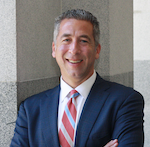 |
|
Shareholder, Chair
Employment Law
Hoge Fenton
+1.408.947.2456
|
Partner
Assurance & Advisory
Frank Rimerman + Co. LLP
+1.415.439.1147
|
President
Kabateck Strategies
CA State Director – NFIB
+1.916.647.5592
|
This information is provided as an educational service by Hoge Fenton for clients and friends of the firm. This communique is an overview only, and should not be construed as legal advice or advice to take any specific action. Please be sure to consult a knowledgeable professional with assistance with your particular legal issue. © 2020 Hoge Fenton
06.19.2020 | Speaking Engagements & Firm Events
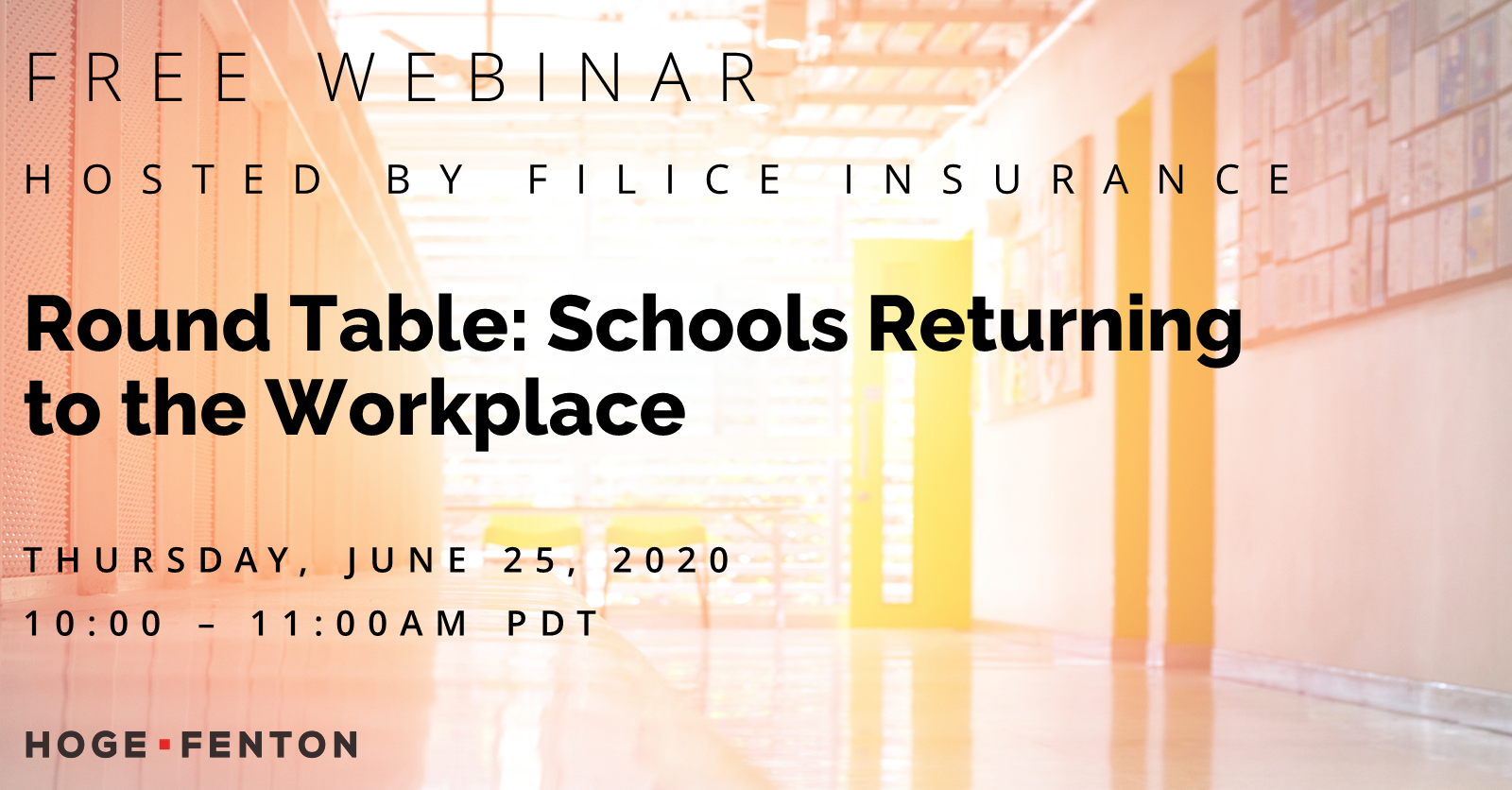
If you are a school administrator with 50+ employees, please join this roundtable discussion on returning employees to the workplace with Hoge Fenton Employment Law Chair Sarju Naran, Nathalie McManamon from Filice Insurance Agency, and Jennifer Anderson from Bozzuto & Associates Insurance Services on June 25th.
06.19.2020 | Firm Post
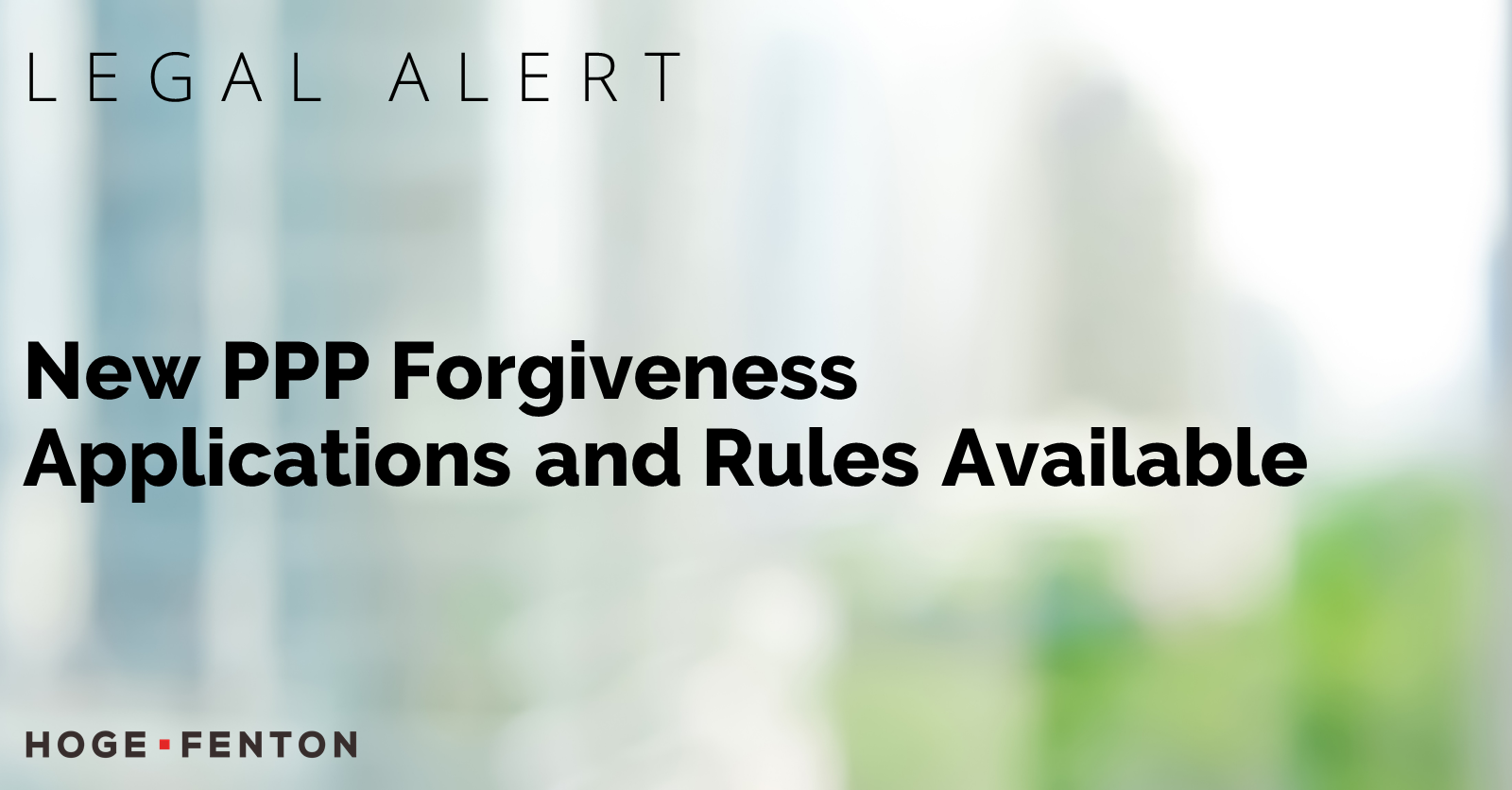
On June 16, 2020, the U.S. Small Business Administration (“SBA”) released:
- an updated Loan Forgiveness Application, and
- an Alternative Loan Forgiveness Application for certain borrowers to implement the PPP Flexibility Act (“PPP Flex”), and
- a revised interim final rule (the “IFR”) on June 17, 2020 implementing changes from the PPP Flex.
The updated Loan Forgiveness Application covers the following changes:
- Alternative Payroll Covered Period applies to the 24-week (168-day) covered period; provided the Alternative Payroll Covered Period does not extend beyond December 31, 2020. Note: if a Borrower received its PPP loan before June 5, 2020, the Borrower may elect to use an eight-week (56-day) covered period.
- Clarifies one of the Full Time Employee (FTEs) reduction exceptions: A position will not be included in the calculation if the Borrower made a good-faith, written offer to rehire an employee who was employee on February 15, 2020 AND the Borrower was unable to hire similarly qualified employees for unfilled positions on or before December 31, 2020.
- Changes the documentation required for FTEs from the average number of FTEs per month to the average number of FTEs per week.
- Employer health insurance and retirement contributions for business owners: employer health insurance and employer retirement contributions on behalf of a self-employed individual, general partners, or owner-employees of an S-corporation should not be included in the health insurance expenditures calculation or retirement expenditures calculation, respectively.
A copy of the updated application is here and the instructions are here.
A shortened version of the forgiveness application is available for the following borrowers:
- Self-employed, independent contractors, or sole proprietors with no employees;
- Borrowers who did not reduce salaries by more than 25% during the covered period and did not reduce the number of employees or the average paid hours of employees from January 1, 2020 to the end of the Covered Period (ignoring reductions from the safe harbor related to an inability to hire qualified employees, and reductions due to an employee refusing to accept a restoration of hours); and
- Borrowers who did not reduce salaries by more than 25% during the covered period and were unable to operate during the covered period at the same level of business activity due to COVID-19 related safety requirements promulgated by the CDC, HHS, or OSHA.
The Alternative Loan Forgiveness Application is here and the instructions are here.
The SBA also released a revised interim final rule (the “IFR”) on June 17, 2020 implementing changes from the PPP Flex. The IFR provides the following:
Increases the cap on individual employees’ salaries from $15,385 during the 8-week covered period to $46,154 during the 24-week covered period.
Increases the cap on owner compensation from $15,835 during the 8-week covered period, to $20,833 for a 24-week covered period.
For sole proprietors: business mortgage payments, business rent payments, and business utility payments, as listed on Form 1040 Schedule C, are now included as amounts eligible for forgiveness.
Loan forgiveness amount cap: the amount of loan forgiveness is capped by the full principal amount of the loan plus accrued interest.
A copy of the IFR can be found here.
Our experienced team of attorneys are available to further assist you with any more questions or concerns you may having regarding PPP Forgiveness and PPP Flex.
 |
 |
 |
|
Of Counsel
Corporate & Bus Law
+1.925.460.3367
|
Shareholder/Chair
Estates & Trusts
+1.408.947.2437
|
Attorney
Corporate & Bus Law
+1.925.460.3370
|
 |
 |
|
Shareholder, Chair
Employment Law
+1.408.947.2456
|
Shareholder
Real Estate & Commercial
+1.925.460.3365
|
This information is provided as an educational service by Hoge Fenton for clients and friends of the firm. This communique is an overview only, and should not be construed as legal advice or advice to take any specific action. Please be sure to consult a knowledgeable professional with assistance with your particular legal issue. © 2020 Hoge Fenton
06.17.2020 | Speaking Engagements & Firm Events
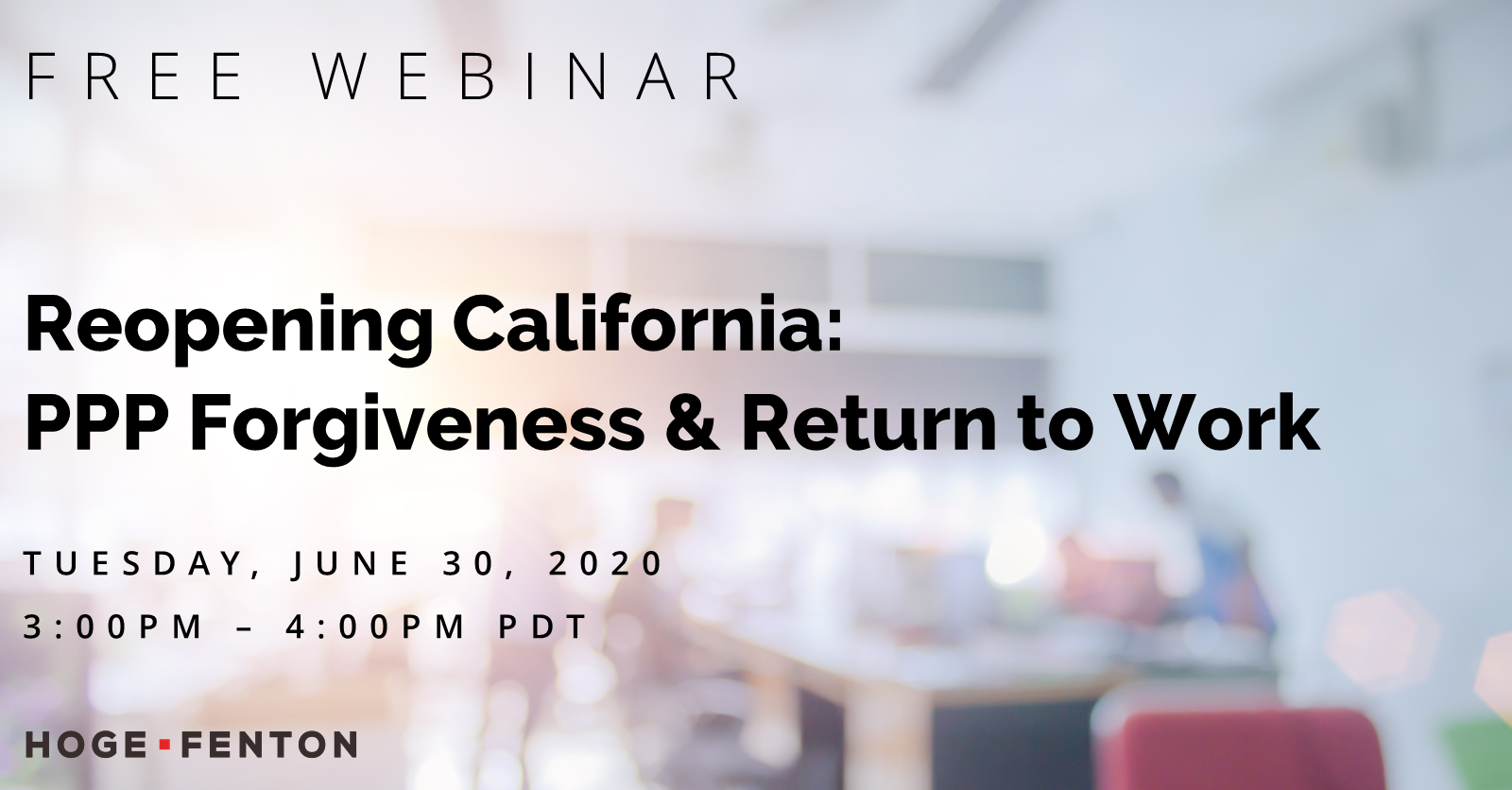
As California businesses reopen, they are faced with many challenges. This webinar will address two key issues for businesses:
- PPP Forgiveness Update: PPP guidance continues to evolve, and the PPP Flexibility Act has created new options. Our trusted advisors will cover what business owners need to know to maximize the use and forgiveness of PPP funds.
- Return to Work Guidance: The process of returning to the workplace raises several questions around continuing remote work, creating a safe work environment, avoiding liability, and employer obligations to employees who are caregivers, among other considerations. Our trusted advisors will provide guidance on these issues and discuss best practices.
Meet Our Trusted Advisors
 |
Sarju Naran is a zealous advocate for his clients, and approaches litigation with creativity and strategy. Chair of Hoge Fenton’s Employment Law Group, Sarju’s experience spans from representing middle-market and family-owned closely held businesses to large multi-national companies. He regularly litigates and provides advice and counsel to companies on wage and hour issues, trade secret misappropriation, employee mobility, wrongful termination, performance management, and leaves of absence. |
 |
Timothy Perotti is the partner in charge of the Assurance and Advisory Practice at Frank, Rimerman + Co. LLP. Working primarily out of the San Francisco and Palo Alto offices, TIm’s expertise includes revenue recognition, equity accounting, and mergers and acquisition transactions. He has over 20 years of experience providing technical accounting, financial reporting, and advisory services to businesses in the professional service, manufacturing, distribution, software, and high-technology industries. |
 |
John Kabateck is the owner and president of Kabateck Strategies, a full scale public affairs firm specializing in strategic position, coalition development and engagement and issue advocacy campaigns to help clients achieve their goals. John has been raising the relevance of people, associations, and causes with the California policymakers who shape their future for more than a quarter of a century. He was recruited by America’s voice of small business, the National Federation of Independent Business, as its California state director. |
This information is provided as an educational service by Hoge Fenton for clients and friends of the firm. This communique is an overview only, and should not be construed as legal advice or advice to take any specific action. Please be sure to consult a knowledgeable professional with assistance with your particular legal issue. © 2020 Hoge Fenton
06.08.2020 | Firm Post

A breath of fresh air for PPP borrowers! The Senate unanimously passed the “Paycheck Protection Program Flexibility Act of 2020” (H.R. 7010) (the “PPP Flex”) on Wednesday (6/3) evening and the President signed it into law today. The PPP Flex addresses many concerns with the PPP loan program and relaxes some of the requirements in the original PPP program. We expect the Treasury and the SBA to issue more guidance on the PPP Flex in the near future. Although the PPP Flex offers some relief and clarity, there are new considerations. Borrowers who already plan on using the PPP funds within the original 8 week covered period can choose to do so and may decide to request loan forgiveness as soon as possible. Below is a list of major changes covered in the PPP Flex bill:
| Update | PPP / Initial SBA Guidance | PPP Flex |
|
1) Extended Loan Forgiveness Covered Period
|
8 weeks (56 days) from receipt of loan proceeds, or from first date of payroll period after receipt of loan proceeds for those eligible to apply “Alternative Payroll Covered Period”. |
Earlier of 24 weeks or December 31, 2020. Borrowers who received a PPP loan before the date of the enactment of PPP Flex may retain the 8 week covered period.
|
| 2) Lower Payroll Cost Percentage Requirement | At least 75% of loan proceeds must be spent on eligible payroll costs, otherwise the loan forgiveness amount will be proportionally reduced. |
At least 60% of loan proceeds must be spent on eligible payroll costs. This now appears to be a cliff. (i.e., a Borrower who spends only 59% on eligible payroll costs will receive no forgiveness)*
[* Note: Subject to SBA regulation to determine if it is a cliff, but the current statutory language suggests it is a cliff ]
|
| 3) Extended Reduction in Work Force Safe Harbor Rehire Date | June 30th deadline to rehire employees separated between February 15, 2020 and April 26, 2020, to avoid a reduction in loan forgiveness. | December 31, 2020 deadline to rehire employees separated between February 15, 2020 and April 26, 2020, to avoid a reduction in loan forgiveness. |
| 4) New Exceptions for Borrowers who do not hire/rehire workers before the Rehire Date | No reduction in loan forgiveness if the Borrower offers reemployment and workers reject the offer to return to work. |
New exceptions (in addition to the prior exception) if the Borrower:
|
| 5) Longer Repayment Period | 2 years | 5 years (for loans after the enactment of PPP Flex; existing PPP borrowers might ask lenders to extend the loan. |
| 6) Deferral of Employer Share of Payroll Taxes | Not available for a Borrower who had the PPP loan forgiven. | Available for all PPP borrowers regardless of forgiveness status; allows Borrowers to defer payment of 50% of payroll taxes until 2021, with the remaining 50% due in 2022. |
Our experienced team of attorneys are available to further assist you with any more questions or concerns you may having regarding the Paycheck Protection Program Flexibility Act of 2020.
 |
 |
 |
|
Of Counsel
Corporate & Bus Law
+1.925.460.3367
|
Shareholder/Chair
Estates & Trusts
+1.408.947.2437
|
Attorney
Corporate & Bus Law
+1.925.460.3370
|
 |
 |
|
Shareholder, Chair
Employment Law
+1.408.947.2456
|
Shareholder
Real Estate & Commercial
+1.925.460.3365
|
This information is provided as an educational service by Hoge Fenton for clients and friends of the firm. This communique is an overview only, and should not be construed as legal advice or advice to take any specific action. Please be sure to consult a knowledgeable professional with assistance with your particular legal issue. © 2020 Hoge Fenton
06.04.2020 | Firm Post
We are Here to Help
Hoge Fenton understands that our clients, employers, and organizations may have numerous questions and concerns about reopening their business. As you begin to face the business and legal implications of the COVID-19 crisis, our attorneys remain committed to assisting you overcome these obstacles.
To provide some guidance on some of the issues that have affected or will be affecting businesses, we have created a Reopening California resources page to support you in the following areas:
- Bankruptcy Information
- Corporate & Business Law
- Employment Law
- Family Law Counseling & Litigation
- Intellectual Property
- Real Estate and Land Use
- Tax/Trusts & Estates
This information is provided as an educational service by Hoge Fenton for clients & friends of the firm. This communique is an overview only, & should not be construed as legal advice or advice to take any specific action. Please be sure to consult a knowledgeable professional with assistance with your particular legal issue. © 2020 Hoge Fenton
05.27.2020 | Firm Post
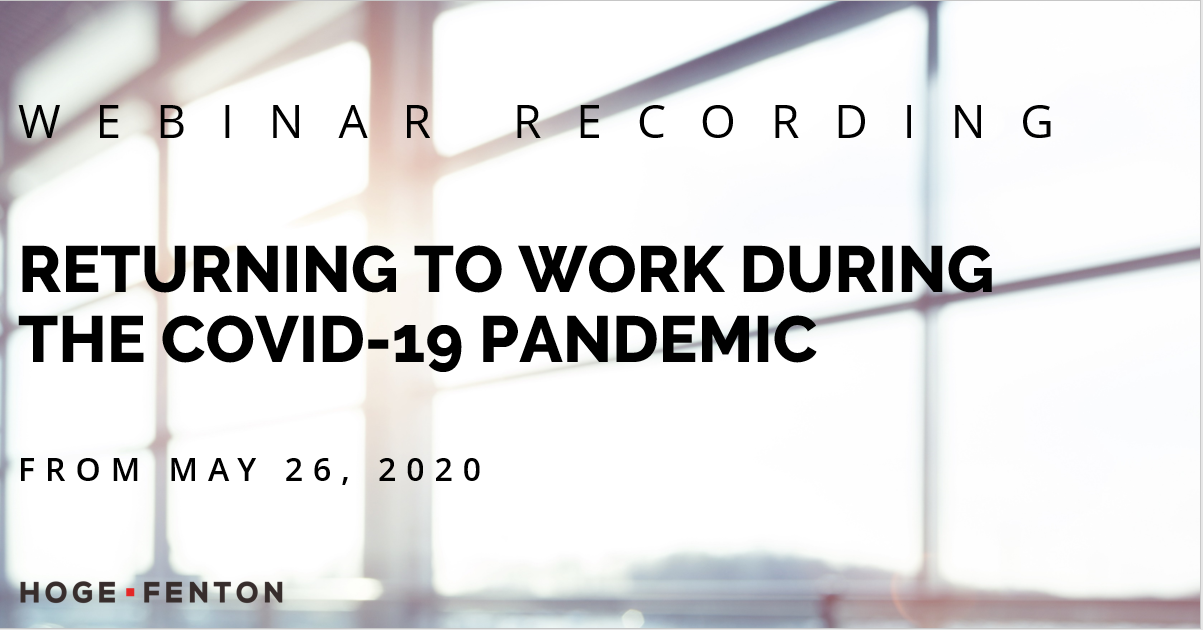
Thank you to everyone who joined us for our “Returning to Work During the COVID-19 Pandemic” webinar. Please click below to watch the recorded webinar.
We hope you found the discussion with Employment Law Chair, Sarju Naran helpful during this unprecedented time. Please reach out to our advisors below if you need more guidance and visit our COVID-19 Resources page for additional support.
 |
 |
 |
|
Chair & Shareholder
+1.408.947.2456
|
Shareholder
+1.408.947.2435
|
Attorney
+1.408.947.2457
|
This information is provided as an educational service by Hoge Fenton for clients and friends of the firm. This communique is an overview only, and should not be construed as legal advice or advice to take any specific action. Please be sure to consult a knowledgeable professional with assistance with your particular legal issue. © 2020 Hoge Fenton
05.26.2020 | Firm Post
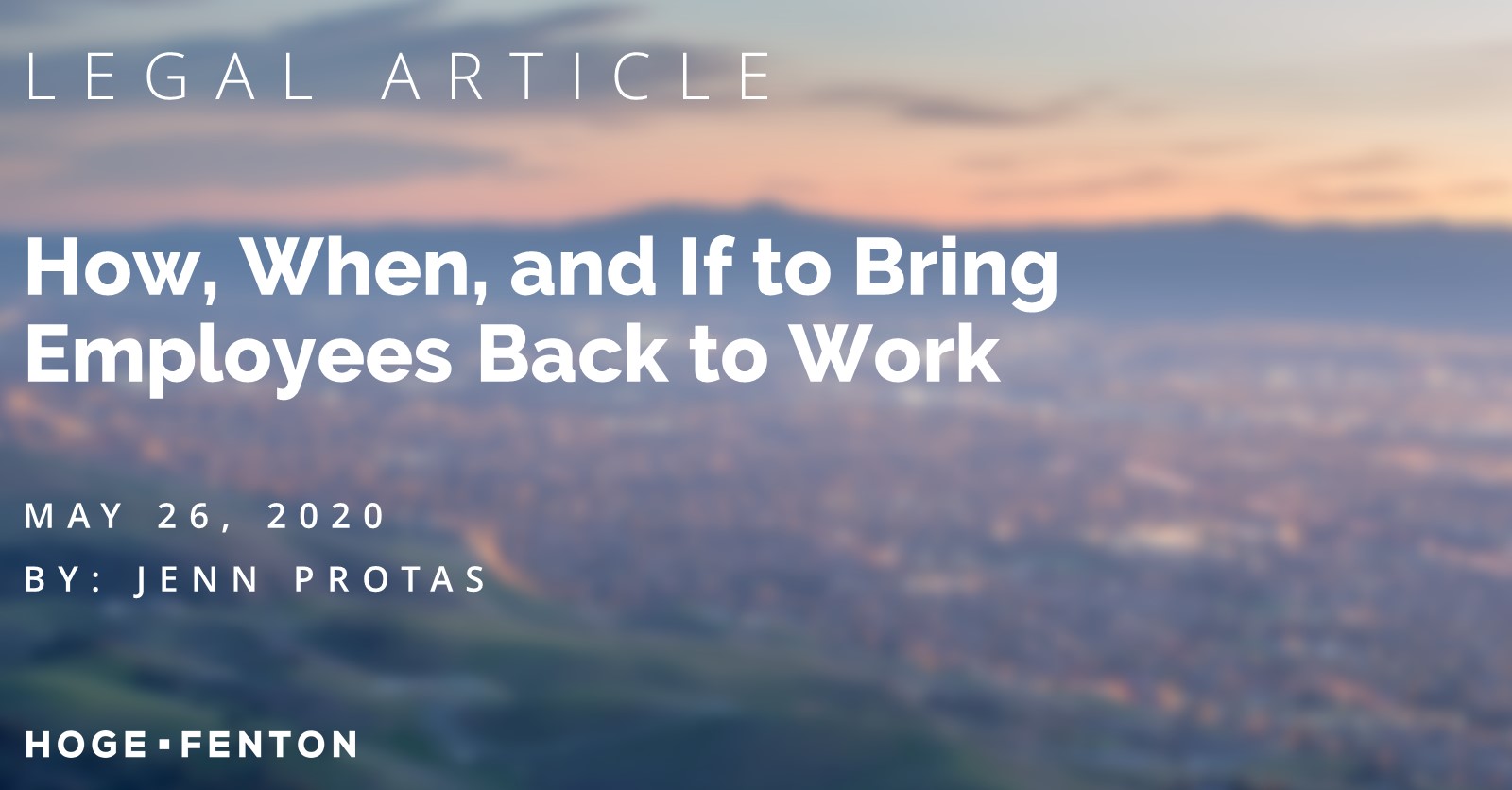
This paper is provided as an educational service. It is an overview only, and should not be construed as legal advice or advice to take any specific action. If you have questions regarding any of the content contained in this presentation, we recommend you seek the assistance of a knowledgeable legal professional.
California employers’ concerns regarding the coronavirus pandemic have come in waves:
- initial concerns over health and safety
- the impact of county and state shelter-in-place orders
- whether each business was an essential business
- whether and how to furlough or lay off employees
- compliance with the FFCRA
- whether businesses qualify for a PPP loan and how to maximize forgiveness
Employers are now shifting their focus to how, when, and if to bring employees back to work.
In considering these issues, employers should be mindful to protect themselves against lawsuits, including what we anticipate will be a flood of class action lawsuits by employees.
Working From Home
Where feasible, employers will likely have some employees continue to work from home, if only to enable social distancing at the worksite.
Managing a remote workforce comes with its challenges, regardless of the circumstances. When the shelter-in-place orders went into effect, employers moved quickly to shift to working from home. Most employers did not have time to consider the risks and to put safeguards in place. However, as remote working becomes an ongoing and potentially long-term option, employers should ask remote employees to enter into a Work From Home Agreement, which can address issues such as:
- protecting the security of your company’s confidential property and information,
- managing employee availability and work hours
- designating a worksite to mitigate workers’ compensation exposure
- other relevant issues
Recommendation:
Employers should ask remote employees to enter into a Work From Home Agreement.
Working from home does not eliminate employers’ wage and hour obligations to provide timely, compliant meal periods, adequate rest breaks, and pay for all hours worked. It may be even more tempting for employees to not record their time. For instance, an employee could easily check their email off-hours and not record their time because they are trying to work while also caring for and homeschooling their children. Wage and hour claims are frequently the source of class actions and Private Attorney General Act claims.
Recommendation:
To the extent possible, employers should communicate clearly with non-exempt employees regarding timekeeping practices, meal periods and rest breaks, and off the clock work. Employers should also continue to monitor employee time records to manage these issues.
Employers should also determine whether any municipal ordinances in cities where remote employees live (and therefore work) require that you modify your sick leave accruals and balances, minimum wages, or grant employees additional leaves of absence or benefits. San Francisco, for example, has a Family Friendly Workplace Ordinance, which gives eligible employees the right to request a flexible or predictable work arrangement to assist with care for elderly parents, persons with serious health conditions, and children under the age of 18.
Recommendation:
- Create a list of cities where employees live.
- Check the cities’ municipal ordinances to determine if modifications are necessary to your policies, including, for example, sick leave accruals and balances, minimum wages, or leaves of absence or benefits.
Employers also have an obligation to reimburse employees for all necessary and reasonable business expenses. If employees are working from home for the employer’s benefit, employees may have a right to reimbursement of all sorts of expenses, including their home internet costs, increased utility fees, and possibly even light bulbs, batteries, and toilet paper!
Recommendation:
- Determine whether employees are working from home for your company’s benefit.
- For those employees working from home for your company’s benefit, contact an employment attorney to determine what expenses may be reimbursable.
If employers do have to separate employees who are remote, employers should prepare in advance to ensure they can timely pay final wages. California requires final wages be paid within 24 hours of the separation (essentially, the same day) when the employer terminates the employment relationship. That’s more challenging when you cannot simply hand your employee a check and walk them out the door.
Returning to Work
The most pressing concern for employers who are working to bring employees back to work once state and county orders permit is do follow all guidance and requirements for social distancing protocols (Bay Area counties, for instance, require employers to post a “Social Distancing Protocol” at each facility substantially in the form of Appendix A to the Shelter-in-Place Order), provide proper protective equipment, ramp up disinfecting practices, screen employees for symptoms, and otherwise provide for the health and safety of their employees (and customers, if permitted by county and state orders). The state has issued guidance by industry. California Governor Gavin Newsom signed an executive order creating a rebuttable presumption that employees who contract COVID-19 are entitled to workers’ compensation benefits if the employee tested positive for or was diagnosed with COVID-19 within 14 days after a day (on or after March 19, 2020) that the employee performed labor or services at the employee’s place of employment (and not the employee’s home or residence) at the employer’s direction.
Employers who are screening employees’ symptoms and temperatures should be careful to avoid retaining and disclosing medical information so as not to run afoul of privacy rights. Taking employee temperatures is, in “normal” times, an impermissible medical examination, but the EEOC has permitted taking employee temperatures during the current pandemic.
Even with all the precautions, some employees may be unwilling to return to work. While ordinarily employers have the right to discipline and/or terminate employees who refuse to work, employers may not do so if employees have a good faith believe that there is a real danger of death or serious injury and meet various conditions, including asking the employer to eliminate the danger. Even if such fear is not credible, employees may have a mental disability, such as anxiety, which employers may need to accommodate.
Recommendation:
- Follow all guidance and requirements for social distancing protocols (Bay Area counties, for instance, require employers to post a “Social Distancing Protocol” at each facility substantially in the form of Appendix A to the Shelter-in-Place Order).
- Provide proper protective equipment.
- Ramp up disinfecting practices.
- Create a procedure to screen employees for symptoms that preserves employees’ privacy rights
- Otherwise provide for the health and safety of your employees (and customers, if permitted by county and state orders).
- Review the state’s guidance by industry for additional clarification for your industry.
- Consider your response to employees want to continue to work from home and not return to the workplace.
Other Potential Legal Landmines
Employers face other threats of litigation:
- Harassment, Discrimination, and Retaliation. Reports of mistreatment or harassment of Asian-Americans is on the rise and may lead to an increase in harassment and discrimination claims on the basis of race. Further, layoffs, furloughs, reductions in pay, and hiring/re-hiring employees give rise to risks of harassment, discrimination, and retaliation claims where decisions have a disparate impact on employees of a protected class or where employees are treated differently on the basis of protected class (e.g., treating high-risk employees, such as those with disabilities or older employees, differently than other employees).
- WARN/CalWARN. Furloughs and layoffs may also trigger WARN and CalWARN, statutes that require employers provide advance notice to employees of terminations.
- Exempt Employees. As employers shuffle duties around to address having fewer people working, employers may jeopardize exempt employees’ classifications if they are no longer performing exempt tasks at least 50% of their time worked. Similarly, reducing exempt employee pay below the minimum salary threshold will result in a loss of the exemption.
- FFCRA and other leave statutes. Employers with fewer than 500 employees also have new obligations with respect to paid sick leave and expanded family and medical leave requirements under the Families First Coronavirus Response Act (FFCRA). And some jurisdictions have imposed additional temporary obligations on employers, even if they are not subject to the FFCRA.
Phew! With all that and more to consider, even the most well-intentioned employers can trip up, especially as they struggle to navigate this new territory we’re all facing. While you cannot eliminate all risk, relying on your employment law attorneys will help you mitigate risk as you move forward.
Please reach out to our advisors below if you need more guidance or visit Hoge Fenton’s COVID-19 Resources page.
 |
 |
|
Shareholder, Attorney
+1.408.947.2435
|
Shareholder, Chair
+1.408.947.2456
|
This information is provided as an educational service by Hoge Fenton for clients and friends of the firm. This communique is an overview only, and should not be construed as legal advice or advice to take any specific action. Please be sure to consult a knowledgeable professional with assistance with your particular legal issue. © 2020 Hoge Fenton
05.22.2020 | Firm Post
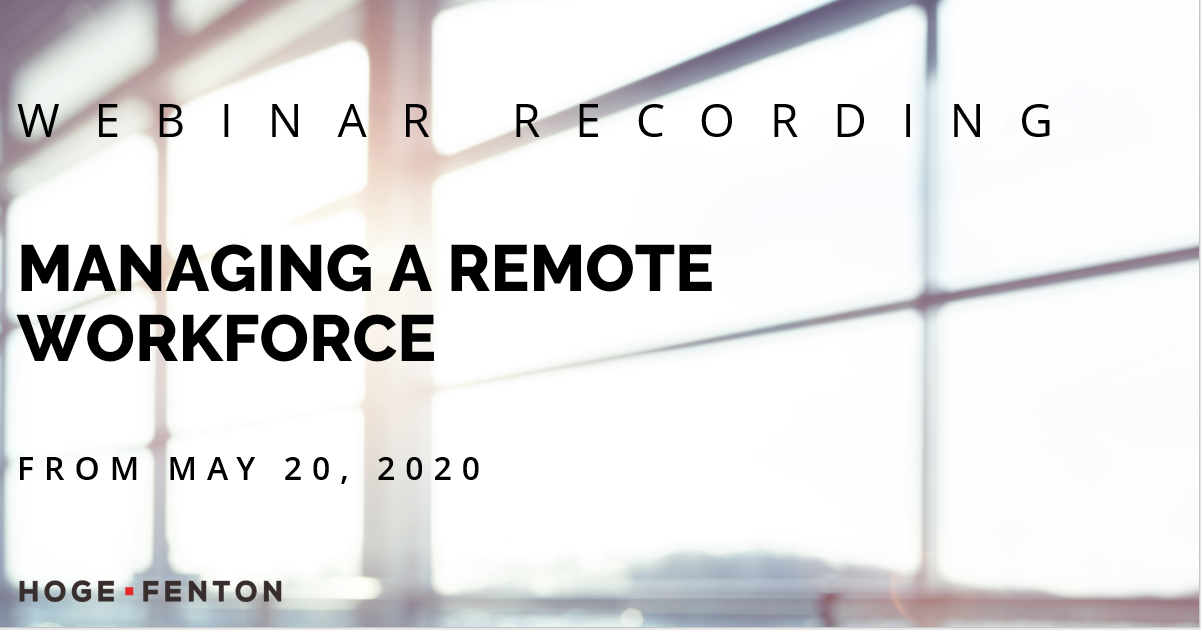
Thank you to everyone who joined us for our “Managing a Remote Workforce” webinar last Wednesday.
Please find the recording of the webinar below.
We hope you found the discussion helpful. Please reach out to our advisors below if you need more guidance and visit our COVID-19 Resources page for additional support.
 |
 |
 |
|
Chair & Shareholder
+1.408.947.2456
|
Shareholder
+1.408.947.2435
|
Attorney
+1.408.947.2457
|
This information is provided as an educational service by Hoge Fenton for clients and friends of the firm. This communique is an overview only, and should not be construed as legal advice or advice to take any specific action. Please be sure to consult a knowledgeable professional with assistance with your particular legal issue. © 2020 Hoge Fenton
05.19.2020 | Firm Post

On the evening of Friday, May 15, the SBA released long-awaited guidance for borrowers looking to claim forgiveness of their Paycheck Protection Program (“PPP”) loans.
The PPP Loan Forgiveness Application provides detailed instructions for borrowers to calculate the amount of their PPP loan forgiveness. The application has four parts:
- the PPP Loan Forgiveness Calculation Form;
- PPP Schedule A;
- the PPP Schedule A Worksheet; and
- an optional PPP Borrower Demographic Information Form.
Borrowers are required to submit the Calculation Form and PPP Schedule A to their lender.
What Costs are Eligible for Forgiveness?
The SBA’s guidance provides for four broad categories of costs that are eligible for forgiveness:
- payroll costs;
- business mortgage interest payments;
- business rent or lease payments; and
- business utility payments.
In accordance with prior guidance, the SBA requires that at least 75% of the forgiven amount be attributable to payroll costs.
Calculation of Eligible Payroll Costs for Forgiveness
The SBA’s guidance allows a PPP borrower to deduct payroll costs paid or incurred during the borrower’s eight-week (56 day) “Covered Period,” which is defined as the eight-week period that begins on the date the PPP loan was disbursed, or an Alternative Payroll Covered Period.
Alternative Covered Period
The strict eight-week Covered Period may not align with a borrower’s actual pay period. In these cases, the Alternative Covered Period may be used. The Alternative Payroll Covered Period allows Borrowers with a biweekly (or more frequent) payroll schedule to choose a 56 day period that begins on the first day of their first pay period following their PPP Loan Disbursement Date.
- Example: Borrower received its PPP loan proceeds on Monday, April 20. The first day of its first pay period following its PPP loan disbursement is Sunday, April 26. Therefore, the first day of the Alternative Payroll Covered Period is April 26 and the last day of the Alternative Payroll Covered Period is June 20 (a Saturday).
Borrowers who elect to use the Alternative Payroll Covered Period must apply the Alternative Payroll Covered Period wherever there is a reference in this application to “the Covered Period or the Alternative Payroll Covered Period.”
Note: The Alternative Payroll Covered Period applies to Payroll expenses only! Borrowers must apply the Covered Period (not the Alternative Payroll Covered Period) for other costs!
Date when Payroll Costs are Considered to be Paid
Payroll costs are considered paid on the day that paychecks are distributed or the day that the borrower originates an ACH credit transaction. Payroll costs are considered incurred on the day that the employee earned the pay. This distinction allows employers some flexibility in timing their use of PPP funds.
If a payroll cost is incurred but not paid during the borrower’s last pay period of the Covered Period or the Alternative Payroll Covered Period, that payroll cost is still eligible for forgiveness if the borrower pays it by its next regular payroll date. Otherwise, all payroll costs must be paid during the Covered Period or the Alternative Payroll Covered Period.
Calculation of Eligible Non-Payroll Costs for Forgiveness
Non-payroll costs eligible for forgiveness consist of the following three categories:
- Covered mortgage obligations: Payments of interest (any prepayment or payment of principal is excluded) on any business mortgage obligation on real or personal property incurred before February 15, 2020.
- Covered rent obligations: Business rent or lease payments pursuant to lease agreements for real or personal property in force before February 15, 2020.
- Covered utility payments: Business utility payments during the Covered Period for business utilities for which service began before February 15, 2020. Allowable business utility payments include payments for electricity, gas, water, transportation, telephone, or internet access.
An eligible non-payroll cost must be either:
- paid during the Covered Period, or
- incurred during the Covered Period and paid on or before the next regular billing date, even if the billing date is after the Covered Period.
Eligible non-payroll costs cannot exceed 25% of the total forgiveness amount. Borrowers are to count non-payroll costs that were both paid and incurred only once.
Determining Full-Time Equivalency of Employees
The CARES Act, which created the PPP, provided that a borrower’s forgiveness amount is limited if there is a reduction in the average number of full-time equivalent employees during the Covered Period as compared to a past reference period.
The SBA’s guidance provides rules for calculating the average full-time equivalency (“FTE”).
- Borrowers calculate the average number of hours paid per week for each employee during the Covered Period or the Alternative Payroll Covered Period.
- This number is divided by 40, and rounded the total to the nearest tenth an hour. The maximum for each employee, however, is capped at 1.0. Alternatively, borrowers can use a simplified method that assigns a 1.0 for employees who work 40 hours or more per week and 0.5 for employees who work fewer hours may be used at the borrower’s election.
Borrowers should be relieved to learn that the SBA’s guidance provides several exemptions to the FTE reduction rules that would otherwise limit the borrower’s forgiveness. For example, a borrower will not be penalized for FTE reductions that result from either of the following circumstances:
- Reductions related to any positions for which the borrower made a good-faith, written offer to rehire an employee during the Covered Period or the Alternative Payroll Covered Period that was rejected by the employee.
- Reductions related to any employees who during the Covered Period or the Alternative Payroll Covered Period (a) were fired for cause, (b) voluntarily resigned, or (c) voluntarily requested and received a reduction of their hours
Overall, the PPP Loan Forgiveness Application and associated guidance provides some much needed clarity for borrowers. Please note there is more information provided in the guidance than is covered by this communication. Please reach out to any of our Hoge Fenton attorneys below for further information.
 |
 |
 |
 |
|
Of Counsel
Corporate & Bus Law
+1.925.460.3367
|
Attorney
Corporate & Bus Law
+1.925.460.3370
|
Jenn Protas Shareholder Employment Law +1.408.947.2435 email here |
Sarju Naran Shareholder/Chair Employment Law +1.408.947.2456 email here |
This information is provided as an educational service by Hoge Fenton for clients and friends of the firm. This communique is an overview only, and should not be construed as legal advice or advice to take any specific action. Please be sure to consult a knowledgeable professional with assistance with your particular legal issue. © 2020 Hoge Fenton
5.13.2020 | Speaking Engagements & Firm Events
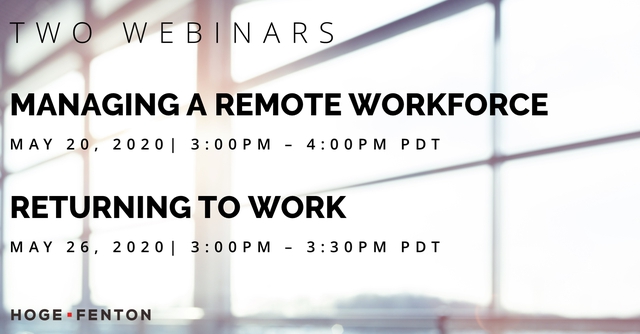
Get More Information and Register for these Valuable Webinars:
- Webinar 1: May 20th, 3:00-4:00pm: Managing a Remote Workforce
- Webinar 2: May 26th, 3:00-3:30pm: Returning to Work
As the situation with the COVID-19 pandemic and resulting shelter-in-place orders continues to shift, employers are evaluating when, how, and if they should return their employees back to the workplace. With that decision, employers must evaluate a number of issues to ensure their employees’ safety and limit employer liability, whether employees return to work or work from home.
Managing a remote workforce comes with its own challenges. With the unexpected shift to working from home when the shelter-in-place orders went into effect, most employers did not have time to consider the risks and to put safeguards in place. However, as remote working becomes an ongoing and potentially long-term option, employers should take the time to consider the following:
- Have you taken sufficient security measures to protect the company’s confidential information and other private information? How do your employees ensure that their new “coworkers” (e.g., roommates, spouses, children) do not have access to your confidential information?
- How are you tracking and paying non-exempt employees for their time? Are non-exempt employees taking meal and rest breaks, working overtime, working off-the-clock? And if employees take breaks in the middle of the day to home school their children, do you owe a split shift premium?
- What are necessary and reasonable business expenses for which you must reimburse your employees? Are you required to reimburse your employees for home internet and cell phones? What about home office space, increased utility costs, light bulbs, soap, and toilet paper?
- Have you complied with municipal ordinances (e.g., paid sick leave, minimum wage) in effect where your employees are working?
- If your employee slips and falls in their kitchen while making their lunch, is that covered by workers’ compensation?
- If you have to terminate the employment relationship, how do you ensure you pay final wages timely?
With respect to returning to work, employers must consider a different host of issues, including:
- How do you determine who must come back to work and avoid discrimination claims? Can you prohibit high-risk employees from returning to work?
- Can and should you test employees and/or take their temperature and monitor their symptoms?
- How do you ensure employee safety?
- Must you accommodate employees who cannot return to work because their childcare providers are not available?
- Can you require employees to return to work or terminate them for refusing to return to work if they are scared, nervous, or anxious about contracting COVID-19?
- What are your obligations if an employee contracts COVID-19 at work? Is this covered by workers’ compensation?
Hoge Fenton’s Employment Law team will host a two-part webinar series to cover these issues:
- Webinar 1: May 20th, 3:00-4:00pm: Managing a Remote Workforce
- Webinar 2: May 26th, 3:00-3:30pm: Returning to Work
Click below to register for each webinar:
Please reach out to our advisors below if you need more guidance or visit our COVID-19 Resources page.
 |
 |
 |
|
Chair & Shareholder
+1.408.947.2456
|
Shareholder
+1.408.947.2435
|
Attorney
+1.408.947.2457
|
This information is provided as an educational service by Hoge Fenton for clients and friends of the firm. This communique is an overview only, and should not be construed as legal advice or advice to take any specific action. Please be sure to consult a knowledgeable professional with assistance with your particular legal issue. © 2020 Hoge Fenton
05.05.2020 | Firm Post

A Glimpse of Guidance on PPP Loan Forgiveness
For those employers fortunate enough to secure PPP loans, the big question remains how to ensure full loan forgiveness. With lingering questions, such as how to count “FTEs,” and will headcount be considered “reduced” if an employee takes a leave of absence or quits during the 8-week covered period, the Department of Treasury has offered little by way of clarity on the loan forgiveness component of the PPP thus far, but promises that guidance is on the way. That said, on Sunday night, May 3, 2020, the Small Business Administration (SBA), in consultation with the Treasury, added guidance to its PPP FAQs on the issue of whether employers’ loan forgiveness will be reduced if a laid-off employee declines an offer of re-employment. Specifically, FAQ #40 provides:
Question: Will a borrower’s PPP loan forgiveness amount (pursuant to section 1106 of the CARES Act and SBA’s implementing rules and guidance) be reduced if the borrower laid off an employee, offered to rehire the same employee, but the employee declined the offer?
Answer: No. As an exercise of the Administrator’s and the Secretary’s authority under Section 1106(d)(6) of the CARES Act to prescribe regulations granting de minimis exemptions from the Act’s limits on loan forgiveness, SBA and Treasury intend to issue an interim final rule excluding laid-off employees whom the borrower offered to rehire (for the same salary/wages and same number of hours) from the CARES Act’s loan forgiveness reduction calculation. The interim final rule will specify that, to qualify for this exception, the borrower must have made a good faith, written offer of rehire, and the employee’s rejection of that offer must be documented by the borrower. Employees and employers should be aware that employees who reject offers of re-employment may forfeit eligibility for continued unemployment compensation.
In an unprecedented era where many employers are competing against increased unemployment insurance benefits (employees are eligible for $600 per week more than normal), the SBA’s guidance is positive news for employers because it means two things: (1) if employees decline to return to work, it will not reduce the employer’s loan forgiveness under the PPP, and (2) employees are incentivized to return to work because declining work will likely render them ineligible for unemployment insurance benefits.
We look forward to further guidance on PPP loan forgiveness and will continue to keep our clients and friends of the firm informed. For now, click here for the SBA’s most recent set of FAQs (from May 3, 2020) on the Paycheck Protection Program.
If you have any additional questions, please contact Sarju Naran.
 |
|
Shareholder/Chair
Employment Law
+1.408.947.2456
|
This information is provided as an educational service by Hoge Fenton for clients and friends of the firm. This communique is an overview only, and should not be construed as legal advice or advice to take any specific action. Please be sure to consult a knowledgeable professional with assistance with your particular legal issue. © 2020 Hoge Fenton
05.01.2020 | Speaking Engagements & Firm Events
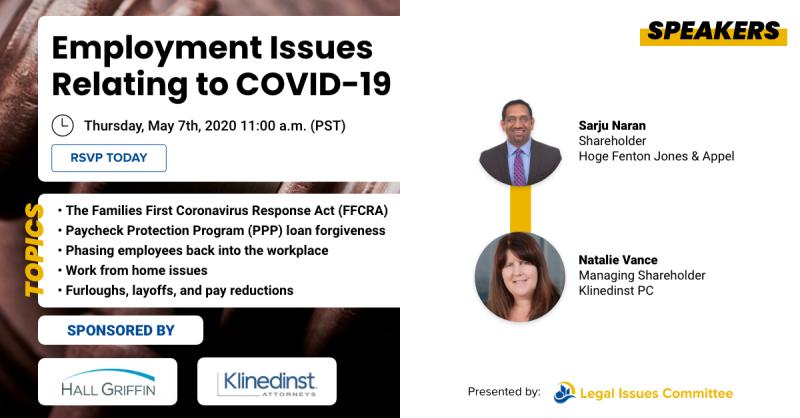
Free Webinar: Employment Issues Relating to COVID-19
04.24.2020 | Firm Post

 |
 |
 |
| Sarju Naran Hoge Fenton Shareholder/Chair Employment Law +1.408.947.2456 email here |
Steve Tessler California Bank of Commerce Executive VP +1.510.499.9509 email here |
Jenn Protas Hoge Fenton Shareholder Employment Law +1.408.947.2435 email here |
 |
 |
| Ray Scheaffer, CPA Abbott, Stringham & Lynch Principal +1.408.377.8700 email here |
Darlene Chiang Hoge Fenton Of Counsel Corporate & Bus Law +1.925.460.3367 email here |
04.24.2020 | Firm Post

COVID-19 Federal Aid Alternatives to PPP and EIDL
Although Congress passed another round of funding this week for the Paycheck Protection Program (PPP) and Economic Injury Disaster Loans (EIDLs), due to unprecedented need these programs will likely reach their capacity within a few weeks, if not days. There are, however, alternatives to the PPP and EIDL that are important to highlight.
Main Street Lending Program
The Federal Reserve (the “Fed”) established the Main Street Lending Program (the “Program”) to support lending to small and medium-sized businesses that were in good financial standing before the COVID-19 pandemic. The program operates through two arms: the Main Street New Loan Facility and the Main Street Expanded Loan Facility. While the Main Street Lending Facility process remains undefined, the following information is known about it :
- This program is offering loans of as little as $1 million and as much as $150 million to businesses with up to 10,000 employees or $2.5 billion in 2019 revenue.
- This is a $600 billion program.
- The Fed is expected to release additional guidance on the loan application and bank underwriting requirements shortly.
- Banks are not yet able to take applications.
Other Alternatives to the PPP and EIDL:
Here are two alternatives to the PPP and EIDL that may provide some assistance:
- The Employee Retention Credit (“ERC”)
- The ERC provides a refundable payroll tax credit for 50% of the wages paid by employers during the COVID-19 pandemic up to $5,000 per employee per quarter. This credit is applied to the employer’s quarterly tax liability reported on Form 941.
- An employer who receives a loan under the Paycheck Protection Program is ineligible for the ERC.
- Eligible employers must fall into one of two categories:
- The employer’s business is fully or partially suspended by government order due to COVID-19 during the calendar quarter (a “COVID-19 Related Closure”).
- The employer’s gross receipts are below 50% of the comparable quarter in 2019. Once the employer’s gross receipts go above 80% of a comparable quarter in 2019, they no longer qualify after the end of that quarter (a “COVID-19 Impact”).
- The ERC provides a refundable payroll tax credit for 50% of the wages paid by employers during the COVID-19 pandemic up to $5,000 per employee per quarter. This credit is applied to the employer’s quarterly tax liability reported on Form 941.
- The tax credit is provided for the first $10,000 of compensation paid to an employee and is based on qualified wages paid.
- For employers with more than 100 employees, “qualified wages” are all wages paid to only those employees who are being paid not to work. If employers with 100 or fewer employees, the credit is based on wages paid to all employees, regardless if they worked or not. If the employees worked full time and were paid for full time work, the employer still receives the credit.
- “Qualified wages” also include the employer’s contribution to health-insurance costs (subject to the cap of $10,000) but exclude any amounts already received as tax credit.
- No application is required for the ERC. Eligible employers simply claim a payroll credit against its 6.2% of Social Security tax equal to 50% of the qualified wages it paid during the applicable quarter.
- The refundable ERC is reported on the eligible employer’s return beginning in the second quarter for reporting its liability for Federal Insurance Contributions Act (“FICA”) and Railroad Retirement Tax Act, as applicable. For FICA tax purposes, the quarterly Form 941 is used for reporting for most employers.
- The Internal Revenue Service (“IRS”) does not require a business to wait until it files its payroll tax return to claim the ERC. Instead, eligible employers can be immediately reimbursed for the credit by reducing their required deposits of payroll taxes that have been withheld from employees’ wages by the amount of the credit. If the eligible employer’s employment tax deposits are not sufficient to cover the credit, the employer may receive an advance payment from the IRS by submitting Form 7200, Advance Payment of Employer Credits Due to COVID-19.
- The credit is claimed on a quarterly basis and is applicable to wages paid between March 13, 2020, and December 31, 2020, for any quarter the business suffered a COVID-19 Related Closure or a COVID-19 Impact.
- Employer Payroll Tax Deferral
- Employers can defer without penalty the deposit and payment of applicable employment taxes due for the rest of year.
- Fifty percent (50%) of the deferred taxes must be repaid by December 31, 2021, with the remaining due by December 31, 2022.
- “Applicable employment taxes” include the employer’s portion of the social security tax that would otherwise be required to be made from March 27 until December 31, 2020.
- Employers who receive a loan under the Paycheck Protection Program are not eligible for this payroll tax deferral once their loan is forgiven.
- Except for the limitation for employers who receive a loan under the Paycheck Protection Program, all employers are eligible for the payroll tax deferral.
If you have any questions about how these provisions of the CARES Act may apply to your business, please contact Hoge Fenton’s COVID-19 Rapid Response Team.
 |
 |
 |
| Embert Madison, Jr.
Attorney Corporate & Bus Law +1.925.460.3370 |
Darlene Chiang
Of Counsel Corporate & Bus Law +1.925.460.3367 |
Sarju Naran
Shareholder/Chair Employment Law +1.408.947.2456 |
This information is provided as an educational service by Hoge Fenton for clients and friends of the firm. This communique is an overview only, and should not be construed as legal advice or advice to take any specific action. Please be sure to consult a knowledgeable professional with assistance with your particular legal issue. © 2020 Hoge Fenton
04.16.2020 | Speaking Engagements & Firm Events
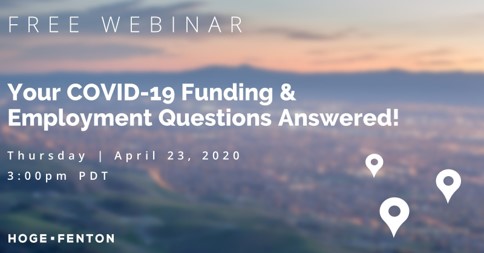
Join our trusted advisors at California Bank of Commerce, Abbott Stringham & Lynch CPAs, and Hoge Fenton as they provide a “Situation Room” update and answer your questions about COVID-19 funding and employment law issues.
In this exclusive complimentary webinar, our panel will discuss:
- The current status of PPP, EIDL, and other government loan programs
- Updates on federal, state, and local guidance for managing employee furloughs, FFCRA paid leave, and unemployment insurance benefits
- Tax strategies and implications of government programs
Meet our Trusted Advisors:
 |
 |
 |
| Sarju Naran Hoge Fenton Shareholder/Chair Employment Law +1.408.947.2456 email here |
Steve Tessler California Bank of Commerce Executive VP +1.510.499.9509 email here |
Jenn Protas Hoge Fenton Shareholder Employment Law +1.408.947.2435 email here |
 |
 |
| Ray Scheaffer, CPA Abbott, Stringham & Lynch Principal +1.408.377.8700 email here |
Darlene Chiang Hoge Fenton Of Counsel Corporate & Bus Law +1.925.460.3367 email here |
This information is provided as an educational service by Hoge Fenton for clients and friends of the firm. This communique is an overview only, and should not be construed as legal advice or advice to take any specific action. Please be sure to consult a knowledgeable professional with assistance with your particular legal issue. © 2020 Hoge Fenton
04.10.2020 | Firm Post
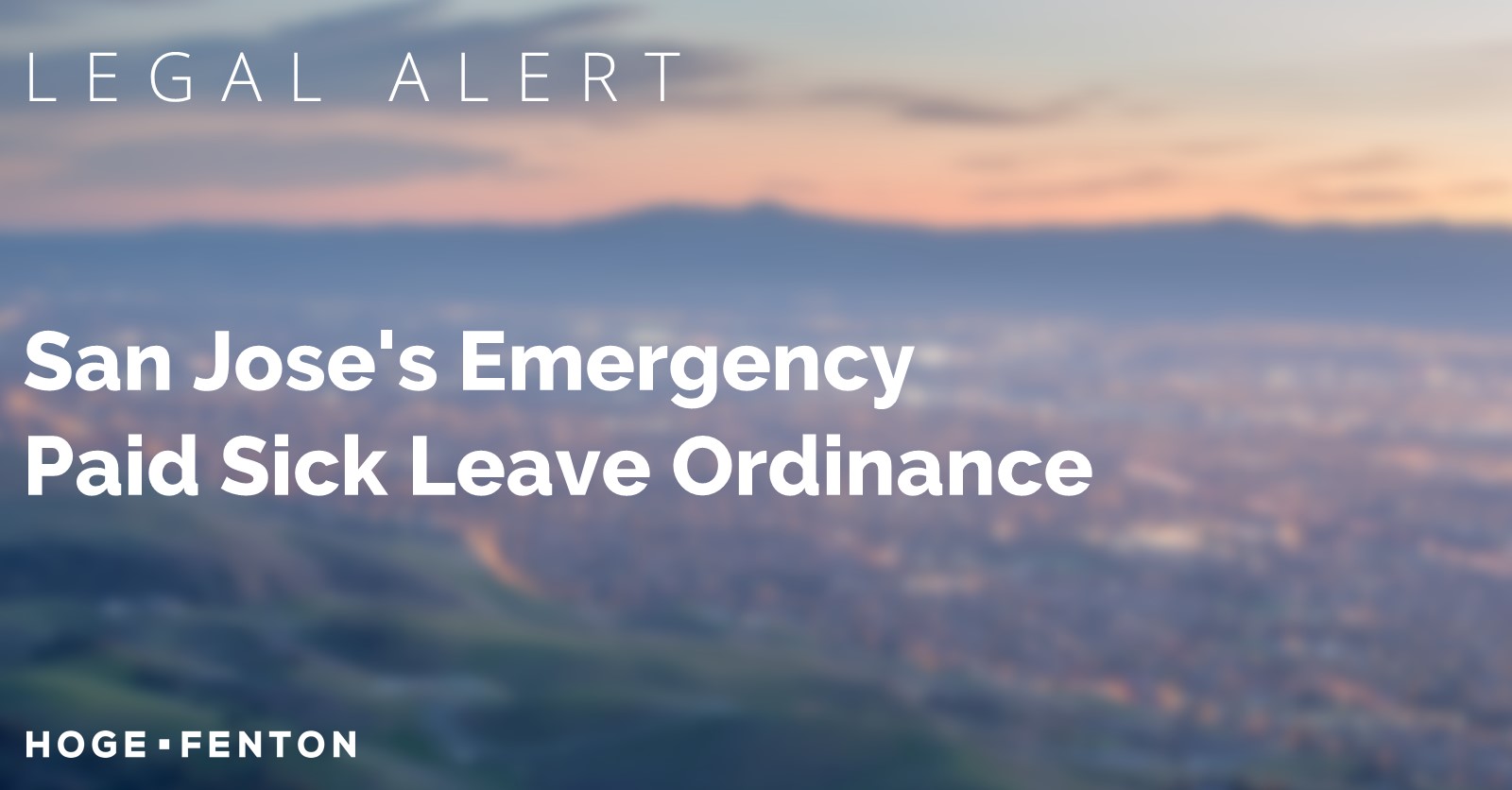
On April 7, 2020, the San Jose City Council enacted the “COVID-19 Paid Sick Leave Ordinance” (the “Ordinance”). The Ordinance, which takes effect immediately, is meant to fill the gaps left by the federal Families First Coronavirus Response Act (“FFCRA”). The Ordinance requires employers that are not subject to the FFCRA’s Emergency Paid Sick Leave to provide employees who have worked at least 2 hours within the city with paid sick leave benefits if the employee cannot work for any of the following reasons:
- The employee is subject to quarantine or isolation by federal, state, or local order due to COVID-19, or is caring for someone who is quarantined or isolated due to COVID-19;
- The employee is advised by a health care provider to self-quarantine due to COVID-19 or is caring for someone who is so advised;
- The employee experiences symptoms of COVID-19 and is seeking a medical diagnosis;
- The employee is caring for a minor child because a school or daycare is closed due to COVID-19.
Sick Leave Details:
- Full-time employees are entitled to 80 hours of paid sick leave.
- Part-time employees are entitled to sick leave hours equal to the number of hours worked on average over a two-week period (using the average number of hours the employee worked per day between November 8, 2019 and April 7, 2020).
- If an employee uses paid sick leave for themselves, they shall be paid their regular rate of pay up to $511.00 per day, not to exceed an aggregate of $5,110.00.
- If the employee is using sick time to care for another person, they may be paid at two-thirds of their regular rate of pay up to $200.00 per day, not to exceed an aggregate of $2,000.00.
- Paid sick leave benefits are available for an employee to use immediately.
The Ordinance does contain a few notable exemptions:
- First, the Ordinance does not apply to employees who can work from home.
- Second, if an employer already provides employees with paid personal leave equivalent to the paid sick time required by the Ordinance, they need not provide additional paid sick leave. To the extent that there is a differential between what the employer provides and what is required by the Ordinance, the employer need only provide paid sick leave in the amount of that differential.
- Finally, the Ordinance gives employers that are hospitals two weeks from the Ordinance’s effective date (April 7, 2020) to comply with its requirements.
The FFCRA’s Emergency Paid Sick Leave exempts employers with more than 500 employees, authorizes the Department of Labor to exempt businesses with less than 50 employees if doing so would jeopardize the viability of the business, and authorizes an employer to elect not to provide the benefit to employees who are health care providers or emergency first responders. Such exemptions do not exist in the Ordinance.
Unlike the FFCRA’s Emergency Paid Sick Leave, the Ordinance does not mention tax credits. Thus, although small businesses with less than 50 employees may claim an exemption from the FFCRA, businesses should reconsider doing so because, pursuant to the Ordinance, small businesses will still be required to provide paid sick leave but may be deprived of claiming any tax credits.
The Ordinance is in effect until December 31, 2020.
For additional legal information regarding COVID-19, please visit our COVID-19 Resources website .
Hoge Fenton’s Employment Law team is here to provide you with additional support throughout the COVID-19 pandemic. Please contact any of us below.
 |
 |
 |
|
Chair & Shareholder
+1.408.947.2456
|
Shareholder
+1.408.947.2435
|
Attorney
+1.408.947.2457
|
This information is provided as an educational service by Hoge Fenton for clients and friends of the firm. This communique is an overview only, and should not be construed as legal advice or advice to take any specific action. Please be sure to consult a knowledgeable professional with assistance with your particular legal issue. © 2020 Hoge Fenton
04.09.2020 | Firm Post
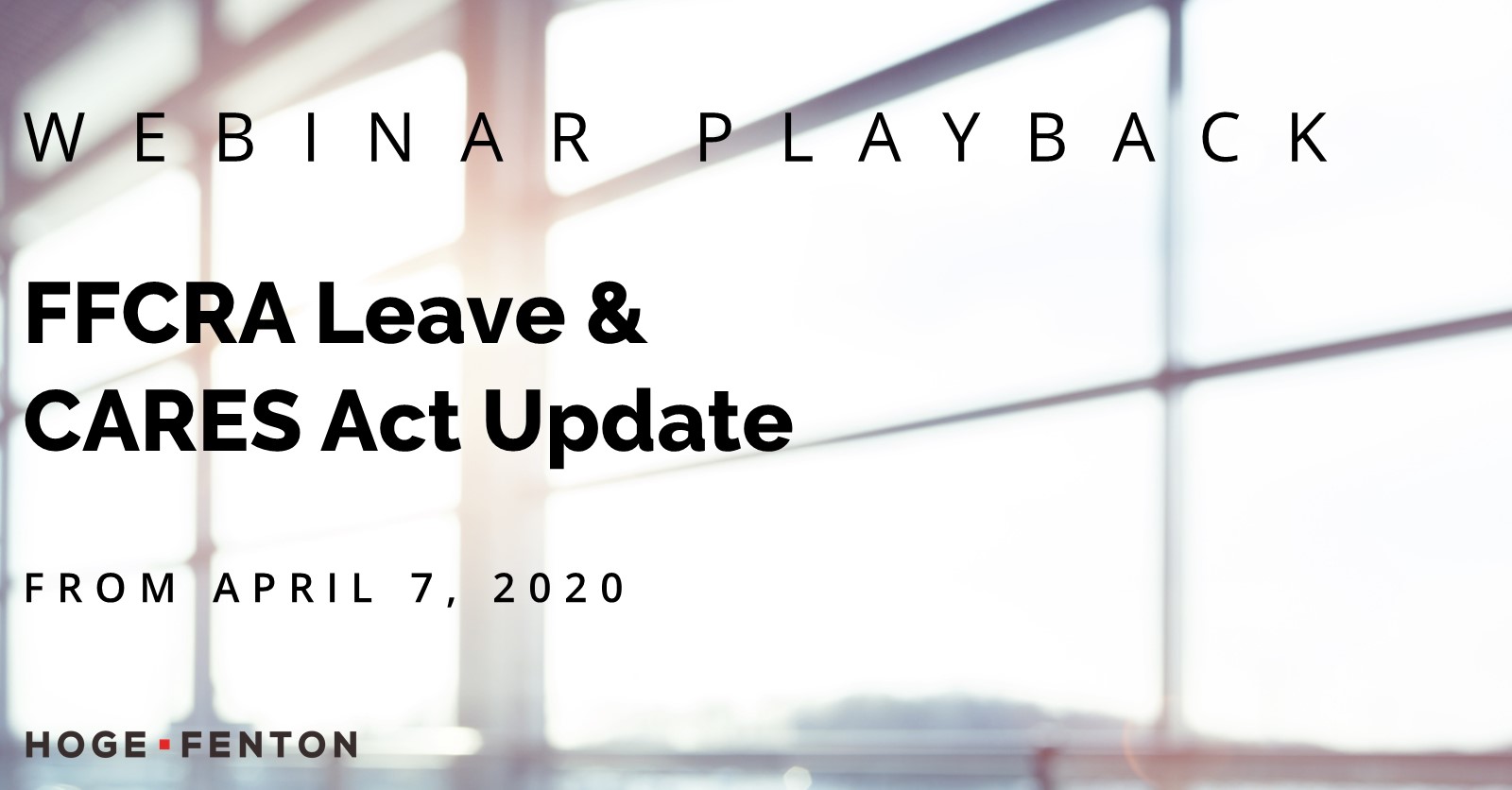
Thank you to everyone who joined us for our Families First Coronavirus Response Act (“FFCRA”) Leave and the Coronavirus Aid, Relief and Economic Security Act (“CARES Act”) Webinar last Tuesday.
Please find the recording of the webinar below.
We hope you found the discussion helpful. Please reach out to our advisors below if you need more guidance and visit our COVID-19 Resources page for additional support.
Our Trusted Silicon Valley Advisors
 |
 |
 |
|
Chair/Shareholder
Employment Law
+1.408.947.2456
|
Shareholder
Employment Law
+1.408.947.2435
|
Of Counsel
Corporate & Business Law
+1.925.460.3367
|
This information is provided as an educational service by Hoge Fenton for clients and friends of the firm. This communique is an overview only, and should not be construed as legal advice or advice to take any specific action. Please be sure to consult a knowledgeable professional with assistance with your particular legal issue. © 2020 Hoge Fenton
04.03.2020 | Speaking Engagement & Firm Events
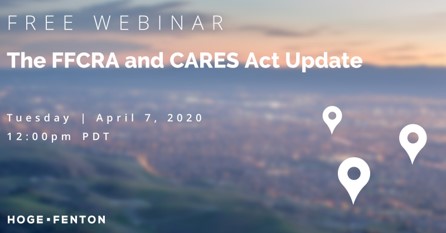
We are hosting a complimentary webinar on these laws
Tuesday, April 7 at 12:00pm
Register here
As discussed in our recent articles the federal government has passed two monumental acts of legislation to address the COVID-19 pandemic: the Families First Coronavirus Response Act (“ FFCRA ”) and the Coronavirus Aid, Relief and Economic Security Act (“ CARES Act ”). The federal departments have now issued regulations and guidance on both the FFCRA and the CARES Act to assist employers in interpreting and applying the new laws to their workplace.
Please join Hoge Fenton’s team for a complimentary webinar on Tuesday, April 7, 2020 at 12:00pm, where we will discuss and answer questions regarding these new laws, regulations, and guidance.
![]()
Hoge Fenton’s team is standing by to help you retain your employees and serve your customers during the COVID-19 pandemic. Please do not hesitate to contact any of us below, and click here to join us for Tuesday’s webinar.
 |
 |
 |
|
Chair/Shareholder
Employment Law
+1.408.947.2456
|
Shareholder
Employment Law
+1.408.947.2435
|
Of Counsel
Corporate & Business Law
+1.925.460.3367
|
This information is provided as an educational service by Hoge Fenton for clients and friends of the firm. This communique is an overview only, and should not be construed as legal advice or advice to take any specific action. Please be sure to consult a knowledgeable professional with assistance with your particular legal issue. © 2020 Hoge Fenton
04.02.2020 | Firm Post

DOL Issues Temporary Regulations for the Families First Coronavirus Response Act
On April 1, the day the Families First Coronavirus Response Act (“FFCRA” or the “Act”) went into effect, the U.S. Department of Labor (“DOL”) issued temporary regulations for the Act. The regulations answer a number of questions regarding the interpretation of the FFCRA.
Of particular note, the regulations interpret “quarantine or isolation orders” to include “a broad range of governmental orders, including orders that advise some or all citizens to shelter in place, stay at home, quarantine, or otherwise restrict their own mobility.” That being said, if a business closes because of a shelter in place order, either because its customers are required to stay at home or because the order forced the business to close, and the employee cannot telework, the employee is not eligible for paid sick leave under the Act (because the reason the employee cannot work is because the business was subject to the order, not because the employee was subject to the order).
The regulations also provide clarifications and interpretations of the Act, including:
- The definition of “son or daughter” under both the paid sick leave and expanded FMLA leave includes adult children who are incapable of self-care due to a mental or physical disability. (This represents a change of the language of the FFCRA to effectuate consistency between the provisions.)
- Employers are not required to compensate for unreported hours worked while teleworking unless they knew or should have known the hours were worked.
- FFCRA sick leave may be taken if the employee is advised by a health care provider to self-quarantine because the employee has, may have, or is “particularly vulnerable” to COVID-19.
- If the employee is taking FFCRA sick leave because the employee is experiencing symptoms and awaiting a diagnosis, the leave may be taken only for the time spent making, waiting for, and attending the appointment for diagnosis. If the employee is unable to telework, the time may also be taken while awaiting results.
- The unpaid portion of the expanded FMLA leave applies to two weeks, not 10 days.
- Employees are only qualified to take FFCRA leave to care for a child whose school or place of care has closed, or whose childcare provider is unavailable, if there is no other suitable person available to care for the child.
- Intermittent leave may be agreed to by the employee and employer, including the increments of time the leave may be taken. Intermittent leave is available for all qualifying sick leave and expanded FMLA purposes if an employee is teleworking. If an employee is working at the worksite, intermittent leave may only be agreed to if the leave is to care for a child whose school or childcare is unavailable.
- Employees must provide their employer documentation in support of the need for FFCRA leave, including a signed statement with the following information: (1) the employee’s name; (2) the date(s) for which leave is requested; (3) the COVID-19 qualifying reason for leave; and (4) a statement representing that the employee is unable to work or telework because of the COVID-19 qualifying reason. The employee must provide additional documentation depending on the qualifying reason for leave:
- If based on an quarantine or isolation order, the employee must provide the name of the government entity that issued the order.
- If based on a health care provider’s advice for the employee or a family member to self-quarantine, the employee must provide the name of the health care provider.
- If based on caring for a child without school or childcare, the employee must provide:
- The name of the child being cared for
- The name of the school, place of care, or child care provider that closed or became unavailable due to COVID-19 reasons
- A statement representing that no other suitable person is available to care for the child during the period of requested leave
For additional legal information regarding COVID-19, please visit our COVID-19 Resources website.
Hoge Fenton’s Employment Law team is here to provide you with additional support throughout the COVID-19 pandemic. Please feel free to contact any of us below.
 |
 |
 |
|
Chair & Shareholder
+1.408.947.2456
|
Shareholder
+1.408.947.2435
|
Attorney
+1.408.947.2457
|
This information is provided as an educational service by Hoge Fenton for clients and friends of the firm. This communique is an overview only, and should not be construed as legal advice or advice to take any specific action. Please be sure to consult a knowledgeable professional with assistance with your particular legal issue. © 2020 Hoge Fenton
03.31.2020 | Firm Post

More DOL Guidance for Employers Regarding FFCRA Paid Leave Benefits for COVID-19
As described in Hoge Fenton’s recent article and webinar, Congress has created two new forms of paid leave benefits that will go into effect on April 1, 2020 for employees who need time off for qualifying reasons due to COVID-19. The U.S. Department of Labor has now issued its third round of guidance on the new law, including the much-anticipated small employer exemption (see the question and answer below):
When does the small business exemption apply to exclude a small business from the provisions of the Emergency Paid Sick Leave Act and Emergency Family and Medical Leave Expansion Act?
An employer, including a religious or nonprofit organization, with fewer than 50 employees (small business) is exempt from providing (a) paid sick leave due to school or place of care closures or child care provider unavailability for COVID-19 related reasons and (b) expanded family and medical leave due to school or place of care closures or child care provider unavailability for COVID-19 related reasons when doing so would jeopardize the viability of the small business as a going concern. A small business may claim this exemption if an authorized officer of the business has determined that:
- The provision of paid sick leave or expanded family and medical leave would result in the small business’s expenses and financial obligations exceeding available business revenues and cause the small business to cease operating at a minimal capacity;
- The absence of the employee or employees requesting paid sick leave or expanded family and medical leave would entail a substantial risk to the financial health or operational capabilities of the small business because of their specialized skills, knowledge of the business, or responsibilities; or
- There are not sufficient workers who are able, willing, and qualified, and who will be available at the time and place needed, to perform the labor or services provided by the employee or employees requesting paid sick leave or expanded family and medical leave, and these labor or services are needed for the small business to operate at a minimal capacity.
The FAQ also provides additional guidance regarding:
- Exemptions for healthcare providers and emergency responders
- Definitions, including “employee,” “son or daughter,” and “health care provider” for purposes of determining individuals whose advice to self-quarantine can be relied upon for paid sick leave
- Confirming that the employee count for purposes of determining employer eligibility is determined on the day the employee’s leave would start
- Confirming that expanded FMLA leave does not entitle an employee to take more than 12 workweeks of FMLA leave within a 12-month period
- Reinstatement rights
- Rights of public sector employees
- Documentation employers should maintain to see FFCRA refundable tax credits
- Advice to employees regarding enforcement measures
For additional legal information regarding COVID-19, please visit our COVID-19 Resources website .
Hoge Fenton’s Employment Law team is here to provide you with additional support throughout the COVID-19 pandemic. Please feel free to contact any of us below.
 |
 |
 |
|
Chair & Shareholder
+1.408.947.2456
|
Shareholder
+1.408.947.2435
|
Attorney
+1.408.947.2457
|
This information is provided as an educational service by Hoge Fenton for clients and friends of the firm. This communique is an overview only, and should not be construed as legal advice or advice to take any specific action. Please be sure to consult a knowledgeable professional with assistance with your particular legal issue. © 2020 Hoge Fenton
03.27.2020 | Firm Post
COVID-19 Coping Strategies and Insights for Small & Medium-Sized Businesses
COVID-19 poses evolving challenges for all employers, especially start-ups, small, and medium-sized businesses so vital to our Tri-Valley ecosystem. We have assembled a panel of our trusted regional advisors to provide guidance and answer your questions. This complementary webinar is presented by Hoge Fenton and Sensiba San Filippo, in partnership with iGATE and Innovation Tri-Valley Leadership Group.
Tri-Valley advisors will take your questions and address urgent issues including:
- What are the best strategies for helping my business survive a big pause in revenue while treating my employees well, especially the ones we might have to let go?
- How can I take advantage of unemployment benefits and other government programs?
- Could we restructure our small businesses to make sure employees have unemployment benefits if we have to lay people off?
- Are options like moving to an employee-owned business a bad idea because it removes benefits for the employees?
- Are there creative business solutions to keep our talent even if business drops off?
Please share this webinar information with any business leaders who may find this information helpful.
For more information please call:
Lynn Naylor
Innovation Tri-Valley Leadership Group
925.989.0188
Meet our Trusted Tri-Valley Advisors:
 |
 |
|
Speaker
EMP Law Attorney
+1.408.947.2435
|
Moderator
Executive Director
+1.925.231.2333
|
 |
 |
|
Speaker
Corporate Attorney
+1.925.460.3367
|
Speaker
Managing Partner
+1.925.271.8700
|
This information is provided as an educational service by Hoge Fenton for clients and friends of the firm. This communique is an overview only, and should not be construed as legal advice or advice to take any specific action. Please be sure to consult a knowledgeable professional with assistance with your particular legal issue. © 2020 Hoge Fenton
03.27.2020 | Firm Post

DOL Issues Second Round of Guidance for Employers Regarding the Families First Coronavirus Response Act
As described in Hoge Fenton’s recent article and webinar, Congress has created two new forms of paid leave benefits that will go into effect on April 1, 2020 for employees who need time off for qualifying reasons due to COVID-19. The U.S. Department of Labor has now issued further guidance on the new law, including:
- Intermittent use of FFCRA paid leave
- Confirming that “shelter in place” orders are not a qualifying reason to use FFCRA paid leave
- Documentation employers should obtain from employees in order to secure tax credits when employees use FFCRA leave
- Calculating “regular rate of pay” for employees with fluctuating compensation
- Employees’ ineligibility to use FFCRA paid leave during office closures or furloughs, or for reduced hours
- Employers ability to allow employees to coordinate other paid leave benefits with FFCRA paid leave in order to receive full pay while on FFCRA leave
Click here to see the DOL’s full list of FAQs and guidance. The DOL has also issued a model notice that employers are required to post, along with FAQs regarding the posting requirements.
For additional legal information regarding COVID-19, please visit our COVID-19 Resources website .
Hoge Fenton’s Employment Law team is here to provide you with additional support throughout the COVID-19 pandemic. Please feel free to contact any of us below.
 |
 |
 |
|
Chair & Shareholder
+1.408.947.2456
|
Shareholder
+1.408.947.2435
|
Attorney
+1.408.947.2457
|
This information is provided as an educational service by Hoge Fenton for clients and friends of the firm. This communique is an overview only, and should not be construed as legal advice or advice to take any specific action. Please be sure to consult a knowledgeable professional with assistance with your particular legal issue. © 2020 Hoge Fenton
03.25.2020 | Firm Post

New U.S. DOL Guidance for Employers Regarding the Families First Coronavirus Response Act, Which Will Go Into Effect April 1, 2020
As discussed in Hoge Fenton’s article last Thursday, March 20th (click here) and webinar last Friday, March 21 st (click here), Congress has created two new forms of paid leave benefits for employees who need time off for qualifying reasons due to COVID-19. The U.S. Department of Labor has now issued clarifications and guidance on the new law, and further guidance is expected in the coming days.
Click here to see the full list of FAQs and the DOL’s expanded guidance. The DOL has also issued its FFCRA model notice that employers are required to post, along with FAQs regarding the posting requirements.
Here is an abbreviated summary of a few of the questions that have been answered:
What is the effective date of the Families First Coronavirus Response Act (FFCRA)?
The FFCRA will become effective on April 1, 2020, and will apply to leaves taken between April 1, 2020, and December 31, 2020.
How do I know if my business is under the 500-employee threshold and therefore must provide paid sick leave or expanded family and medical leave?
You have fewer than 500 employees if, at the time the employee takes the leave, you employ fewer than 500 full-time and part-time employees within the U.S., including employees on leave, temps who are jointly employed by you and another employer (regardless of whether they are on another employer’s payroll, so including temps through an agency), and day laborers supplied by a temp agency. Where a corporation has an ownership interest in another corporation, the two corporations are separate employers unless they are joint employers pursuant to the “integrated employer test” under the FLSA.
If I have fewer than 50 employees and complying with the FFCRA would jeopardize the viability of my business, how do I take advantage of the small business exemption?
For now, you should document why your business meets the criteria set forth by the Department of Labor, which will be addressed in more detail in forthcoming regulations. In the meantime, you should not send any materials to the Department of Labor when seeking a small business exemption.
When calculating pay due to employees, must overtime hours be included?
Yes. The Emergency FMLA Expansion Act requires you to pay for hours the employee would have been normally scheduled to work even if that’s more than 40 hours in a week. However, the Emergency Paid Sick Leave Act requires that paid sick leave be paid only up to 80 hours over a two-week period. For example, an employee who is scheduled to work 50 hours a week may take 50 hours of paid sick leave in the first week and 30 hours of paid sick leave in the second week. In any event, the total number of hours paid under the Emergency Paid Sick Leave Act is capped at 80. Importantly, while all overtime hours must be counted, the pay does not need to include a premium for overtime hours.
Again, please note that this is a summary only. The DOL’s FAQs page answers additional questions and expands on the information provided above.
Hoge Fenton’s Employment Law team is here to provide you with additional support throughout the COVID-19 pandemic. Please feel free to contact any of us below.
 |
 |
 |
|
Chair & Shareholder
+1.408.947.2456
|
Shareholder
+1.408.947.2435
|
Attorney
+1.408.947.2457
|
This information is provided as an educational service by Hoge Fenton for clients and friends of the firm. This communique is an overview only, and should not be construed as legal advice or advice to take any specific action. Please be sure to consult a knowledgeable professional with assistance with your particular legal issue. © 2020 Hoge Fenton
03.20.2020 | Firm Post
March 18, 2020, President Trump signed the Families First Coronavirus Response Act (“FFCRA”), which will go into effect within the next 14 days. Among other provisions pertaining to food assistance and COVID-19 testing, the FFCRA creates two new forms of paid leave benefits for employees impacted by the COVID-19 pandemic: 1) emergency paid sick leave, and 2) expansion of the Family Medical Leave Act.
All employers with fewer than 500 employees will be required to provide and pay for the cost of these benefits, and employers will be reimbursed through tax credits. Employers’ obligations will be as follows:
Paid Sick Leave
Employers must provide all employees (regardless of tenure) with up to 10 days of paid sick leave if they are unable to work or telework for any of the following reasons:
- The employee is subject to a federal, state, or local quarantine or isolation order related to COVID-19;
- The employee is advised by a health care provider to self-quarantine due to concerns related to COVID-19;
- The employee is experiencing symptoms of COVID-19 and seeking a medical diagnosis;
- The employee is caring for an individual who is under a federal, state, or local quarantine or isolation order or who has been advised by a health care provider to self-quarantine;
- The employee is caring for a child whose school has been closed, or whose child provider is unavailable, due to COVID-19 precautions;
- The employee is experiencing any other substantially similar condition specified by the Secretary of Health and Human Services in consultation with the Secretary of the Treasury and the Secretary of Labor.
This leave entitlement is in addition to any existing paid leave policies employers have in place, and employees are entitled to use FFCRA paid sick leave before using any other paid leave (e.g., vacation, PTO, California paid sick time).
If an employee uses COVID-19 paid sick leave for the first three reasons identified above, the employee must be paid their regular rate of pay, up to a maximum of $511 per day or $5,110 in the aggregate. If an employee uses COVID-19 paid sick leave for reasons 4, 5, or 6 above, they must be paid at least 2/3 of their regular rate of pay, up to a maximum of $200 per day or $2,000 in the aggregate.
The Secretary of Labor has the authority to issue regulations exempting small businesses with fewer than 50 employees when the imposition would jeopardize the viability of the business as a going concern, but no such exemption has been issued as of yet. Employers of health care providers and emergency responders are permitted to exclude employees from this law.
FFCRA paid sick leave is set to expire on December 31, 2020, and unused paid sick leave will not carry over from year to year, nor be paid out upon termination of employment.
The Secretary of Labor is tasked with publishing a model notice regarding this temporary paid sick leave law within 7 days of the FFCRA being enacted, which employers will be required to post in the workplace.
Expansion of Family Medical Leave Act
Also through December 31, 2020, the Family and Medical Leave Act (“FMLA”) will be temporary expanded to allow employees leave of up to 12 weeks to be used for a “qualifying need” related to an emergency with respect to COVID-19, as declared by federal, state, or local authorities.
A “qualifying need” occurs when employees are unable to work or telework due to the need to care for their child whose school has been closed, or whose child provider is unavailable, due to COVID-19 concerns. Employees are eligible for the expanded FMLA leave if they have been employed for at least 30 calendar days.
FMLA leave is generally unpaid. If an employee takes leave under this temporary provision, however, the first 2 weeks of leave may be unpaid, and the employer must provide paid leave for up to 10 weeks thereafter. An employee may (but cannot be required to) use accrued vacation or sick leave during the initial unpaid two weeks, and thereafter, must be paid at least 2/3 of the employee’s regular rate of pay, up to a maximum of $200 per day or $10,000 in the aggregate.
Employees are entitled to reinstatement to the same or equivalent position upon exhausting their FMLA leave under this provision, except no reinstatement is required if the employer has fewer than 25 employees, and the following conditions are met (1) the employee’s no longer exists due to economic conditions or other operating conditions caused by COVID-19, (2) the employer has reasonably attempted to restore the employee to an equivalent position, and (3) if reasonable efforts fail, the employer must make reasonable efforts for one year to contact the employee if an equivalent position becomes available.
The Secretary of Labor has the authority to issue regulations exempting small businesses with fewer than 50 employees when the imposition would jeopardize the viability of the business as a going concern, but no such exemption has been issued as of yet. Employers of health care providers and emergency responders are permitted to exclude employees from this law.
Employers should be mindful that the unique eligibility requirements, and the paid component of, this expanded FMLA provision do not impact the existing provisions of FMLA, and are specific to address the COVID-19 pandemic.
Hoge Fenton’s Employment Law team is standing by to help you retain your employees and serve your customers during the COVID-19 pandemic. Please do not hesitate to contact any of us below.
 |
 |
 |
|
Chair & Shareholder
+1.408.947.2456
|
Shareholder
+1.408.947.2435
|
Attorney
+1.408.947.2457
|
This information is provided as an educational service by Hoge Fenton for clients and friends of the firm. This communique is an overview only, and should not be construed as legal advice or advice to take any specific action. Please be sure to consult a knowledgeable professional with assistance with your particular legal issue. © 2020 Hoge Fenton



